Newport Takes a Bow
Newport Takes a Bow
Newport Takes a Bow
Farewell to tradition and chaos in Rhode Island.
Farewell to tradition and chaos in Rhode Island.
By Ben Rothenberg
July 18, 2024
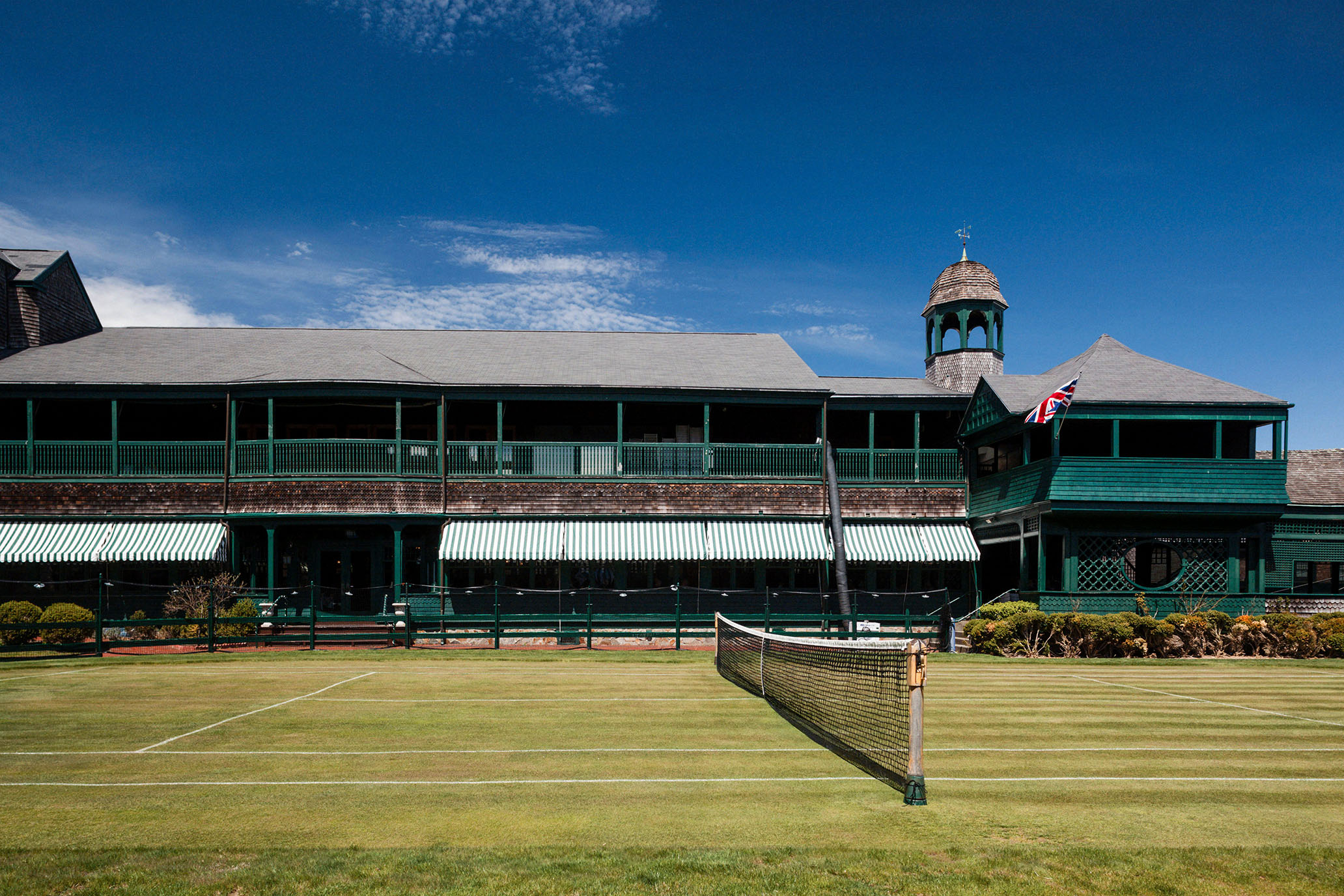
Newport Casino now. // Alamy

Newport Casino now then (below). // Alamy
The ATP Tour is losing some texture after this week, lumpy and patchy though it may be.
A casualty of the tour making its biggest events even bigger, this week marks the final edition of the Hall of Fame Open in Newport, R.I., as a tournament on the ATP Tour. Held on the grounds of the International Tennis Hall of Fame at the Newport Casino, which hosted the first U.S. National Lawn Tennis Championships in 1881, the tournament is the lone grass event in North America and the only one after Wimbledon. It’s annually a unique mix of tradition and chaos, producing strange bounces and unexpected champions since 1976.
“Littered with crazy bounces and kind of just a wacky tournament in the sense that anything can happen; that’s the mentality that the players took,” four-time champion John Isner said in an interview this week.
The bounces haven’t been quite so bad in Newport since a 2019 renovation of their grass courts, but the tournament’s reputation as an oddball full of crazy caroms and reliably random results has remained, with a patchy field by ATP standards that has led to many less-established players earning the best results of their careers.
Rajeev Ram, who earned the nickname “Rampras” for his throwback style of serve-and-volley play, won his only two ATP titles in Newport, in 2009 and 2015. Bryan Shelton, father of current top-20 pro Ben Shelton, also won his only two ATP titles in Newport, in 1991 and 1992.
Prakash Amritraj, a Tennis Channel host whom most viewers probably don’t realize was a tour player himself, made his lone ATP final in Newport in 2008; Prakash’s father, Vijay Amritraj, who will be inducted into the Tennis Hall of Fame this weekend in Newport, won the tournament three times.
Tim Smyczek, whom most fans would likely best remember for a match in the second round of the 2015 Australian Open where he led Rafael Nadal two sets to one, was a fixture at Newport in the 2010s. With a career-high ranking of 68th, Smyczek played in 85 ATP main draws over the course of his career and reached only one semifinal in those events, at Newport in 2018. Three of the eight wins Smyczek had over top-50 players in his career at ATP events came in Newport, including a win over top-seeded Sam Querrey in 2013.
“Over the years I was going there, you did see a lot of upsets,” Smyczek said in an interview this week. “I had some of my better wins while I was there. And it probably had a little something to do with the court and the unsteady footing, surprise bounces, that sort of thing. But I kind of liked it, because I was often the underdog in those matches, and I felt like you had to be pretty mentally tough to deal with all that throughout the course of the match or tournament.”
The winningest champion in Newport’s 48 years as an ATP tournament is Isner, who won four times—2011, 2012, 2017, 2019—each time as the top seed in one of the weakest ATP fields of the season (though Isner did beat a stronger field in 2012 when the London Olympics’ tennis event was being held on grass weeks later).
Newport had been the first ATP tournament of Isner’s career in the summer of 2007, after receiving a wild card following a successful collegiate career at the University of Georgia. It was not love at first mishit.
“I could not stand the courts,” Isner said. “I swore it off. I said I would never play Newport again because I couldn’t stand the courts. But lo and behold, I did not stay true to my conviction.”
Isner, whose serve was one of the toughest to return in ATP history, came to embrace that his game was even more unplayable with an unpredictable surface underfoot.
“The shittier the court, the better for me,” Isner said. “I mean, when I beat Federer at Davis Cup in Switzerland, it was a temporary clay court, indoors, and it was just littered with bad bounces. And that was a big advantage for me. [Newport] didn’t play like a typical grass court. Towards the end of the week, a kick serve would bounce crazy high on the courts; it wouldn’t necessarily skid. It just did not play like a typical grass court. I’ve always played a lot of smaller guys. I mean, I played [5-foot-6 Olivier] Rochus one year in the Newport finals, and he’s tiny and he couldn’t touch my serve at all.”
Ten of Isner’s 16 career ATP titles came in this stretch of the dog days of July, with four in Newport and six in Atlanta (a hard-court event with slightly stronger fields, which is also set to hold its final edition next week).
“The ‘Newport Challenger,’ for sure—I don’t take offense to that,” Isner said of the tournament’s common nickname among players. “But, you know, you look at it as an opportunity as well.”
Wins in Atlanta and Newport set Isner up for success when he’d encounter more of the game’s best once they came ashore for Washington, Cincinnati, and the US Open.
“I don’t care what surface you’re playing on,” Isner said. “On the ATP Tour, when you win four or five matches in a row to win the tournament, that’s going to give you a lot of confidence.”
Confidence can already be seen growing in this year’s field, including in Reilly Opelka, another enormous fellow with a huge serve, who is returning to the ATP Tour after two years away with injury and knocked off top seed and defending champion Adrian Mannarino in the second round.
Blair Henley, an on-court host at tournaments of all sizes around America including Newport, is an enthusiastic ambassador for the event, where she is working this week.
“I often get asked, ‘Which tournament should I go to if I’m going to pick one on the calendar?’” Henley said. “And I always will recommend a 250. If you can make it to Newport, I’d probably recommend this tournament. You get to be up close and personal in a way that you don’t experience at a 500 or 1000 or a Grand Slam. That piece, I think, is pretty consistent throughout all 250s. But here in Newport, I think when you add in the historic location, the quaint Northeastern town, the fact that the Hall of Fame is right there, I think there’s maybe even more of a sense of closeness.”
As the Hall of Fame undergoes major renovations later this year to prepare for big crowds expected for fast-approaching induction ceremonies of recently retired megastars like Roger Federer and Serena Williams, so too is the tournament being reimagined. Next year the event will reincarnate as a combined ATP-WTA Challenger event at the 125 level held during the second week of the Wimbledon main draw. The announcement Wednesday that women’s tennis would be reintroduced in Newport drew loud cheers from the crowd in Newport.
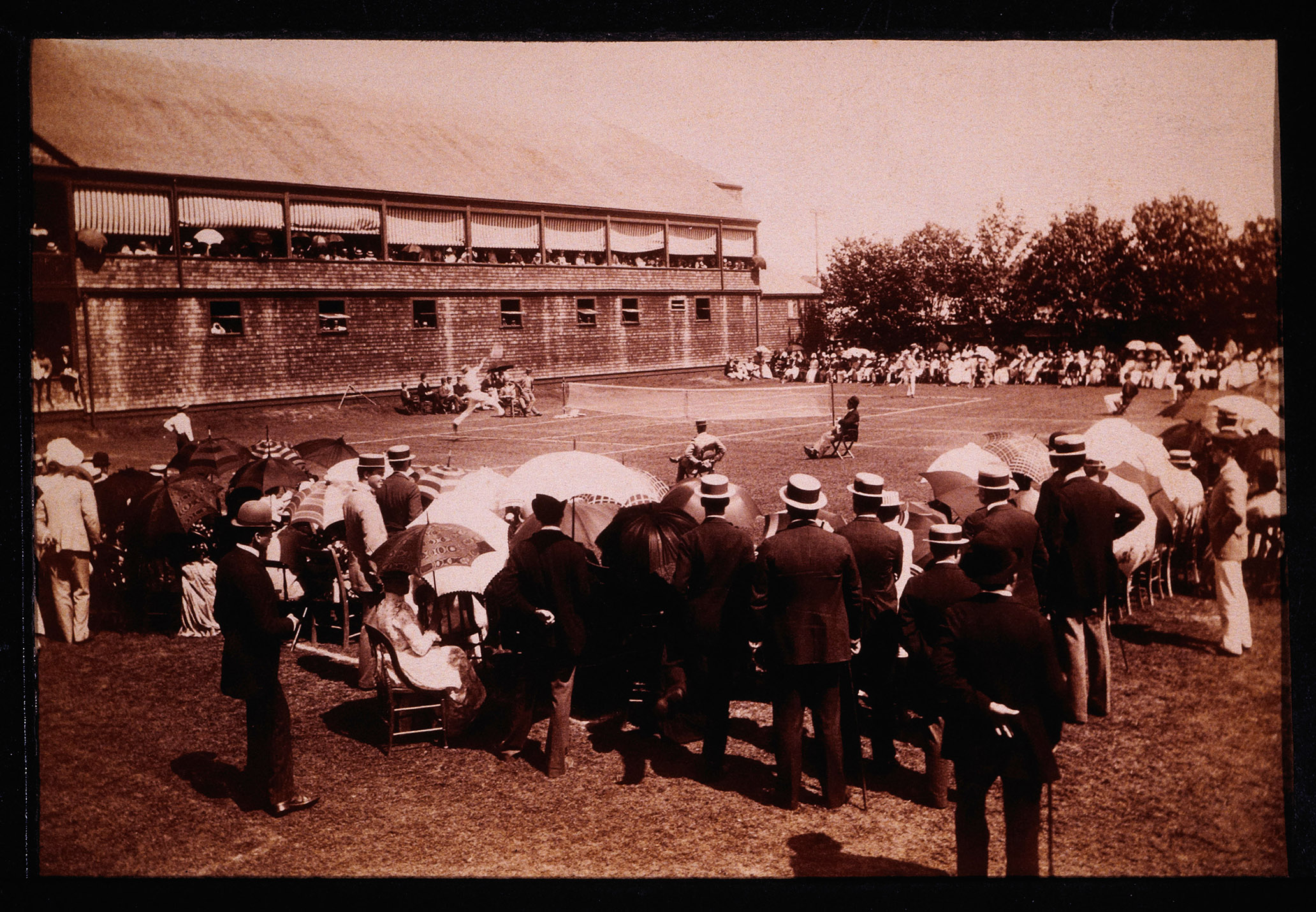
Newport Casino then. // Alamy

Newport Casino then. // Alamy
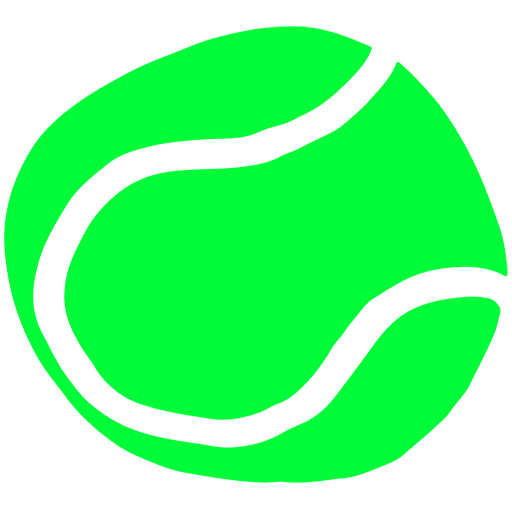
SIGN UP — YOU'RE ONLY AS GOOD AS YOUR SECOND SERVE.
England Swings
England Swings
Braid Dead and Adidas launch the “unstructured" Stan Smith shoe at their Tennis Jam in London.
Braid Dead and Adidas launch the “unstructured" Stan Smith shoe at their Tennis Jam in London.
By TSS
July 12, 2024
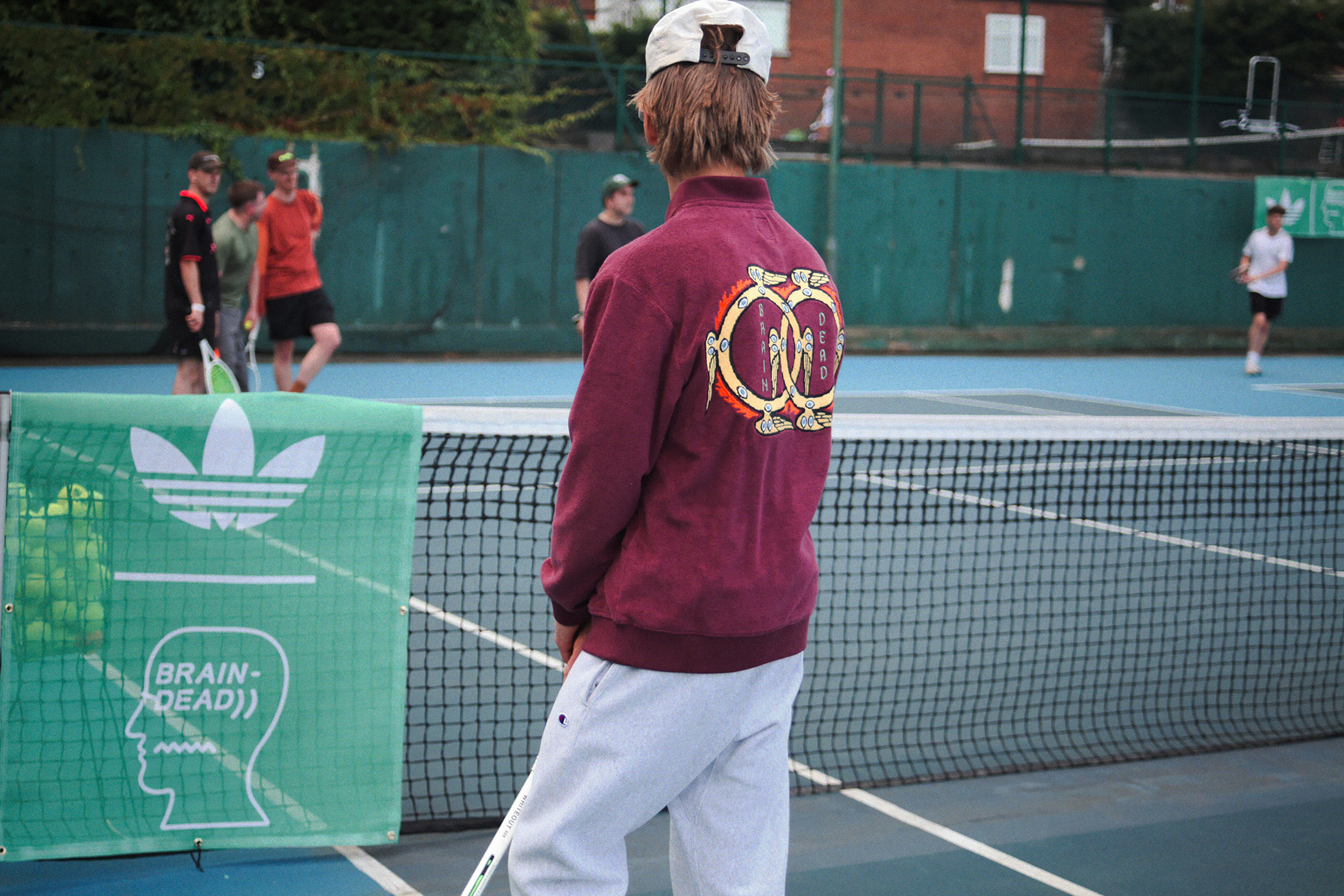

As if by miracle, a soggy fortnight saw a break in the clouds long enough for the LA-based brand Brain Dead to pull off a smashing, super vibed out event with partners Adidas, LVBL, Solinco and The Second Serve, as they launched the first iteration of their “Unstructured” Stan Smith sneaker, which was available exclusively at the event—held at the Cumberland Lawn Tennis Club—and Dover Street Market, London.
While winking at future collaborations with Adidas and offering a peek into their latest tennis drop, the Brain Dead x Adidas Tennis Jam also brought LA’s LVBL culture and format to the courts of London for the first time. Along with private coaching from popular UK YouTube tennis instructor, The Tennis Mentor, players and spectators alike were treated to a rare, revelatory tennis event which showed how the game combined with community, music, and authentic culture can grow the sport in unprecedented ways.
SIGN UP — YOU'RE ONLY AS GOOD AS YOUR SECOND SERVE.
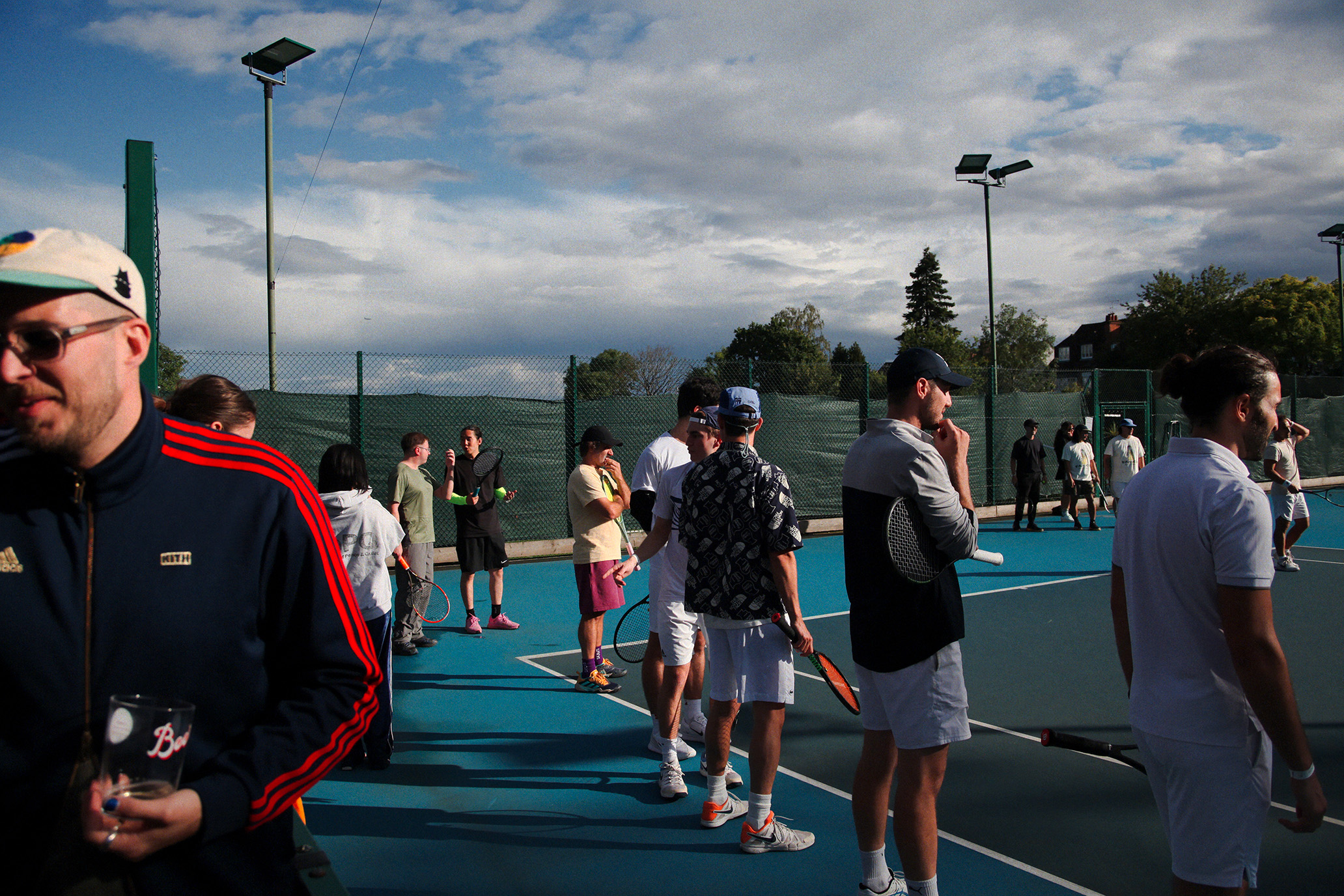

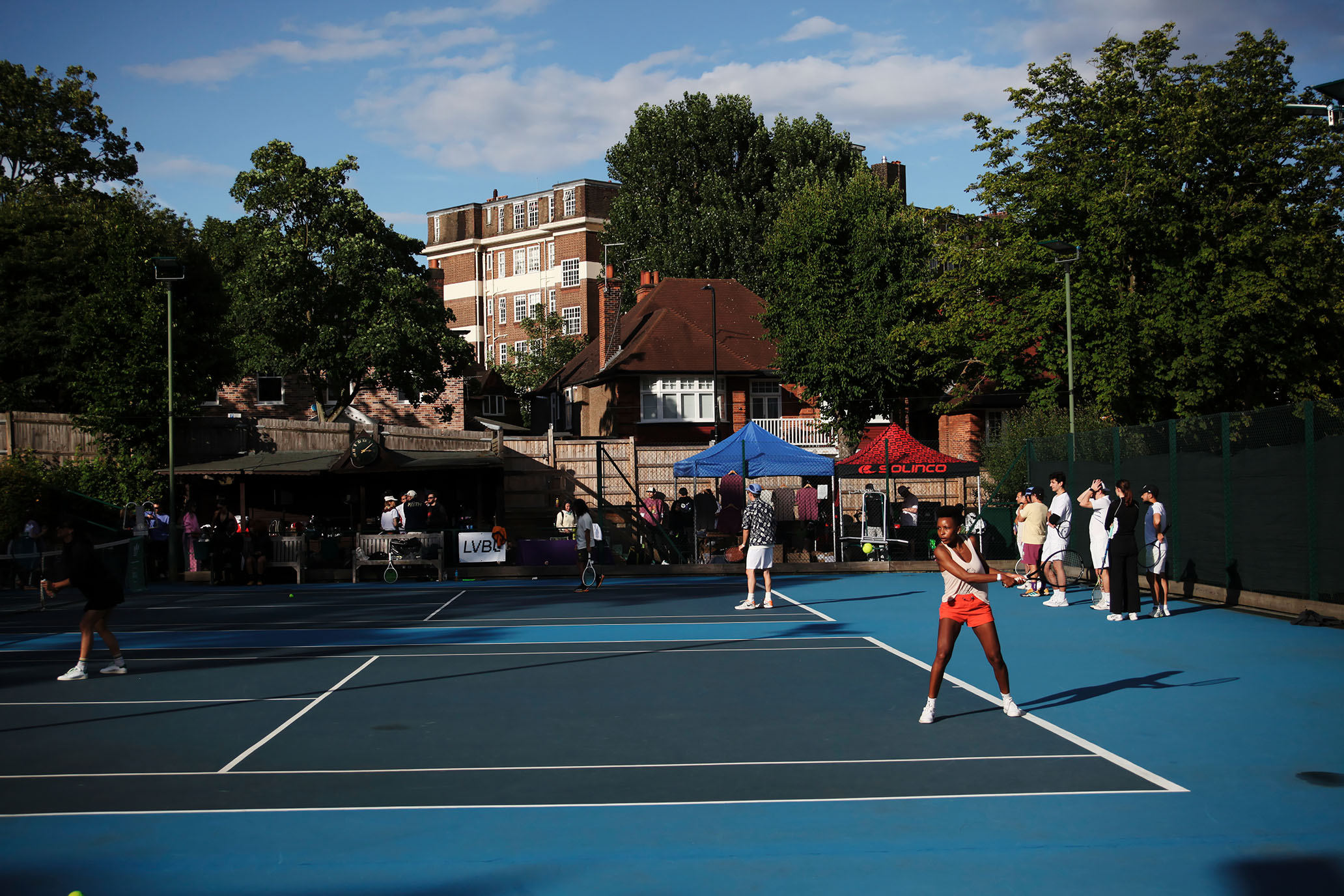

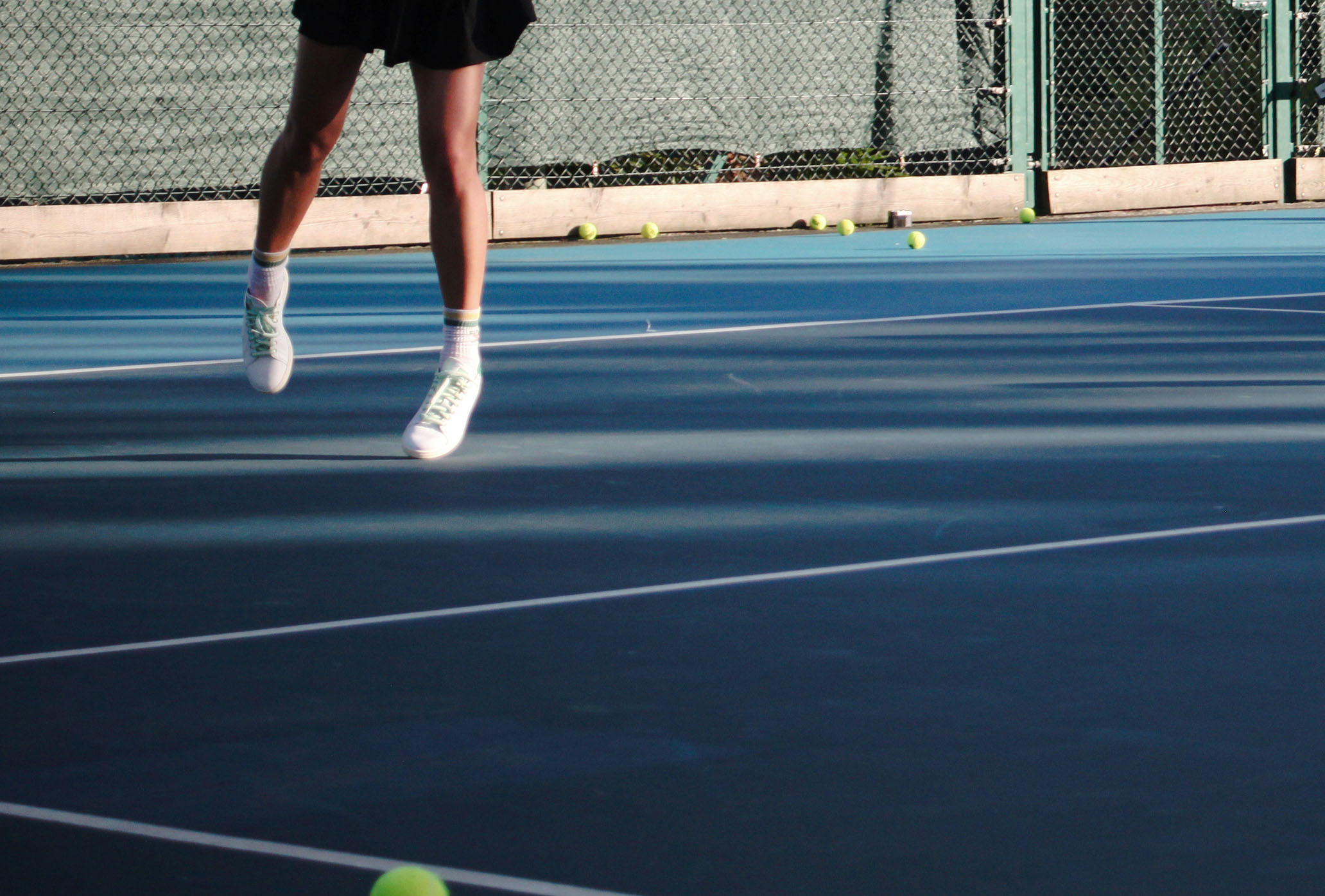

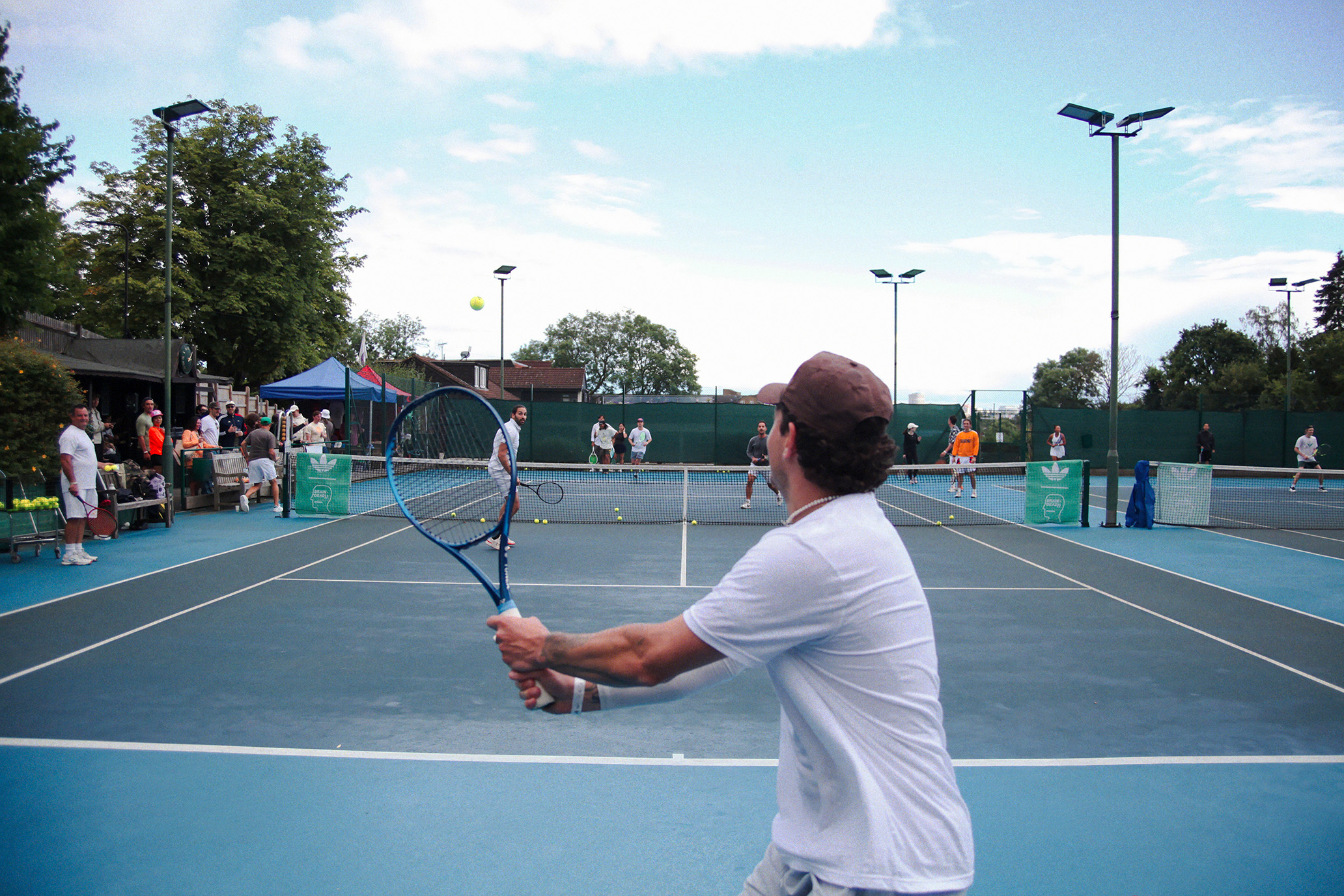

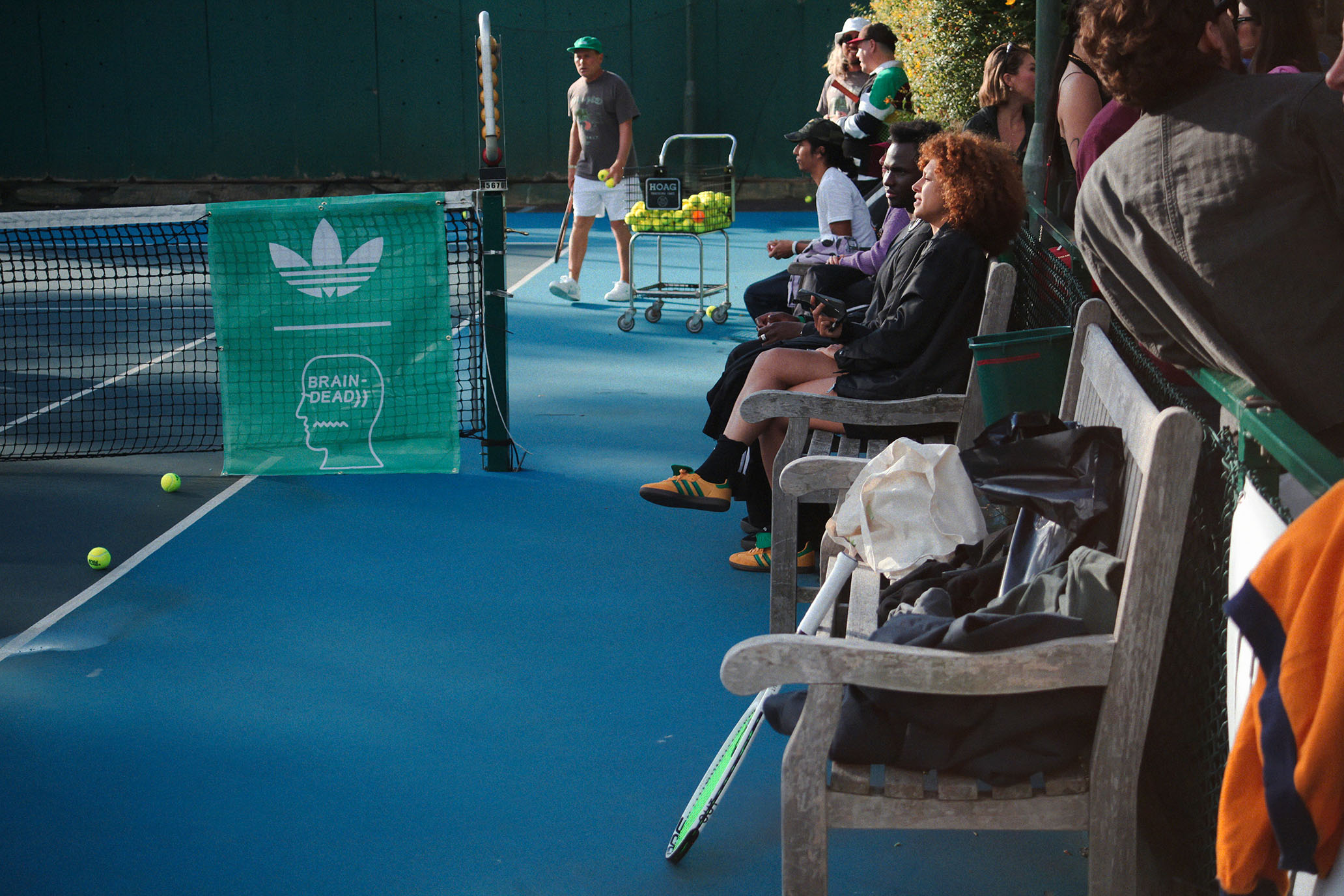
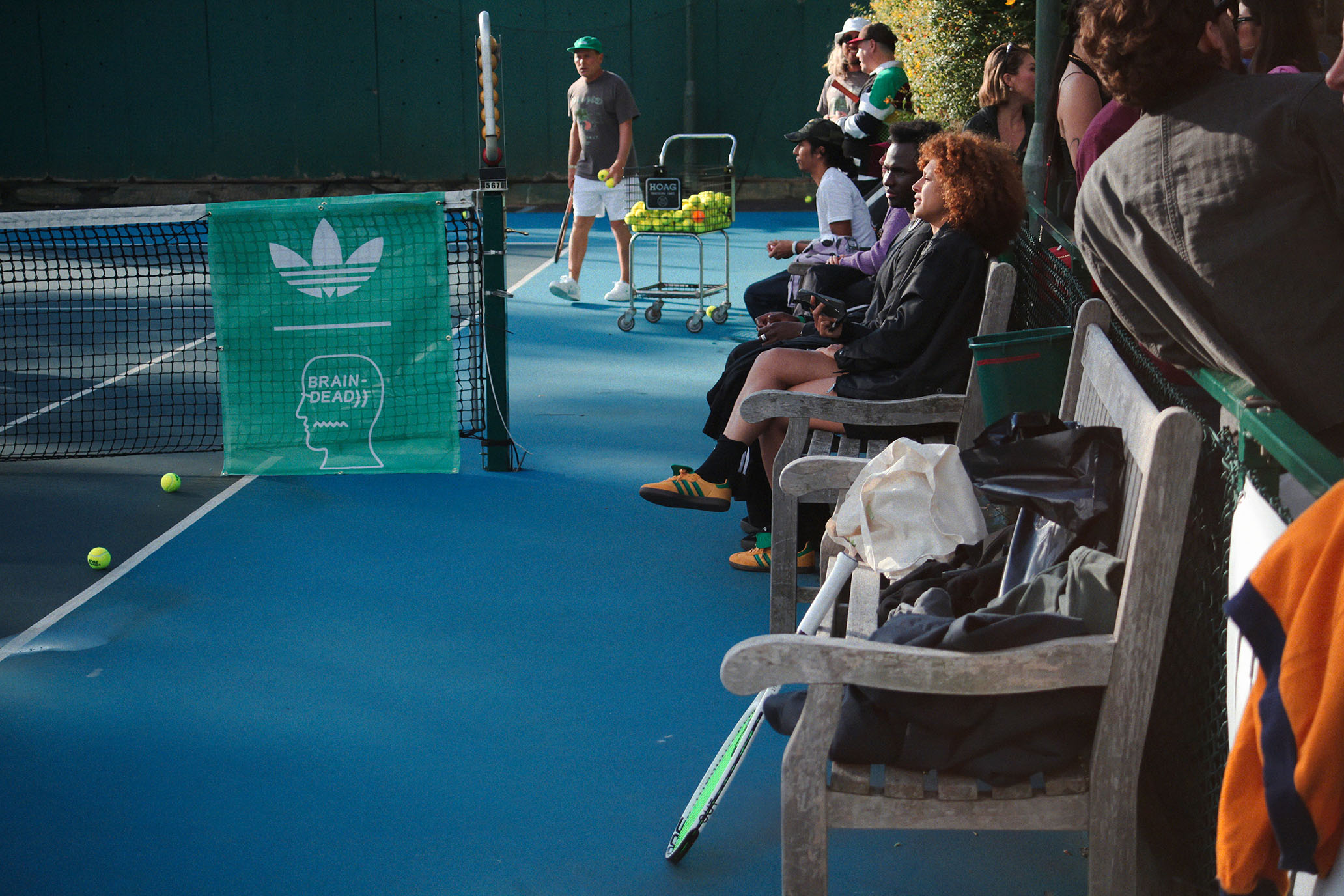
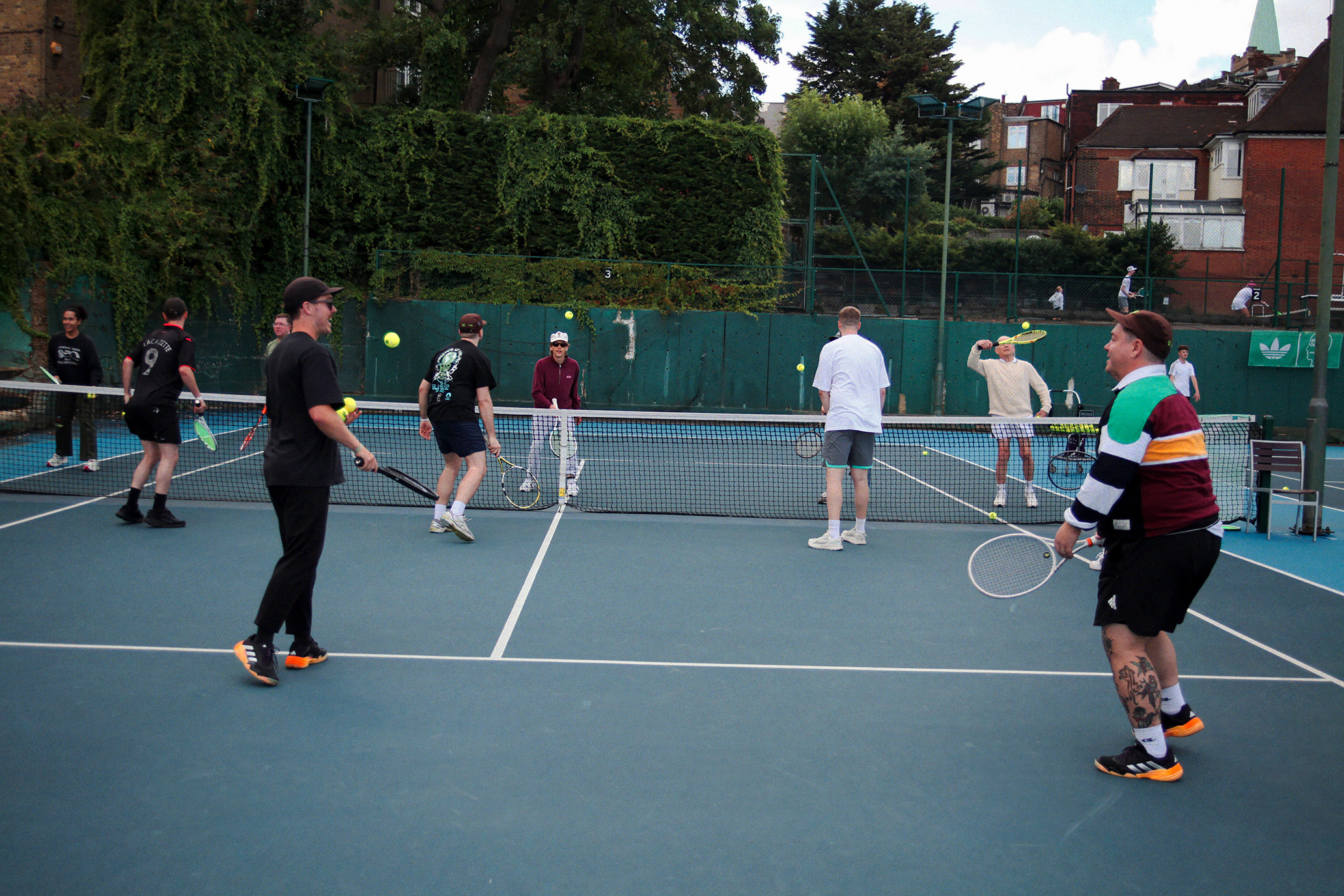

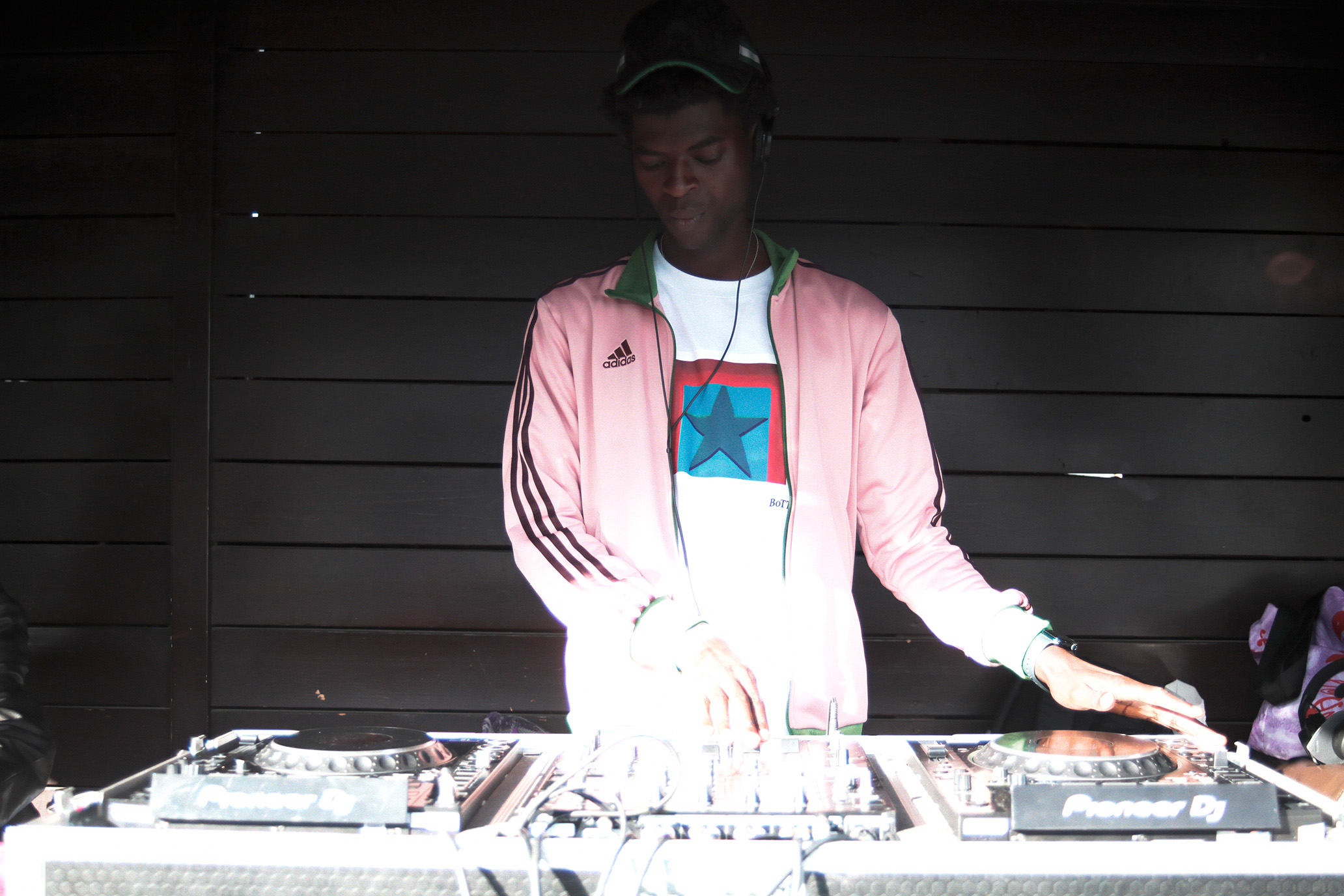

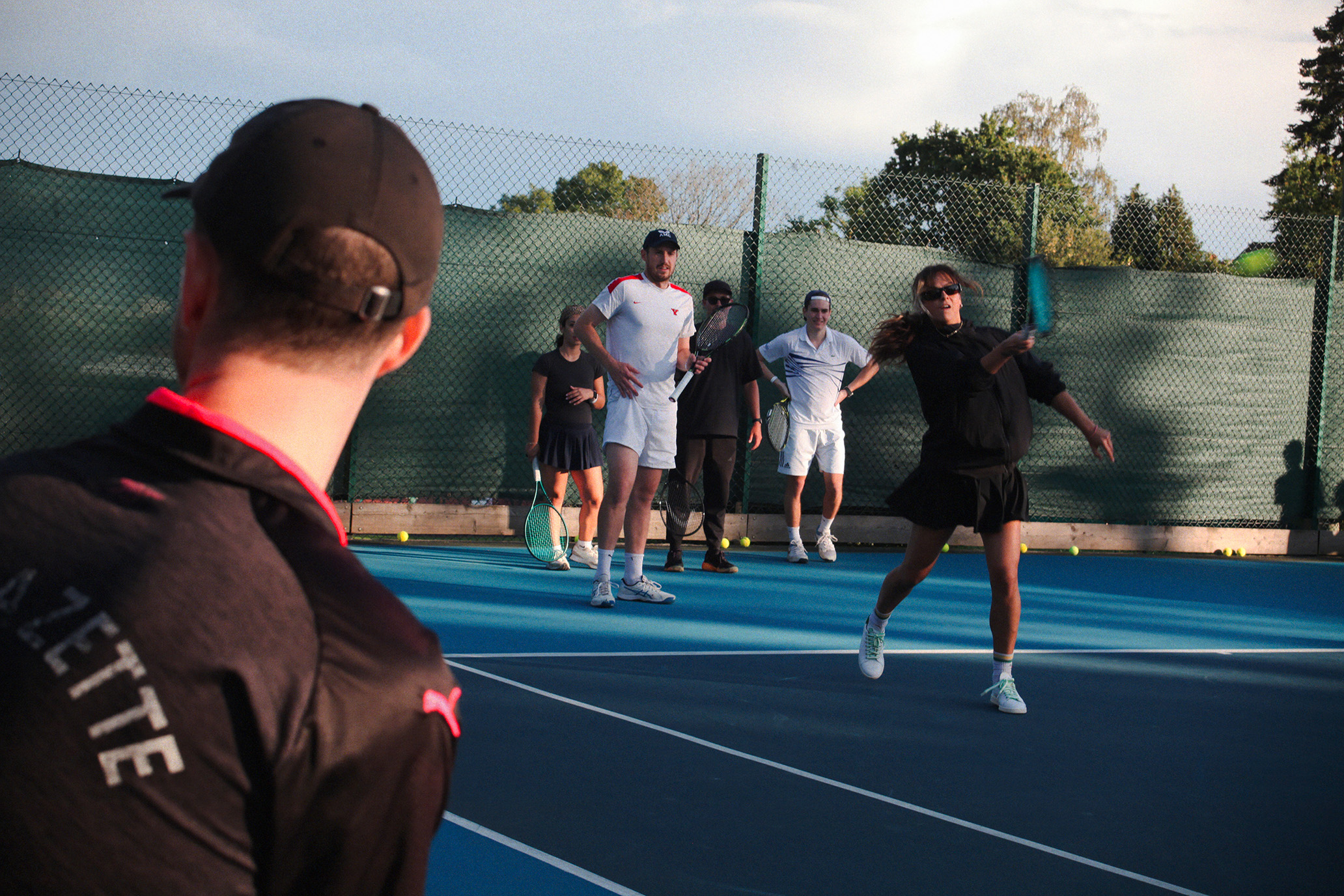

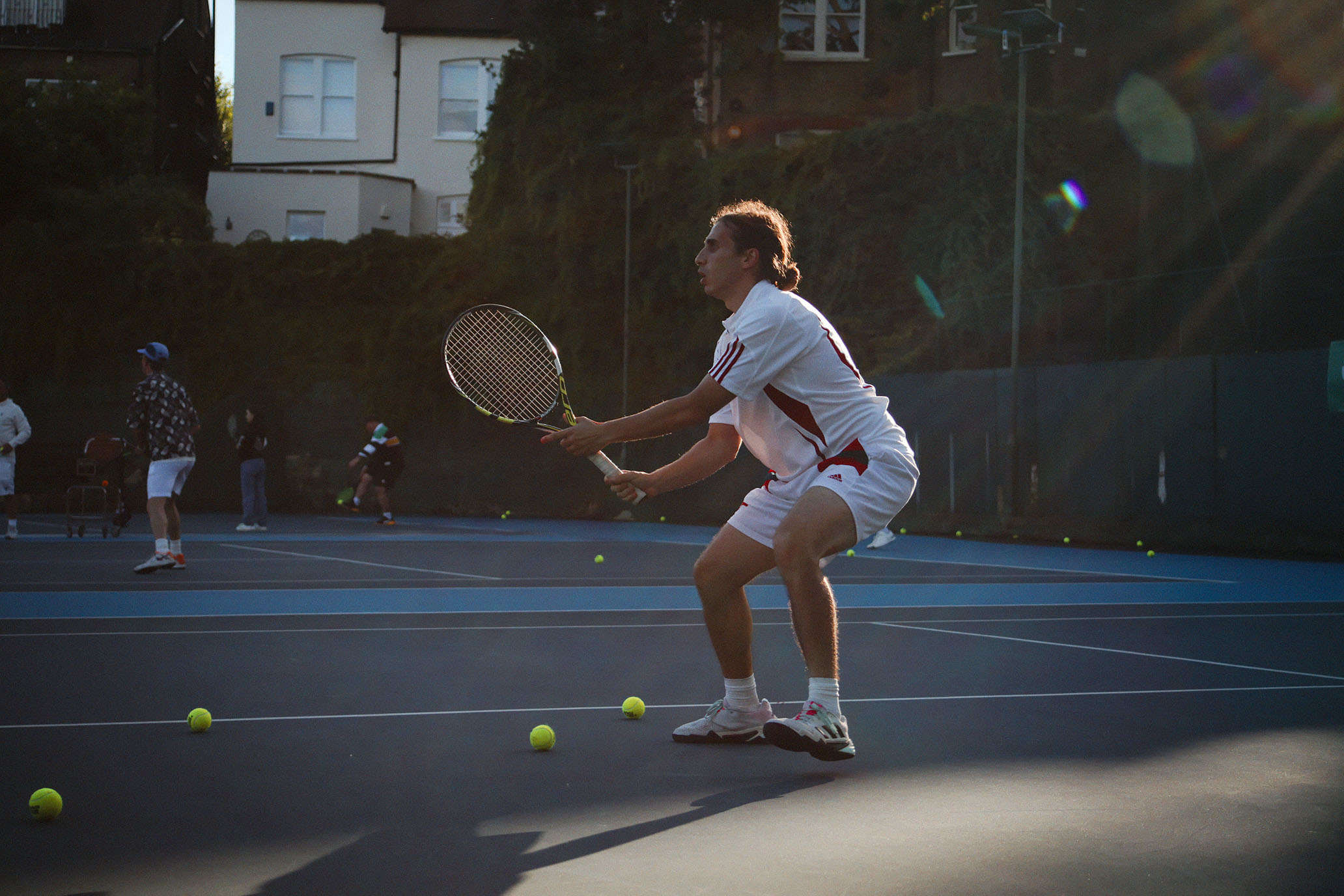

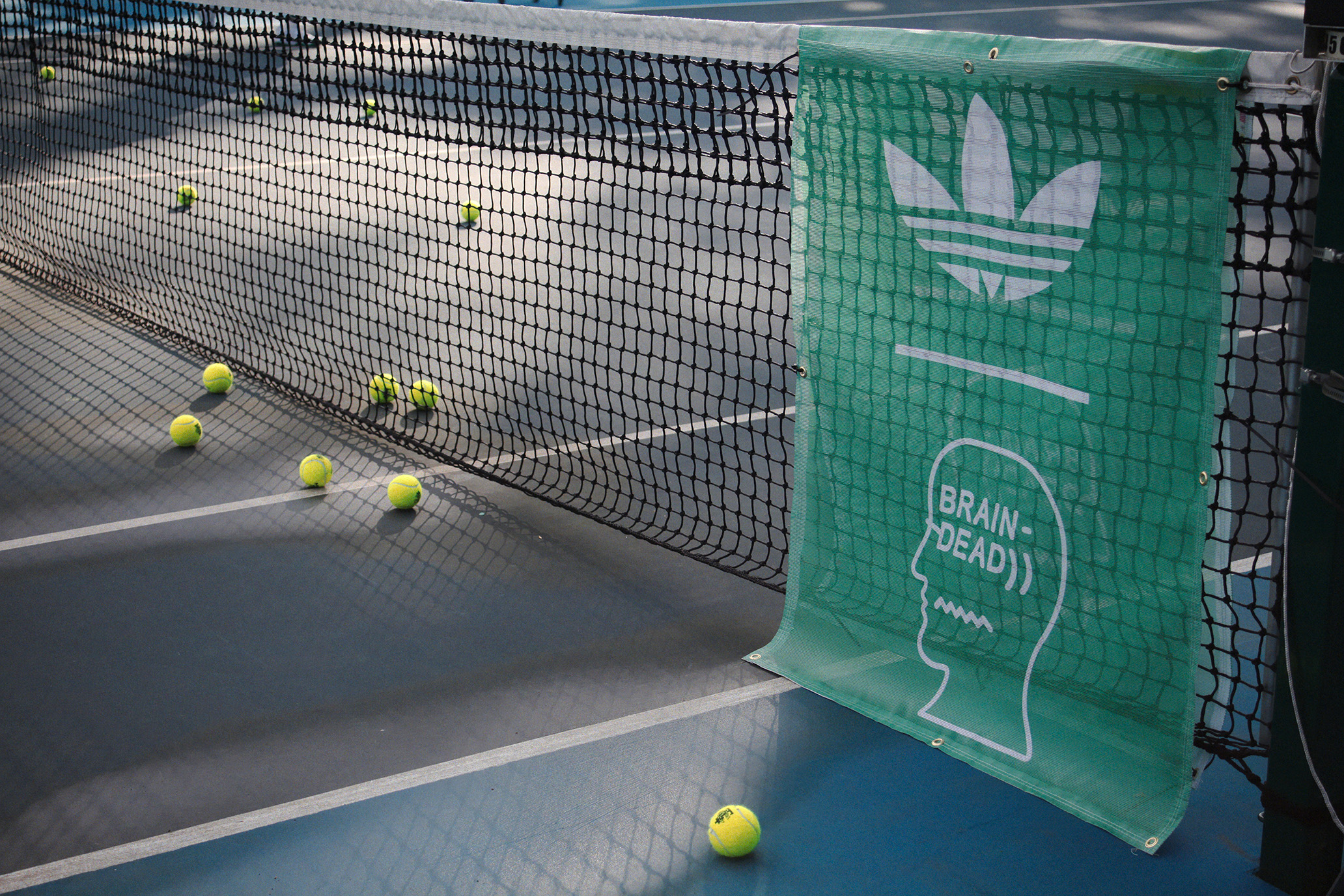

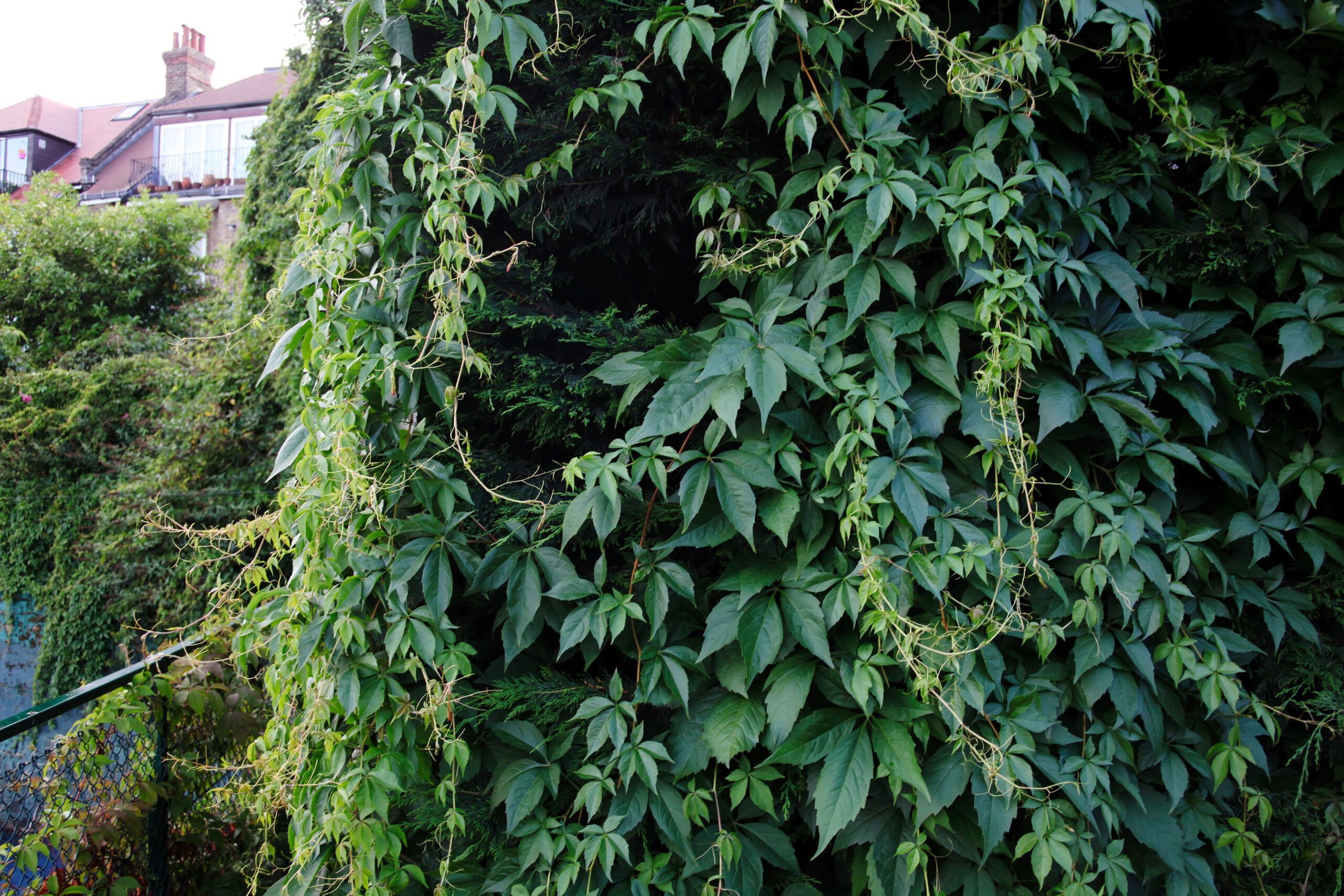

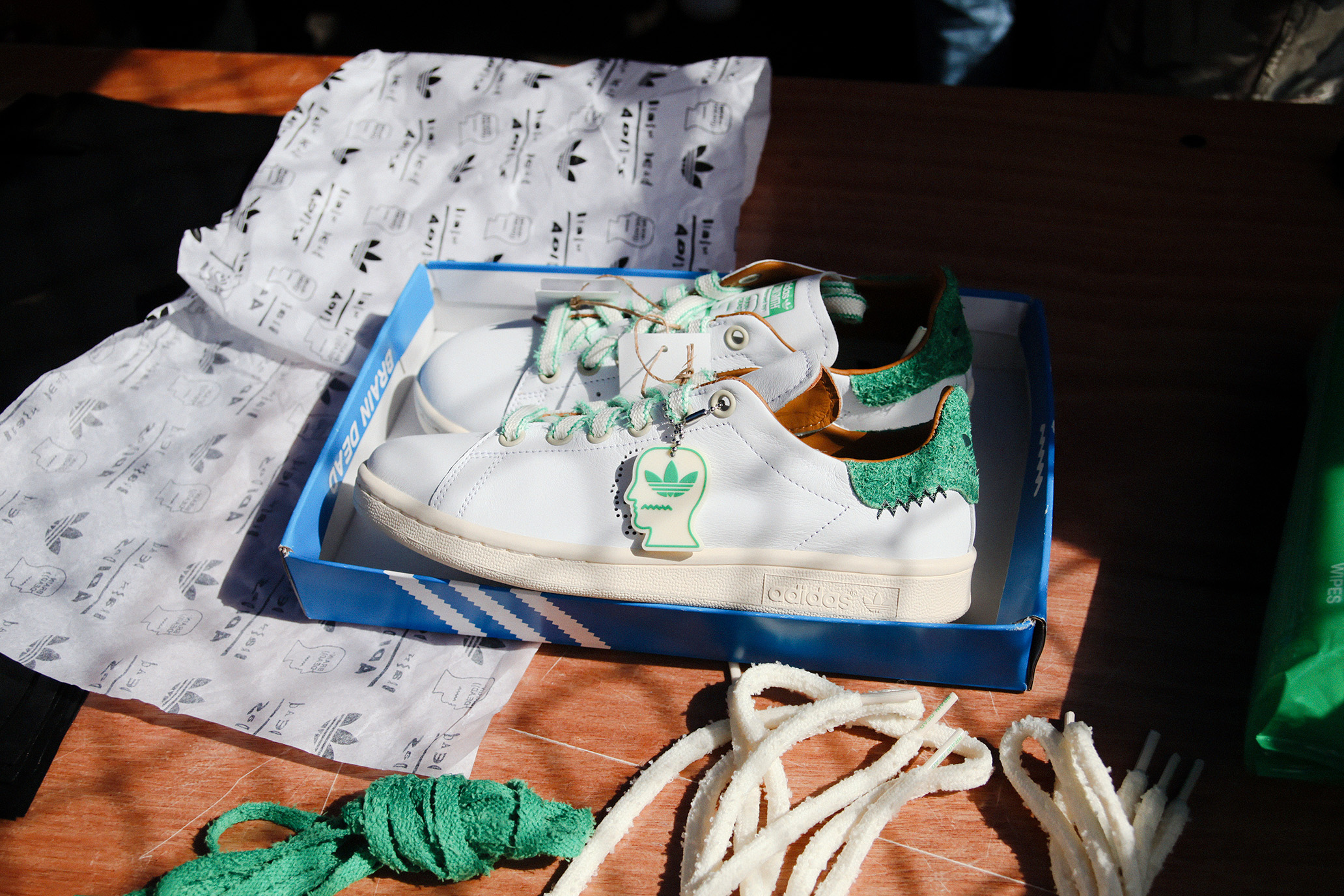

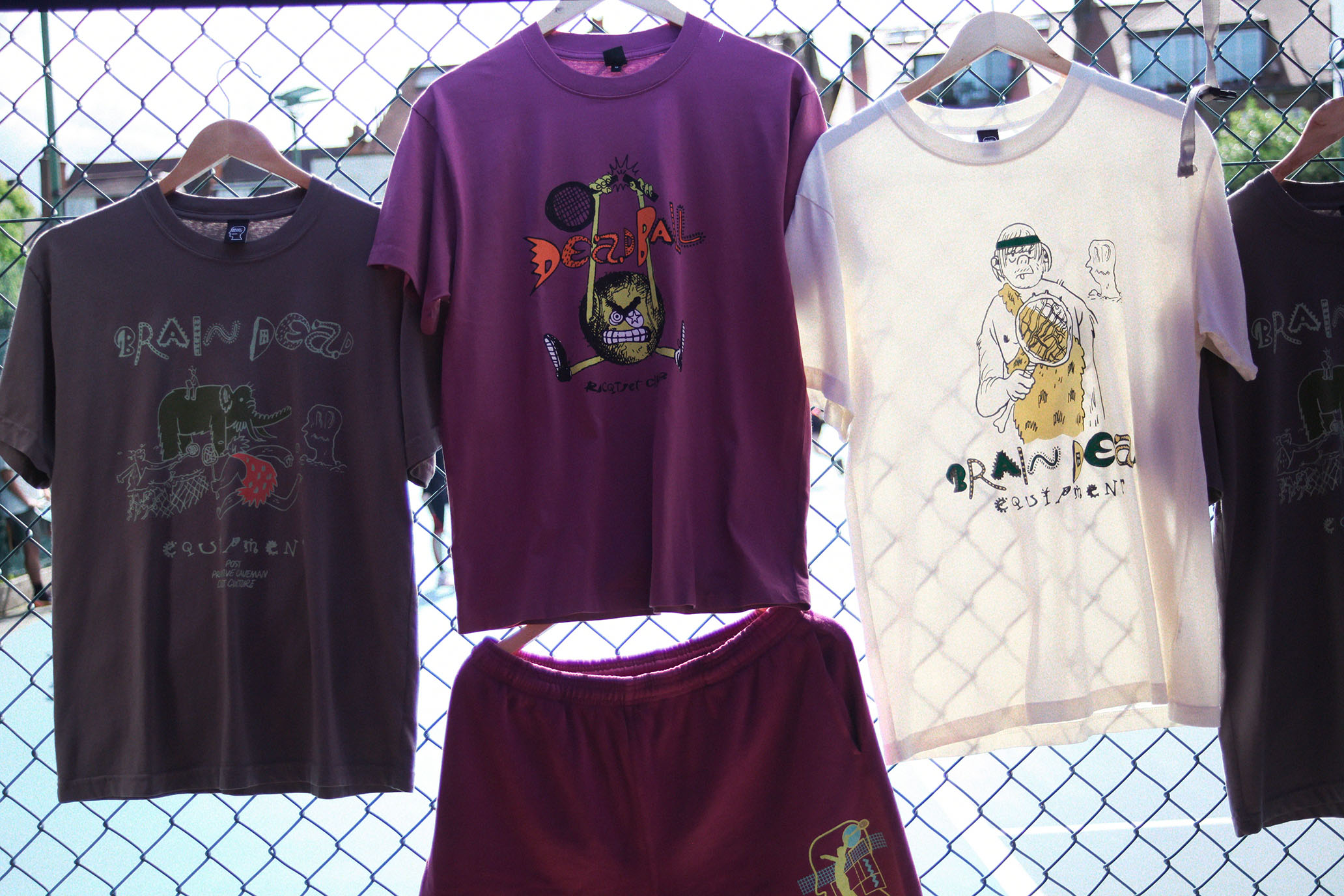

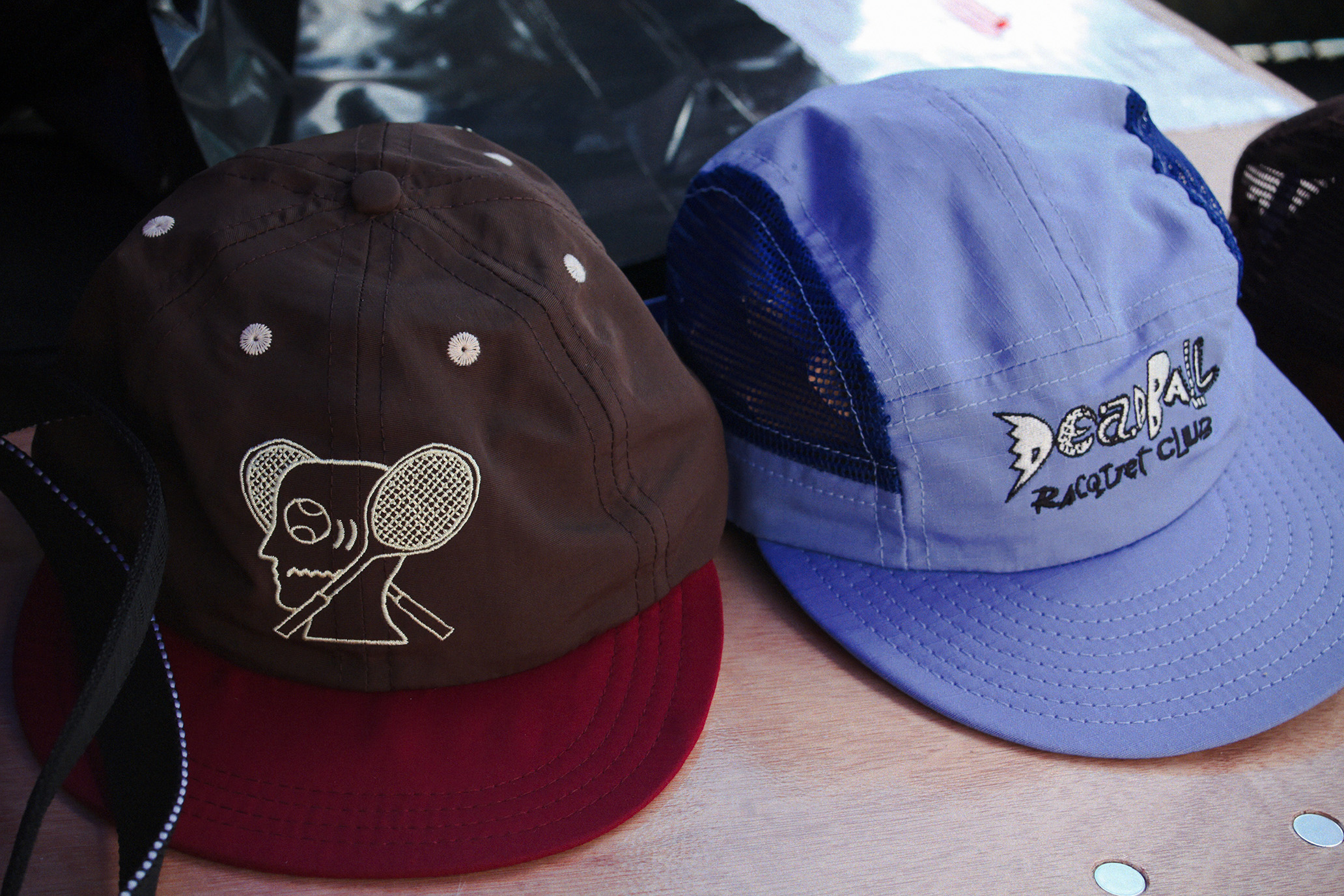

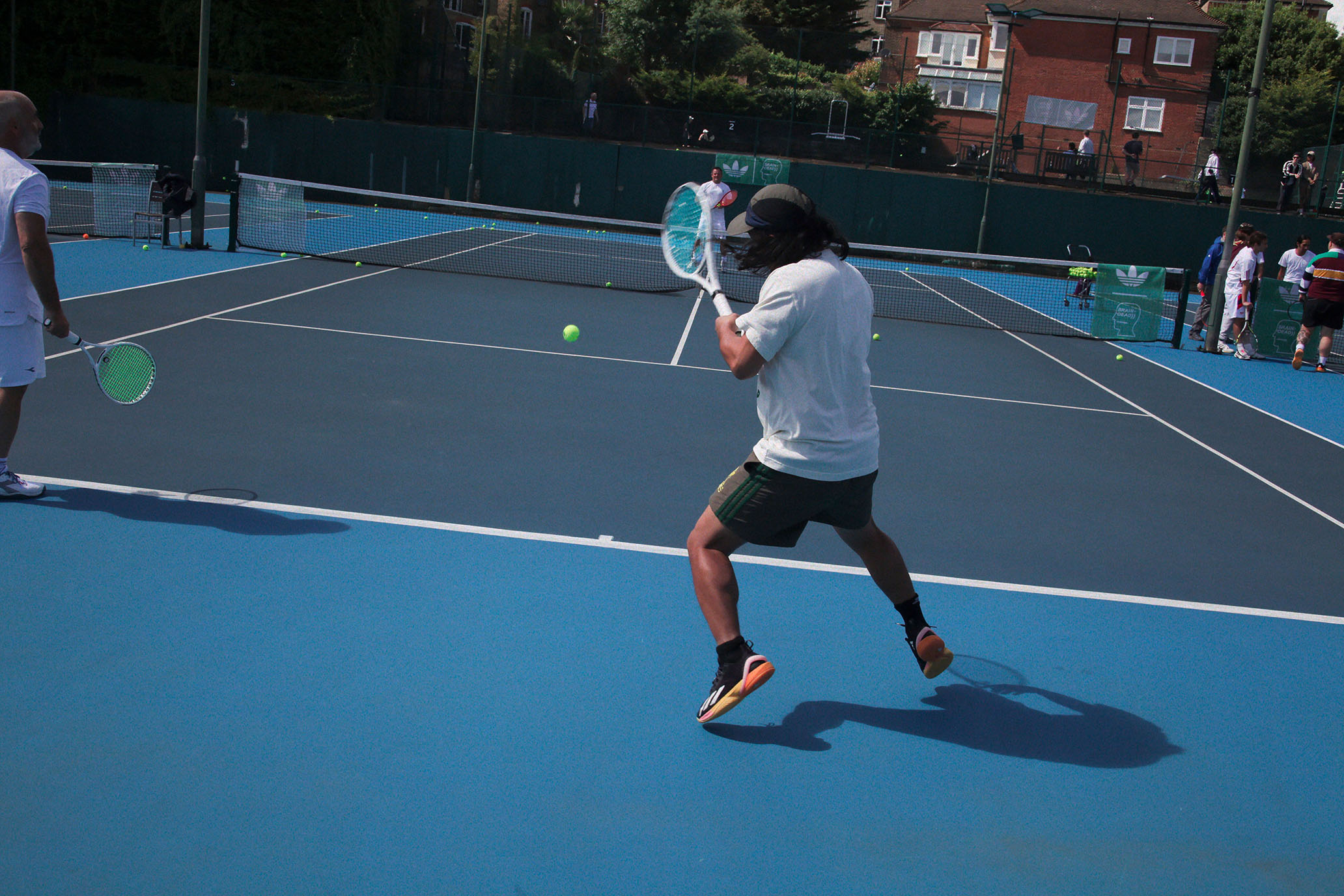

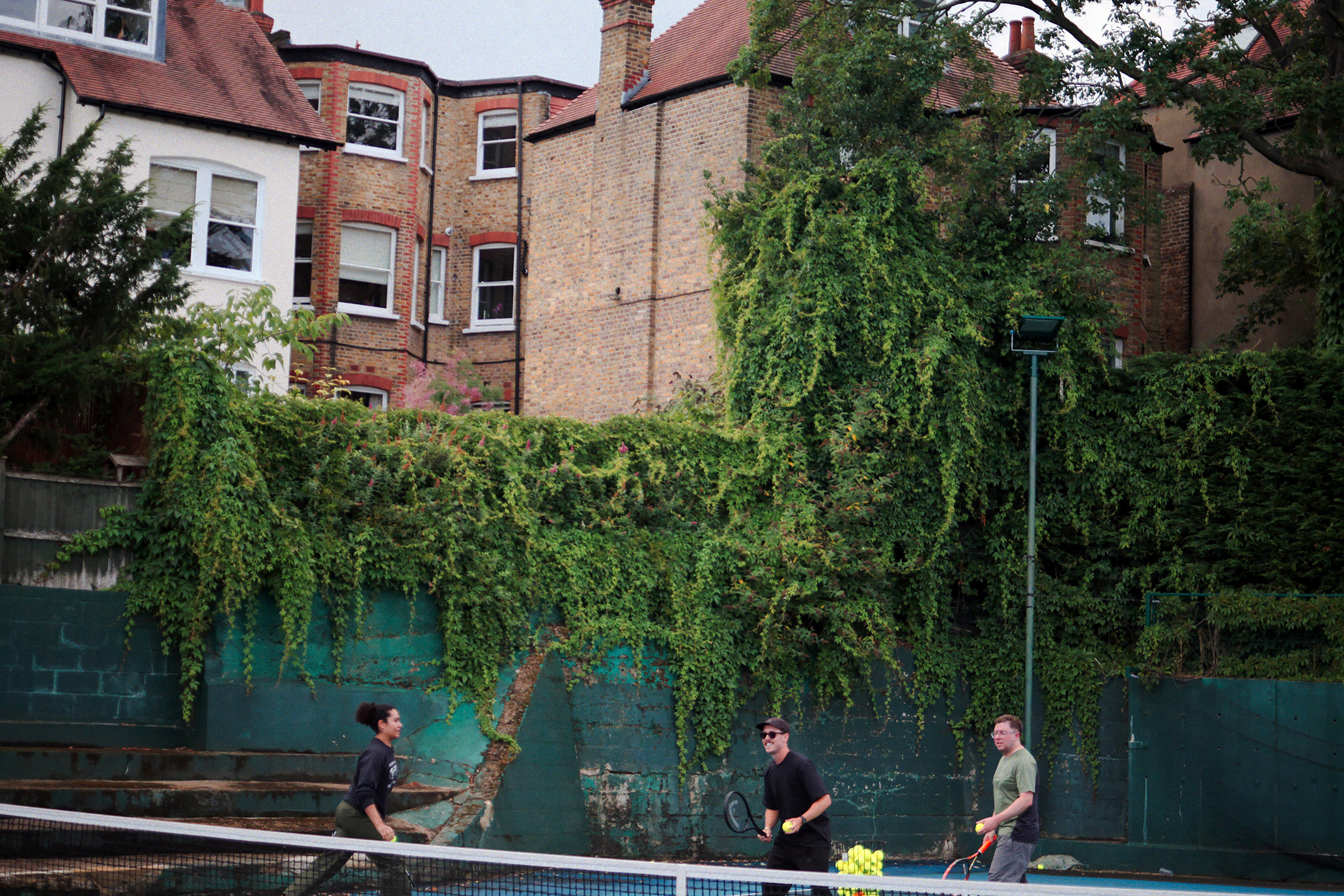

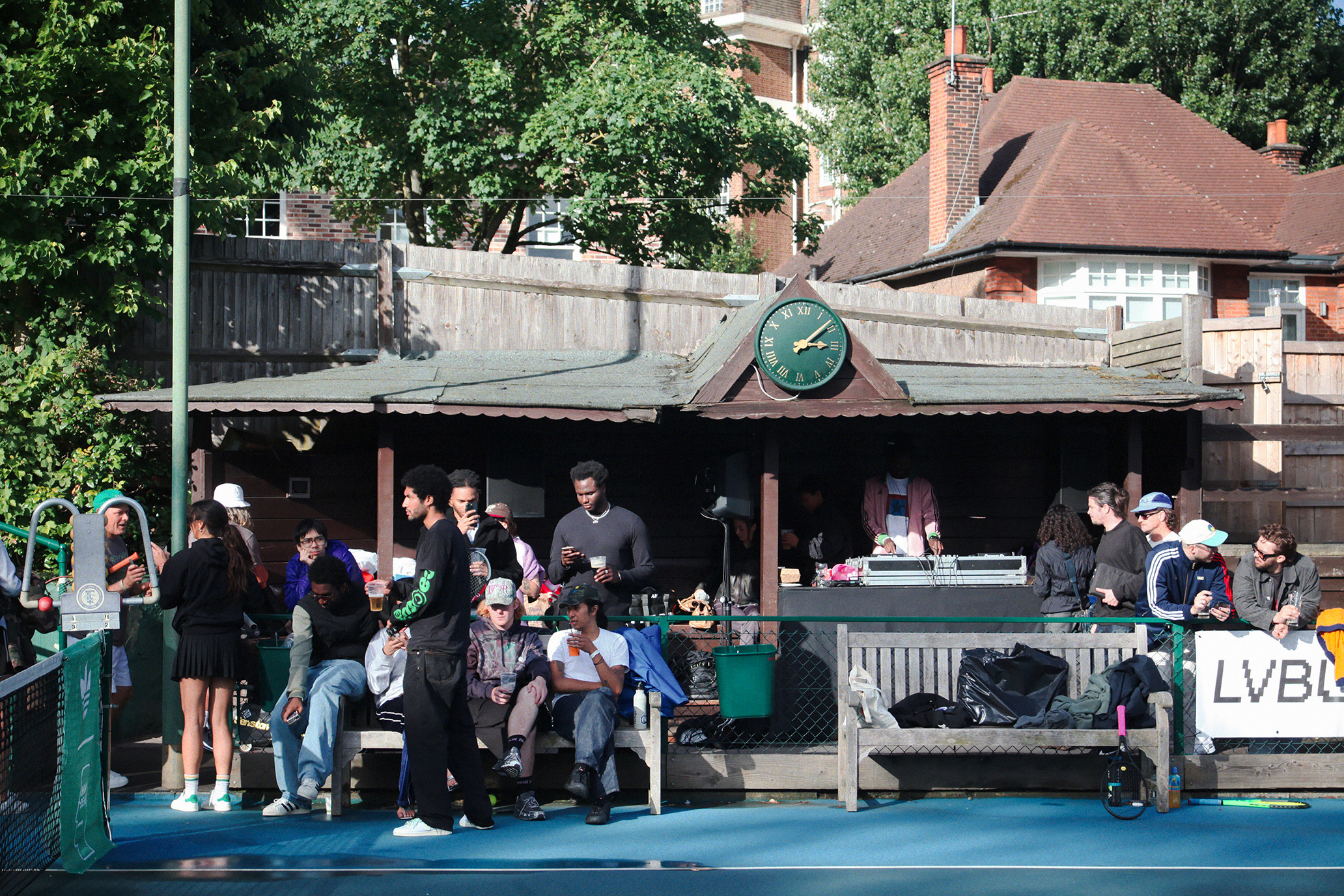

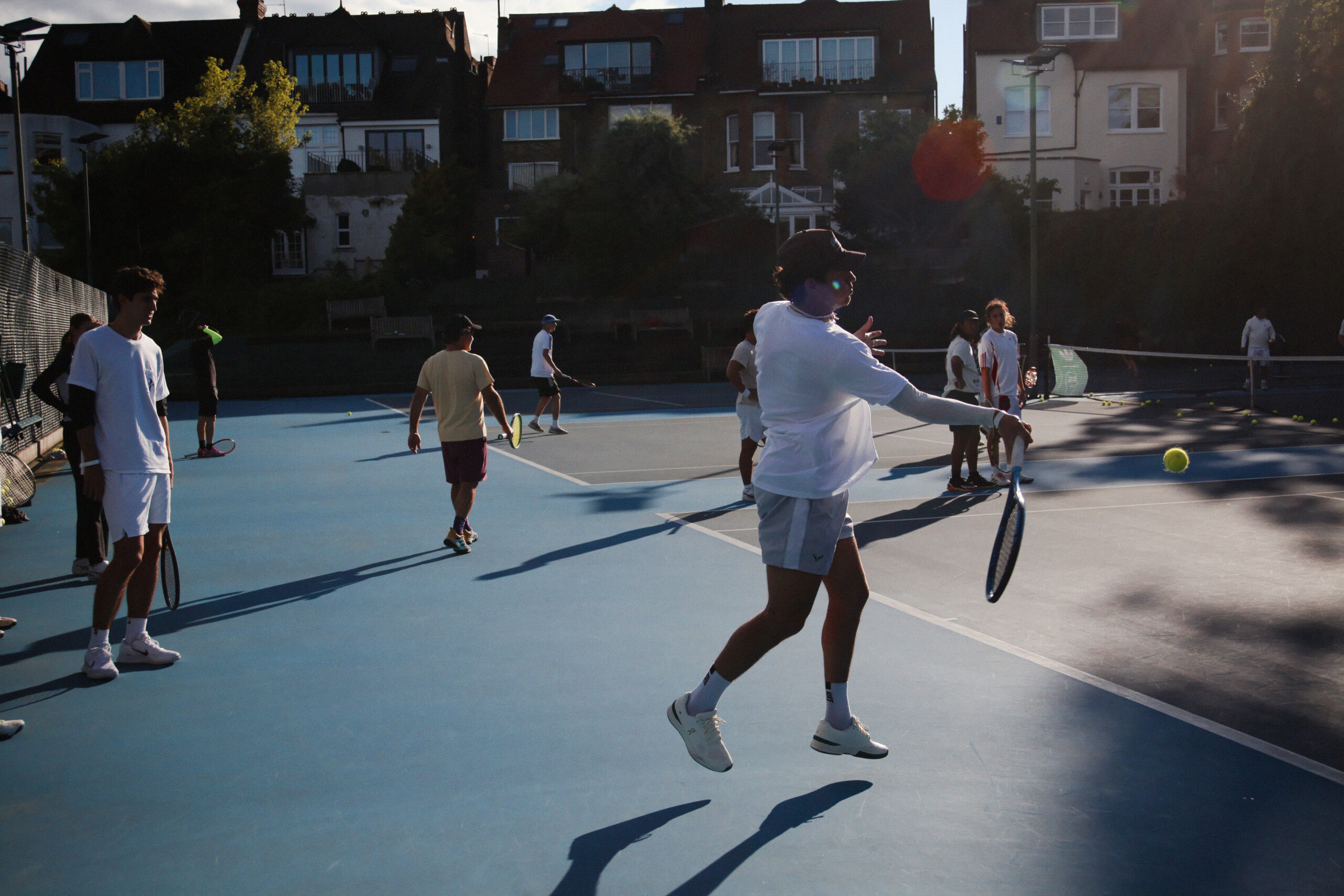

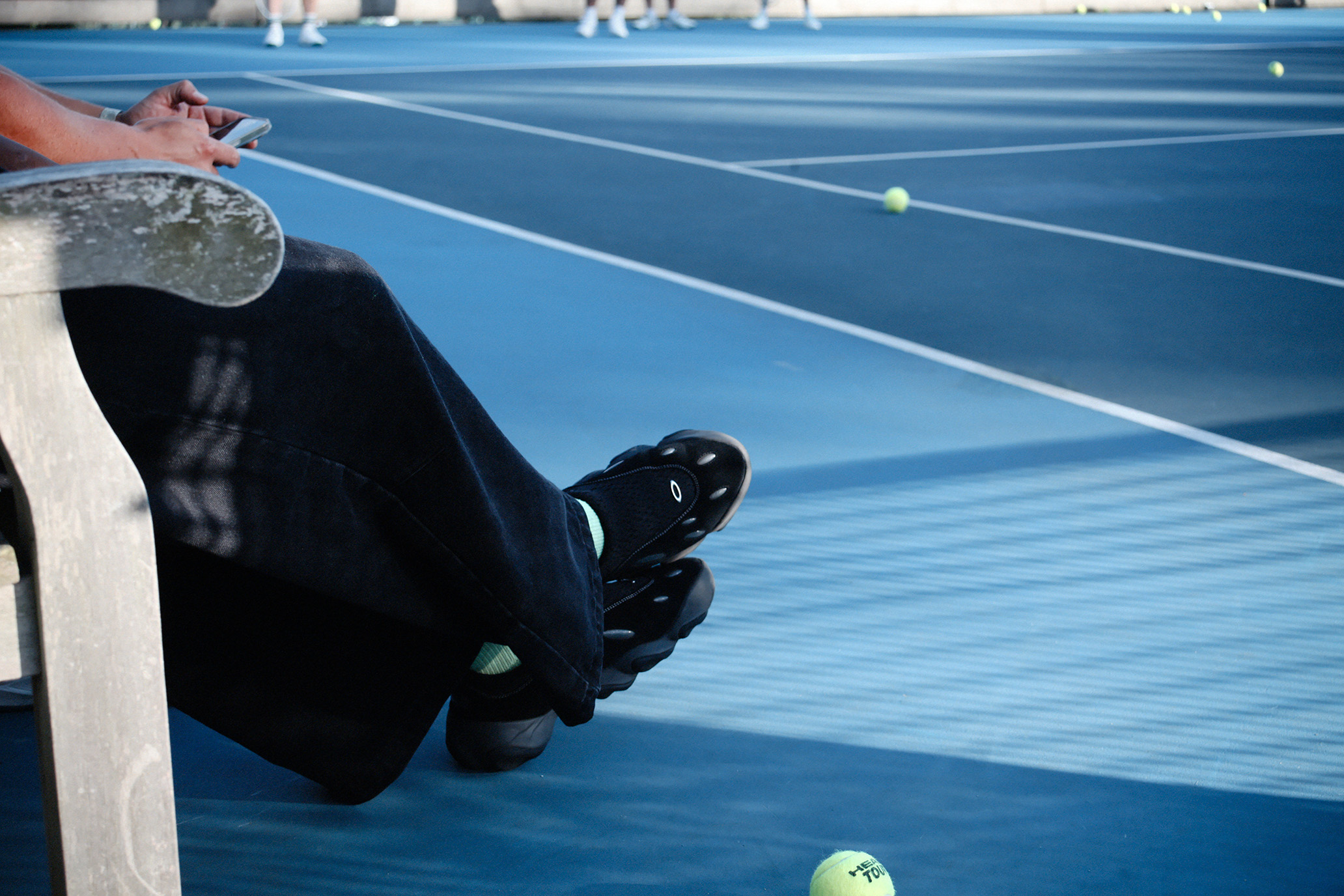

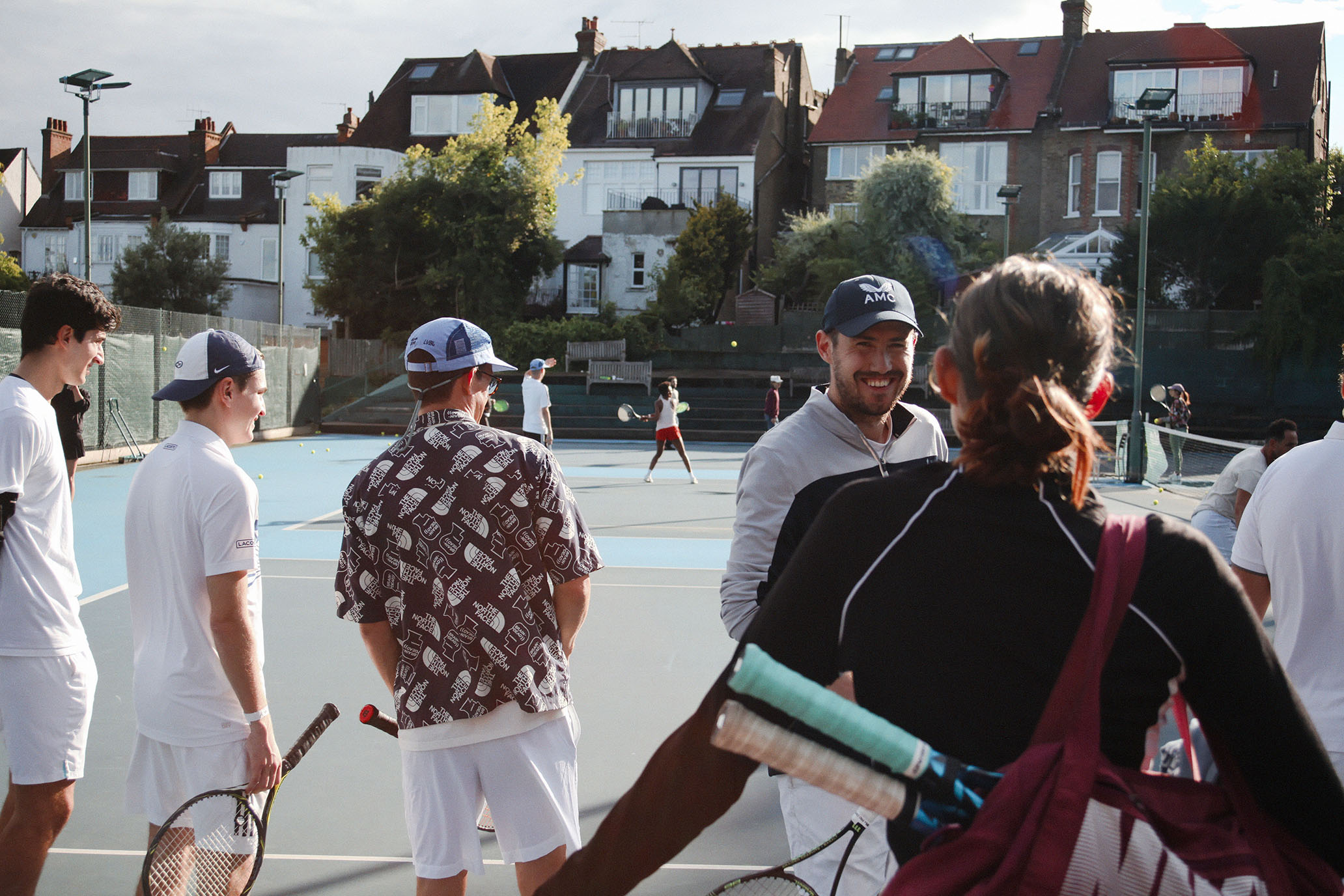

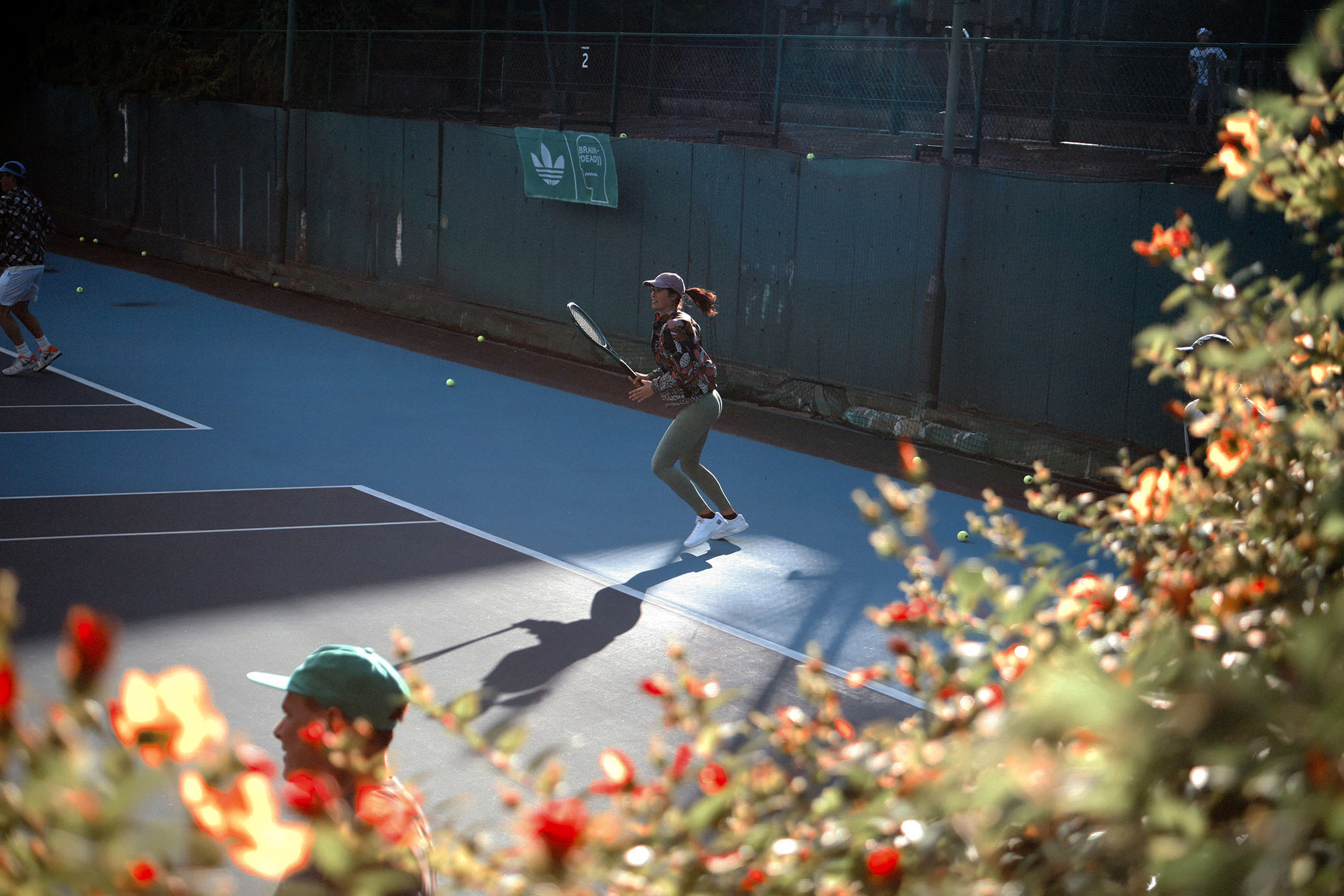

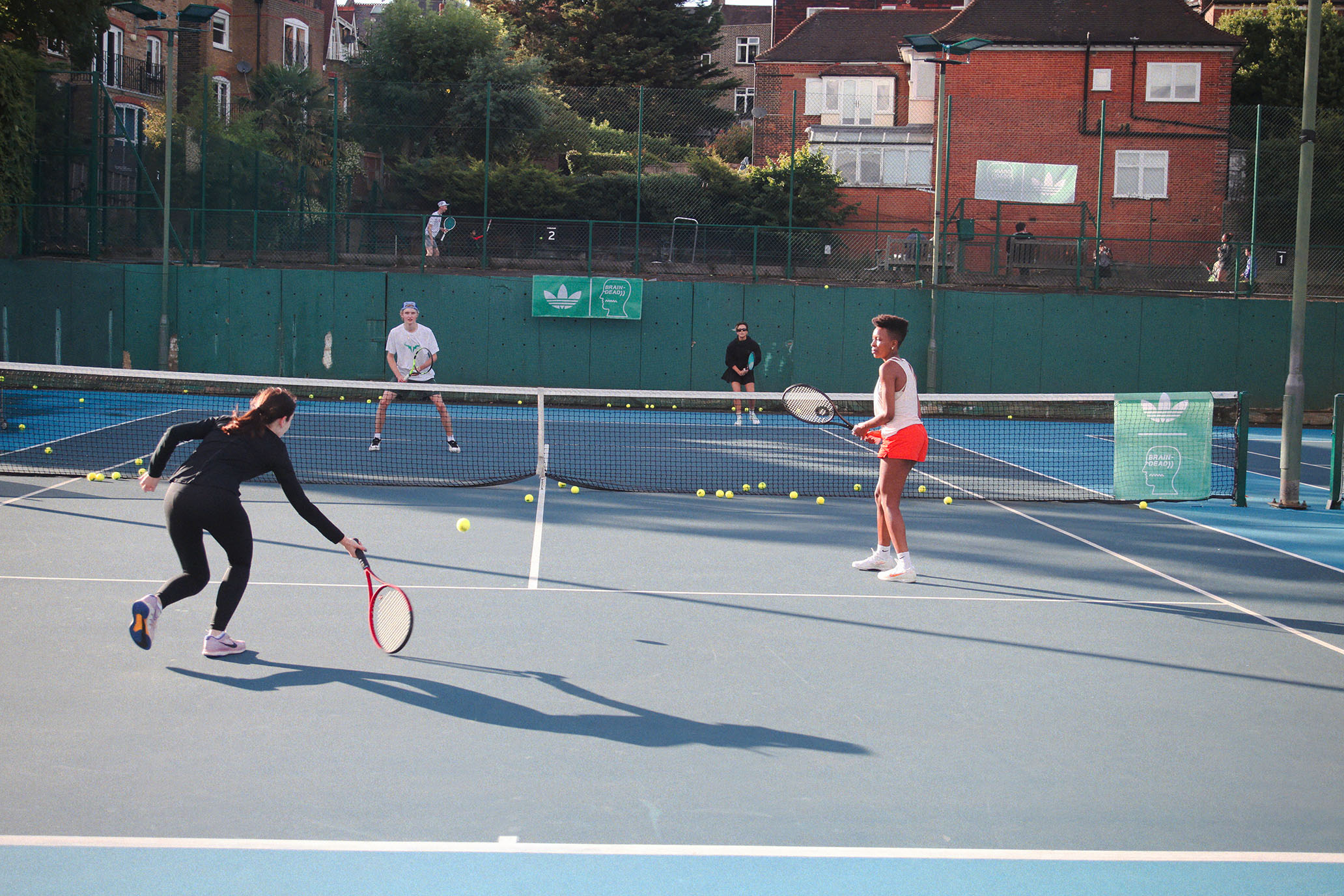

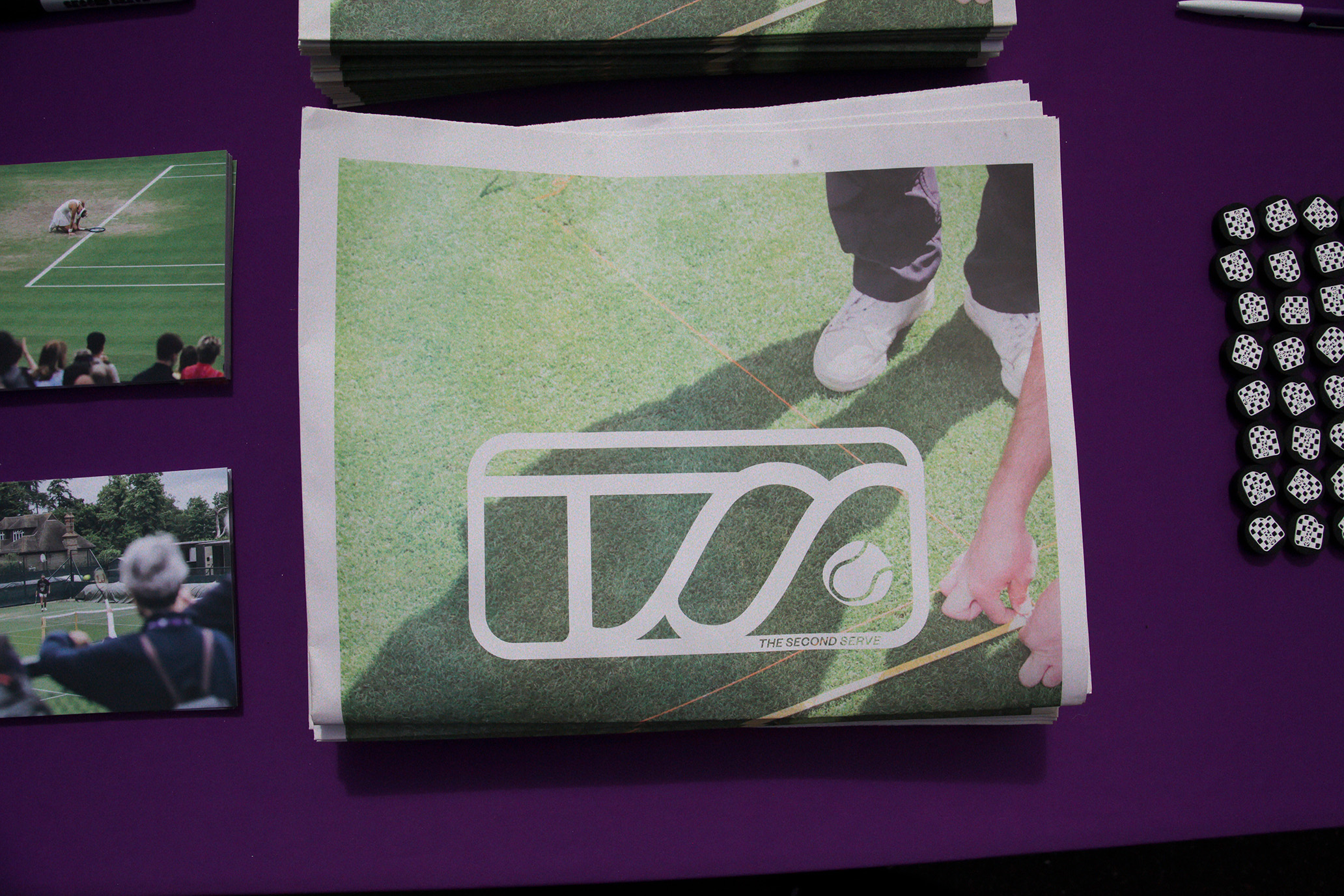

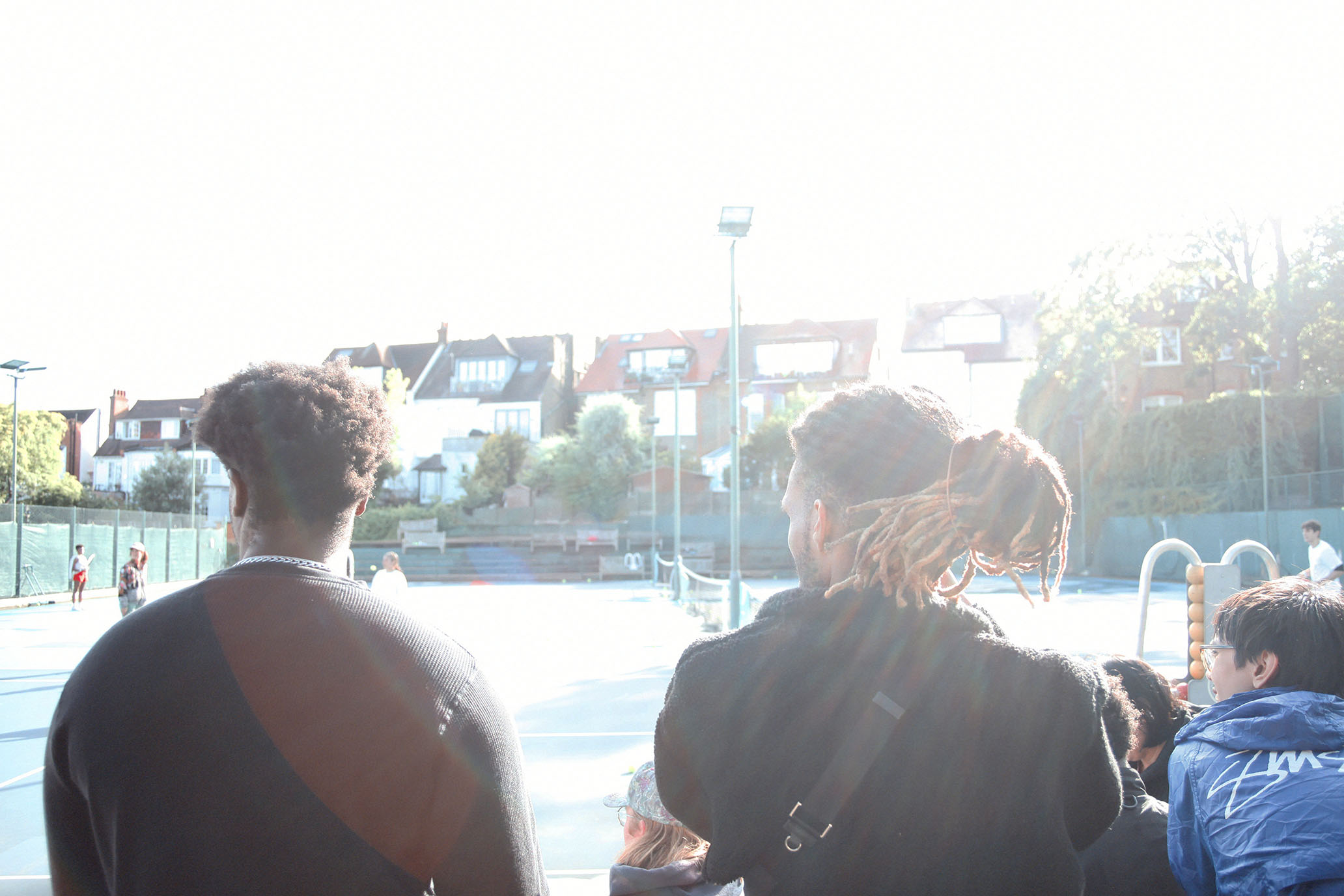

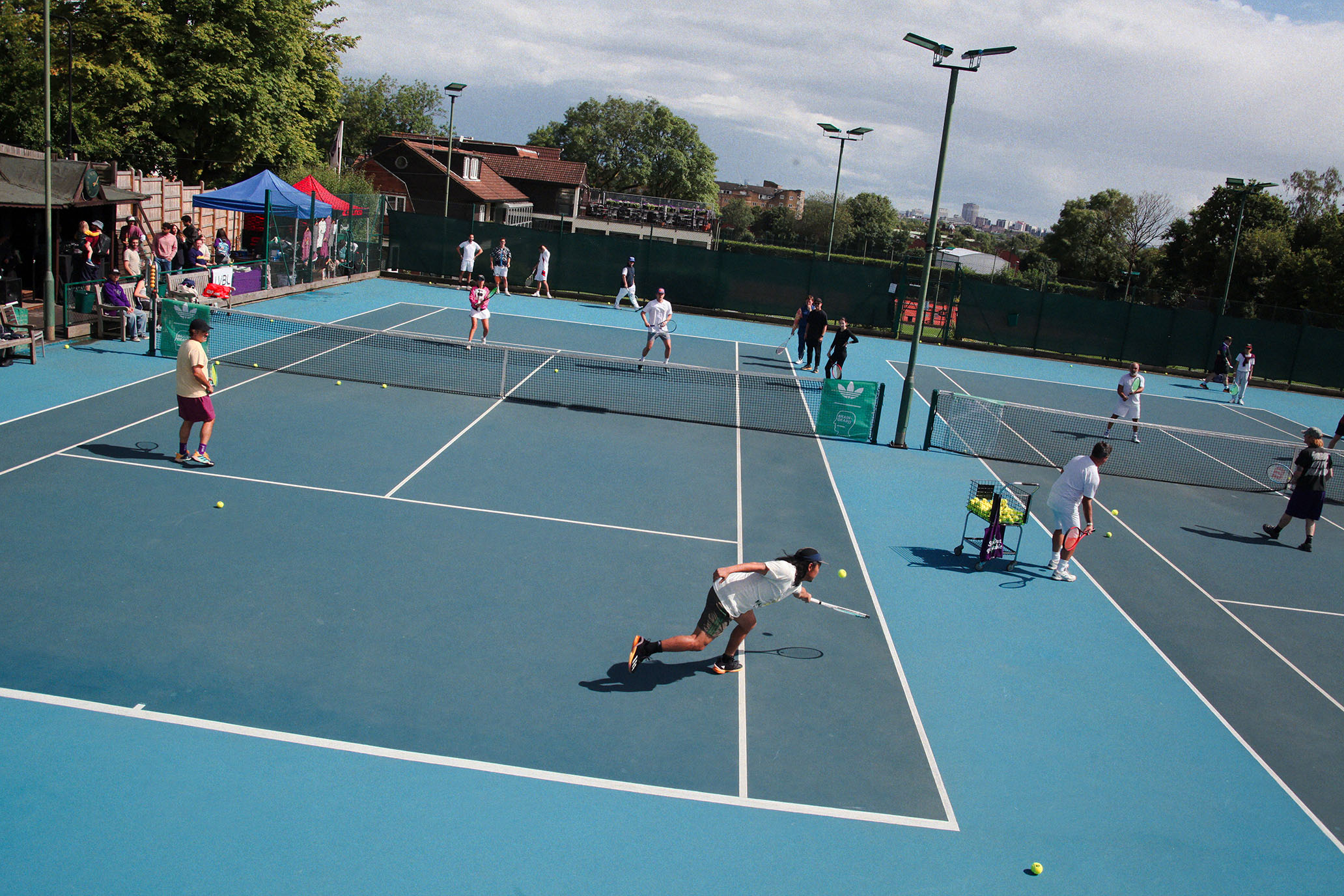

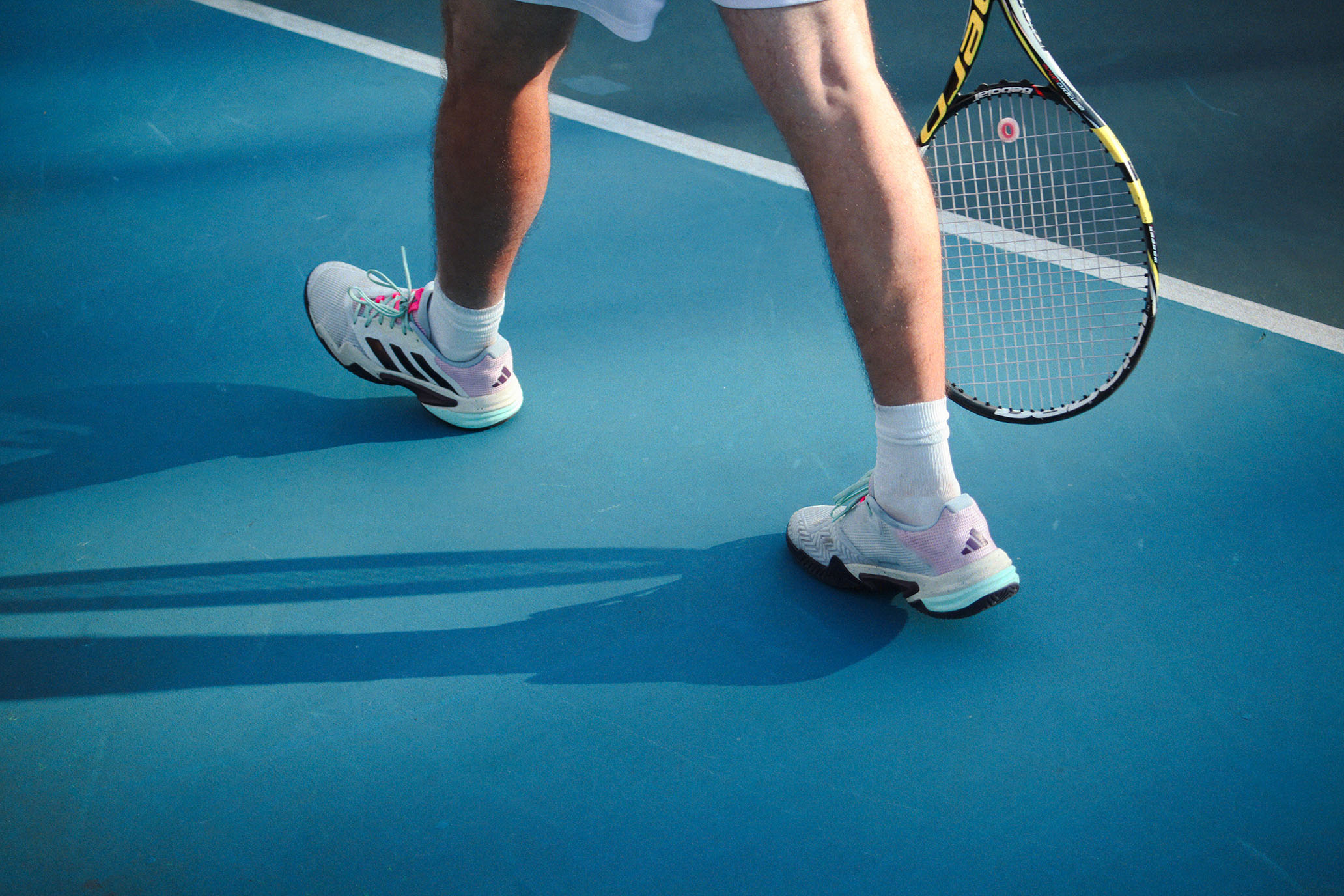

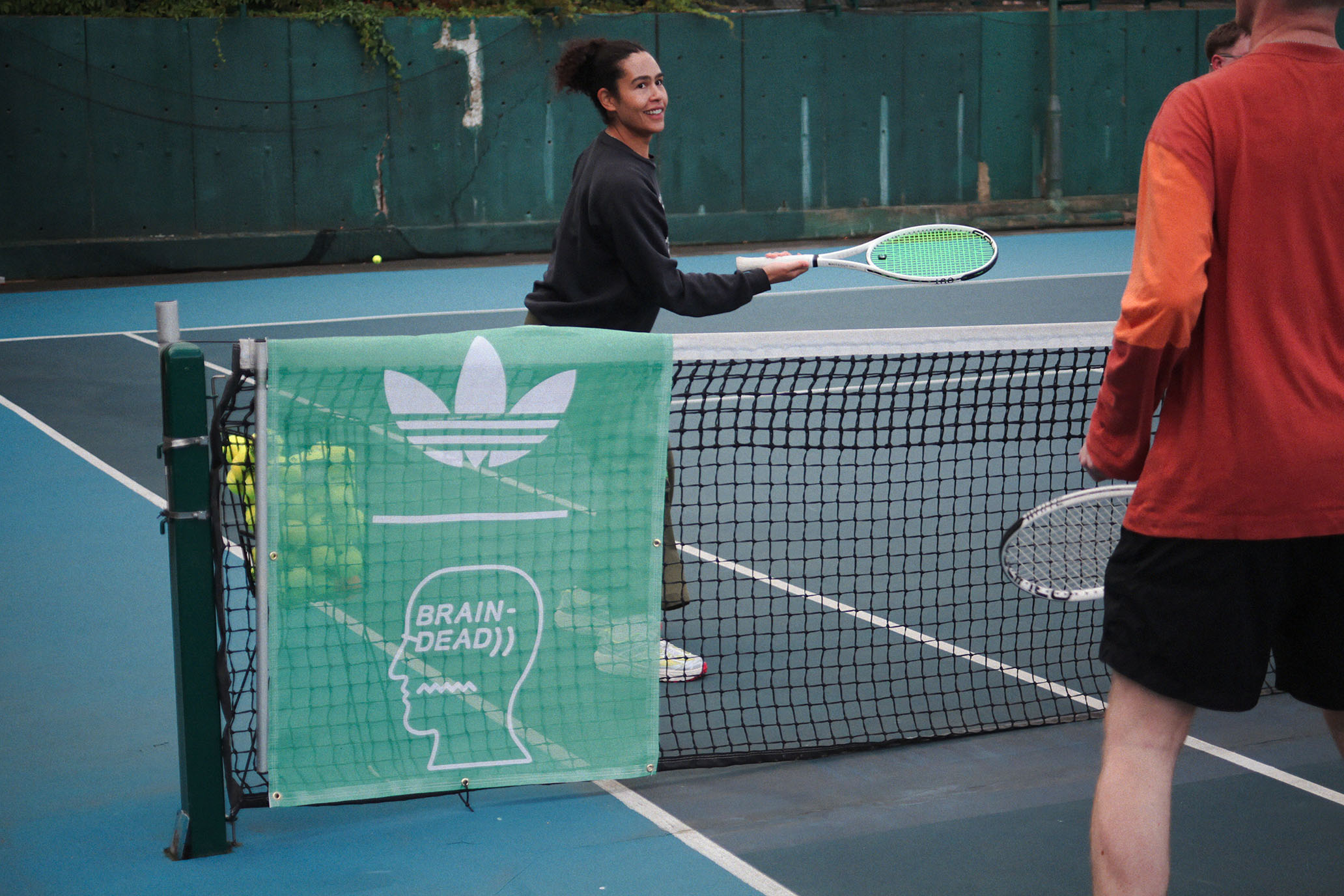

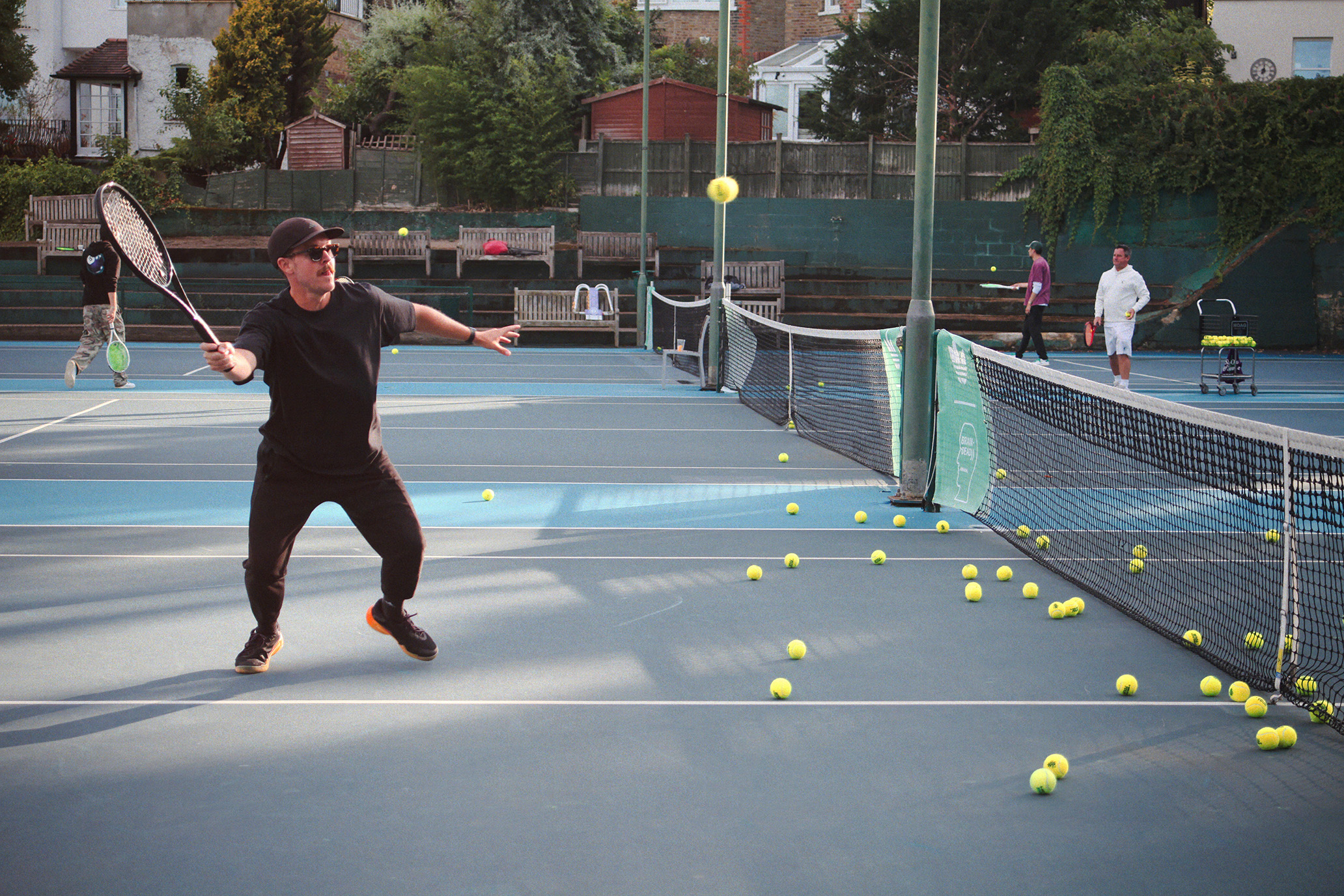

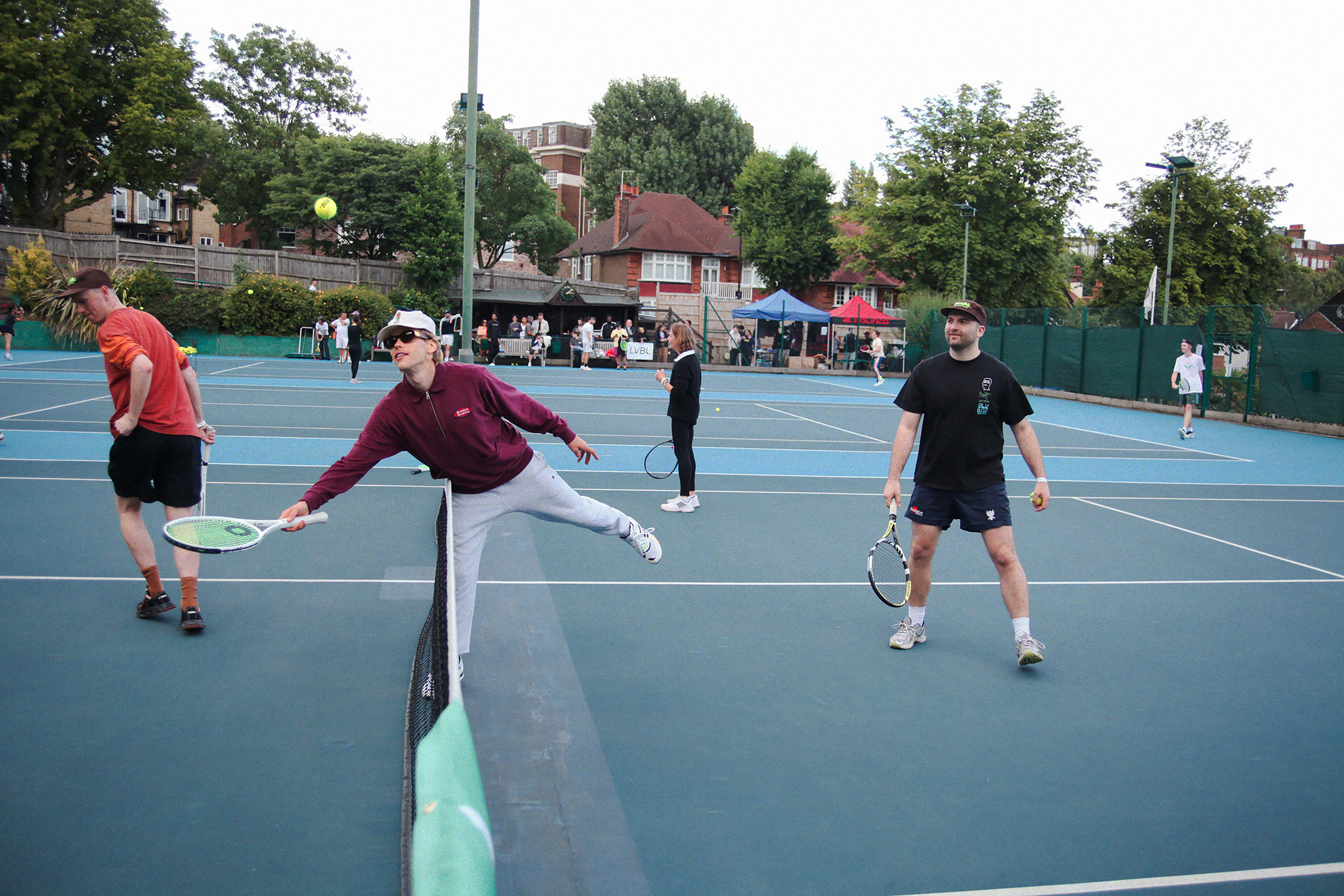

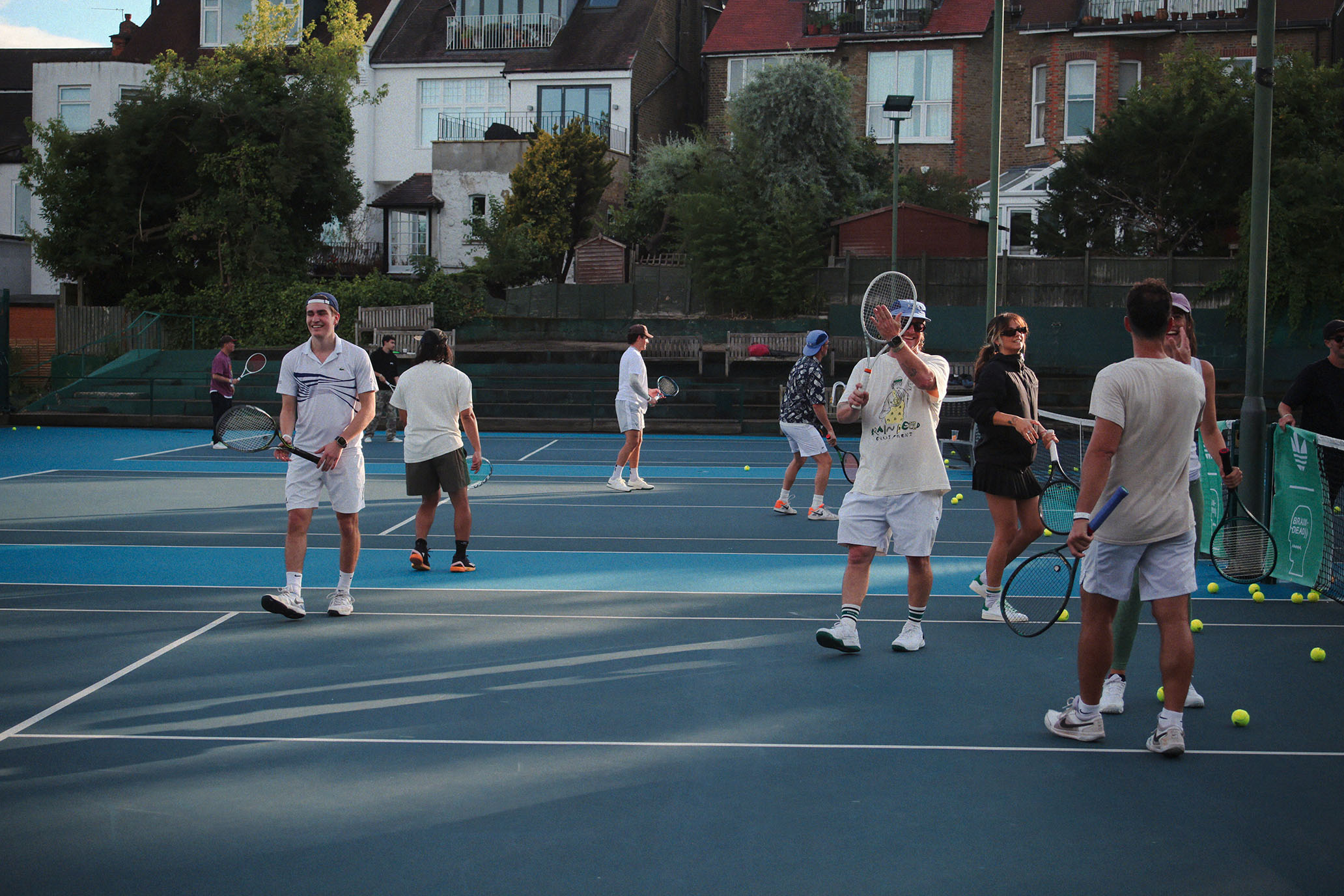

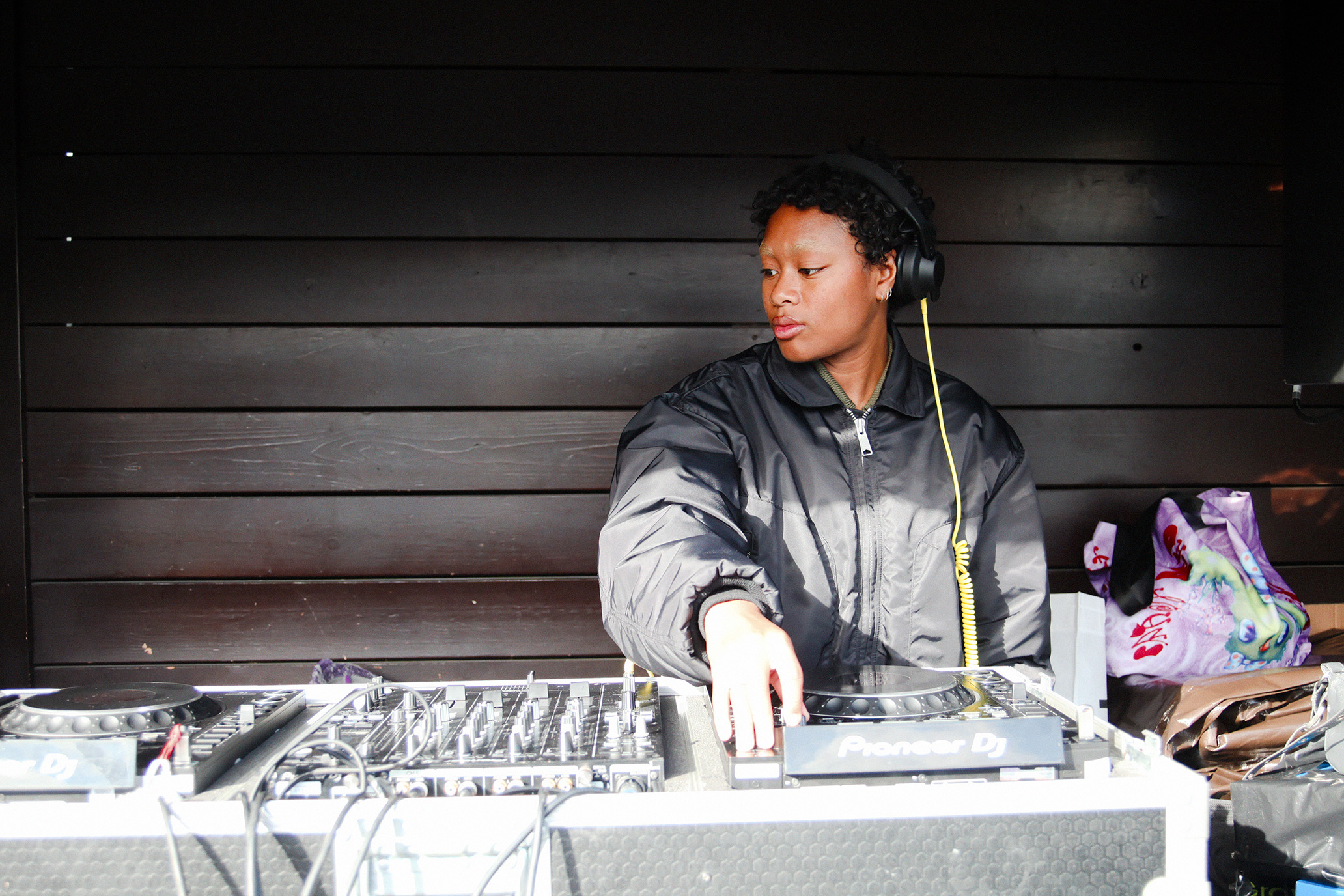

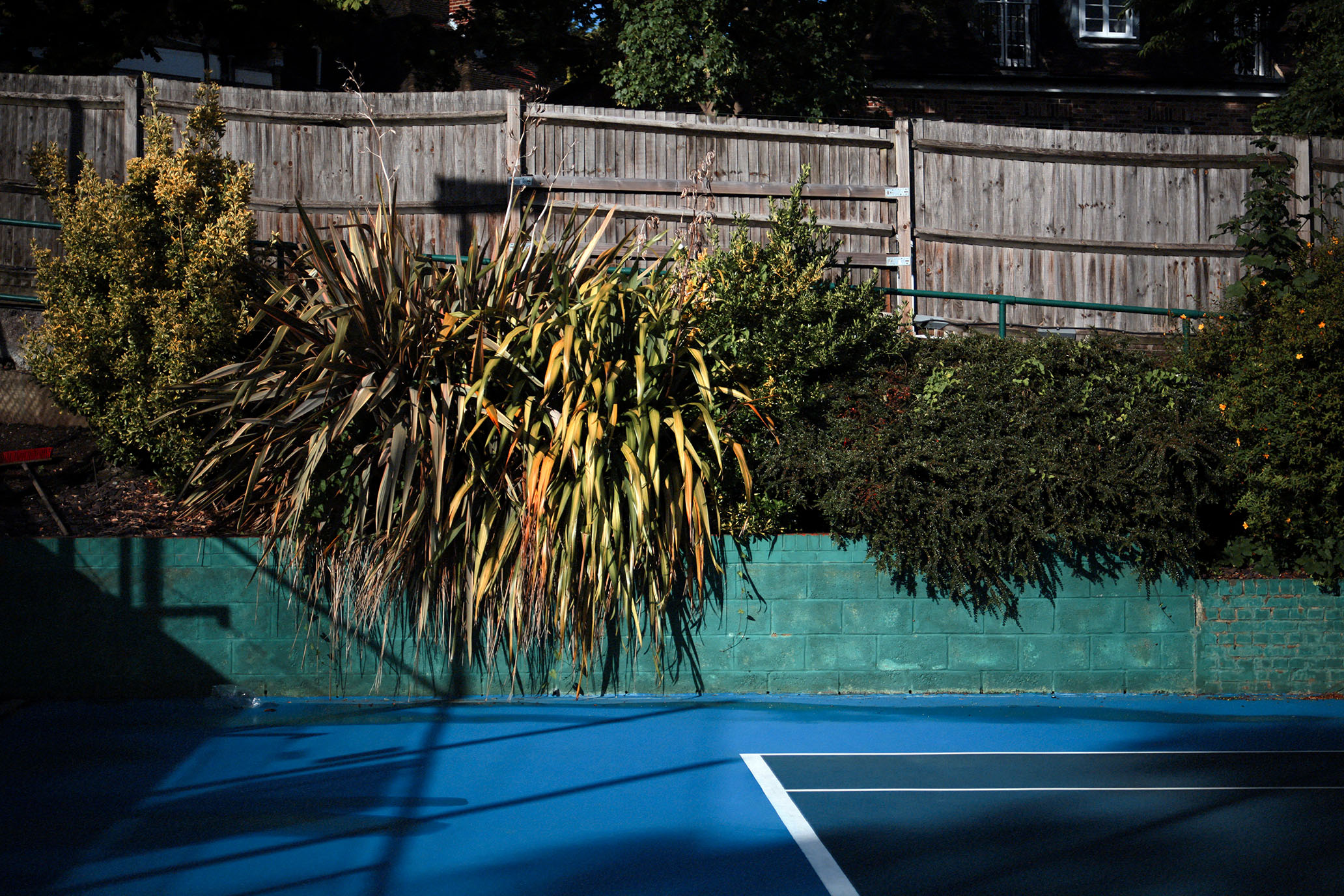

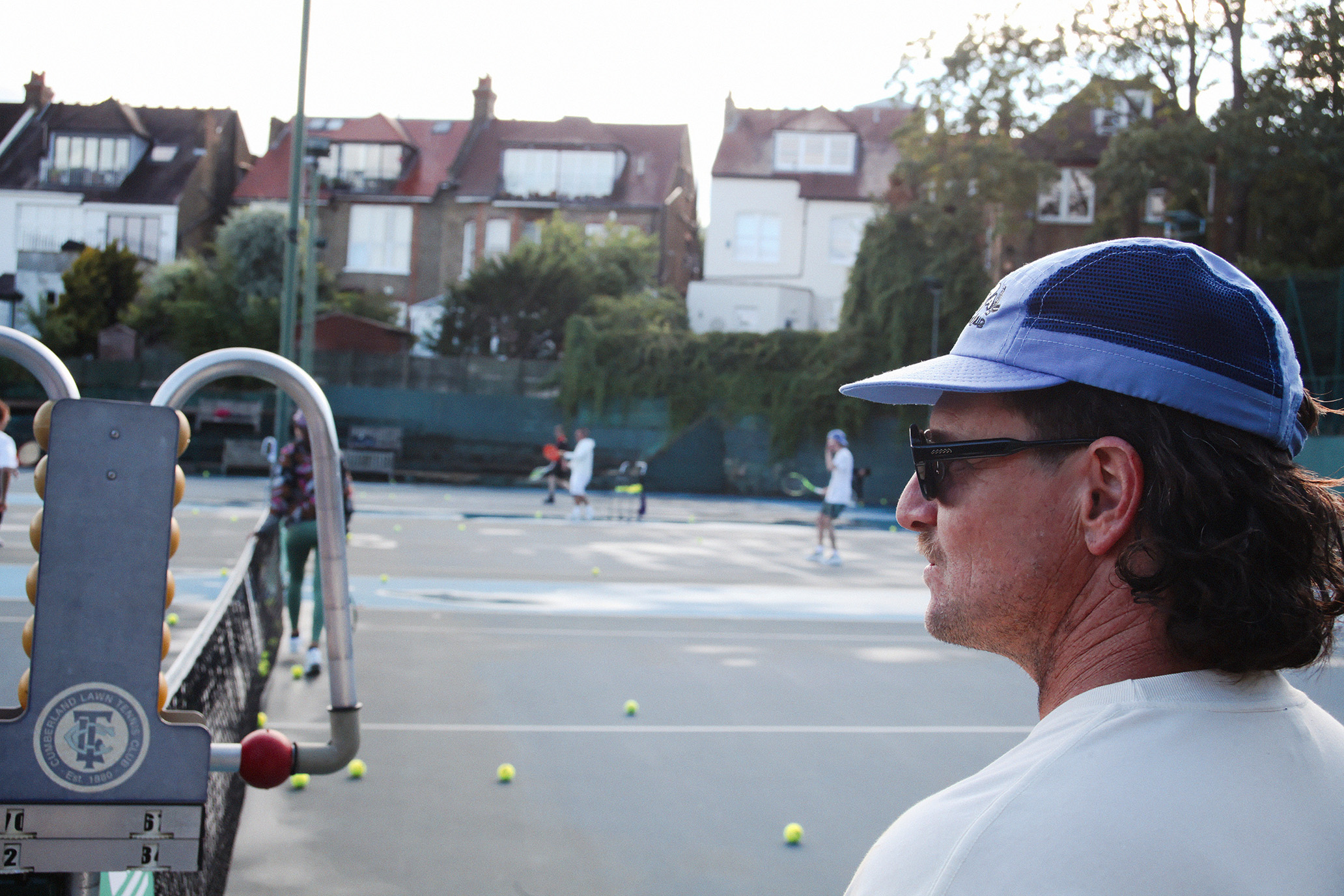

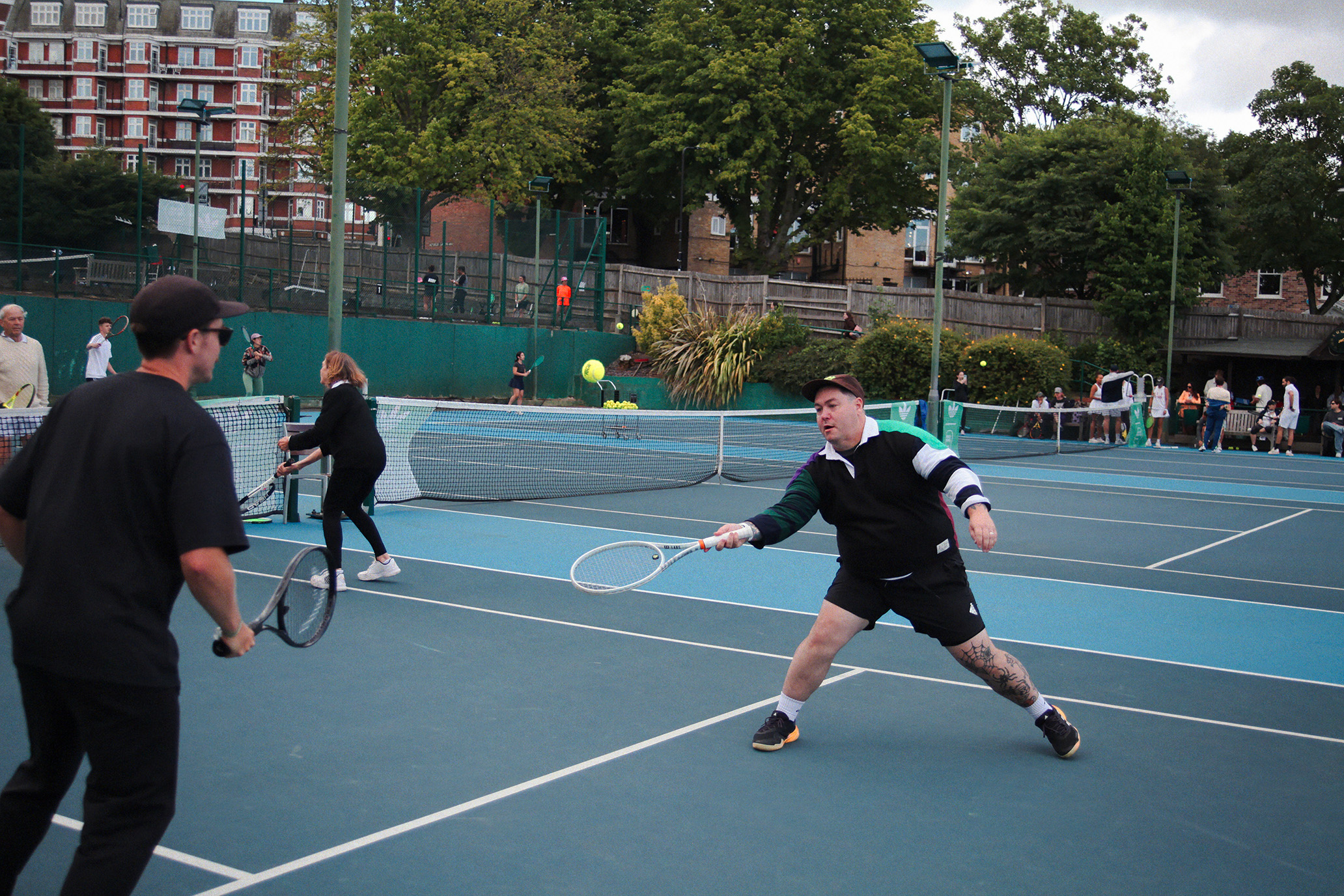

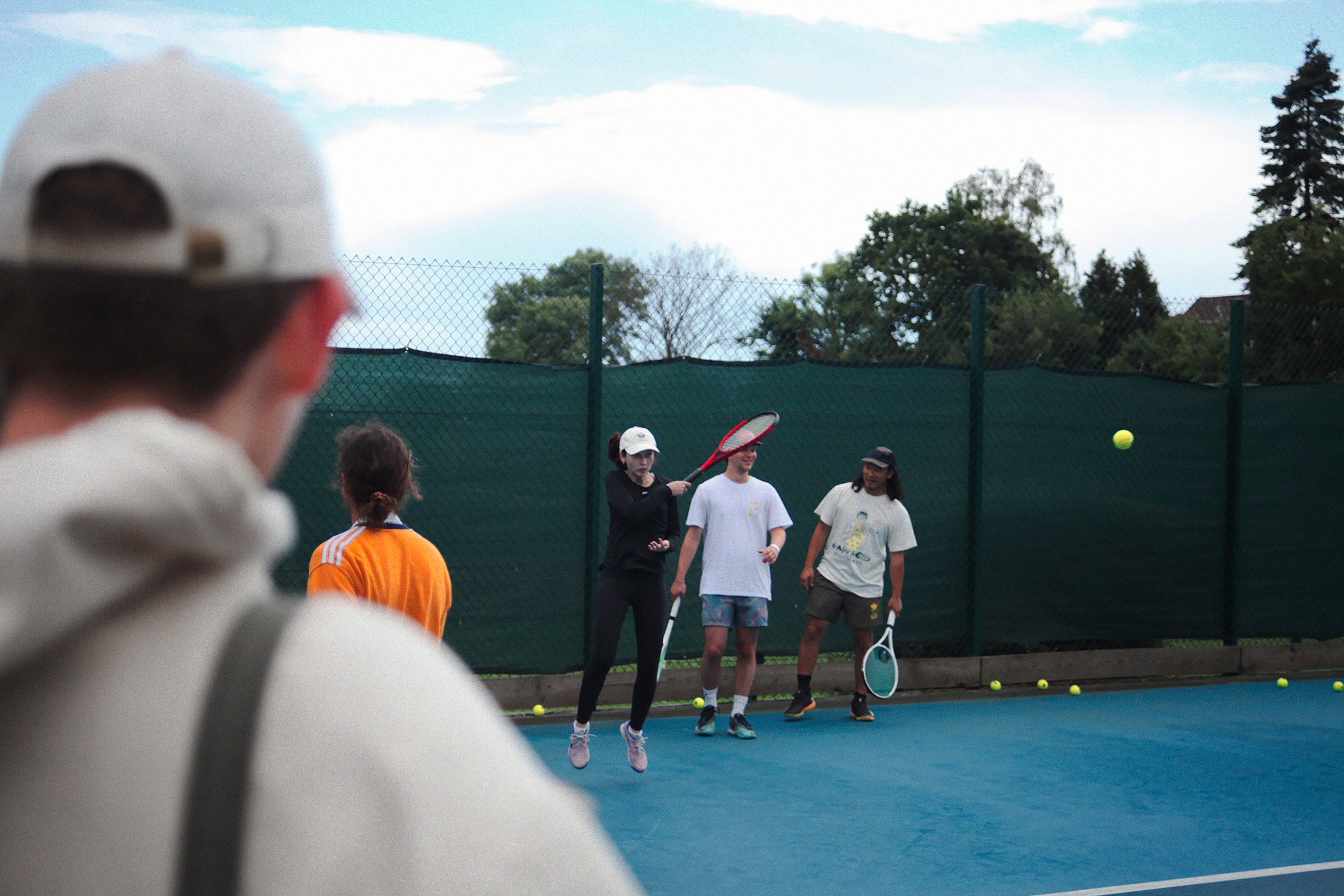

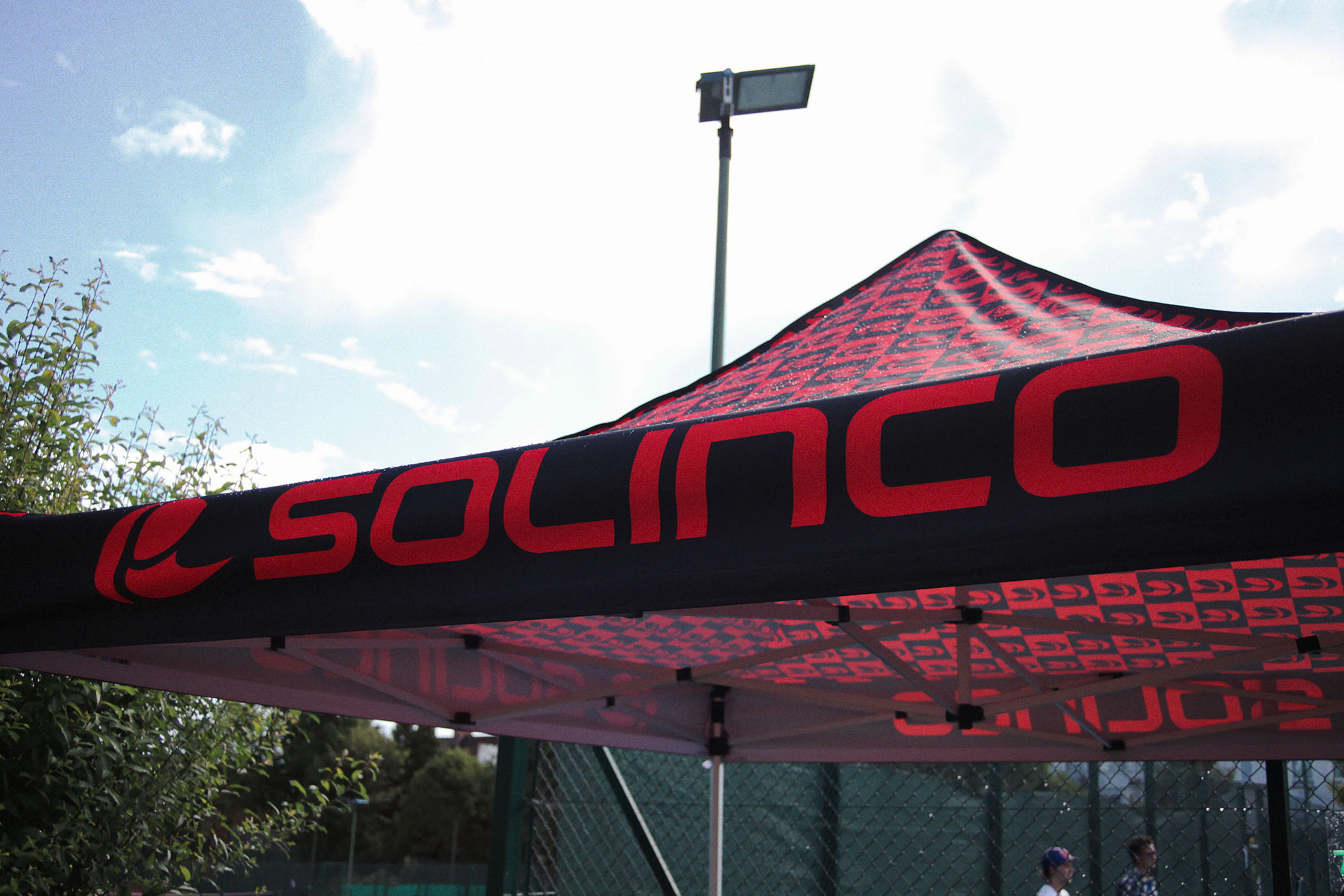

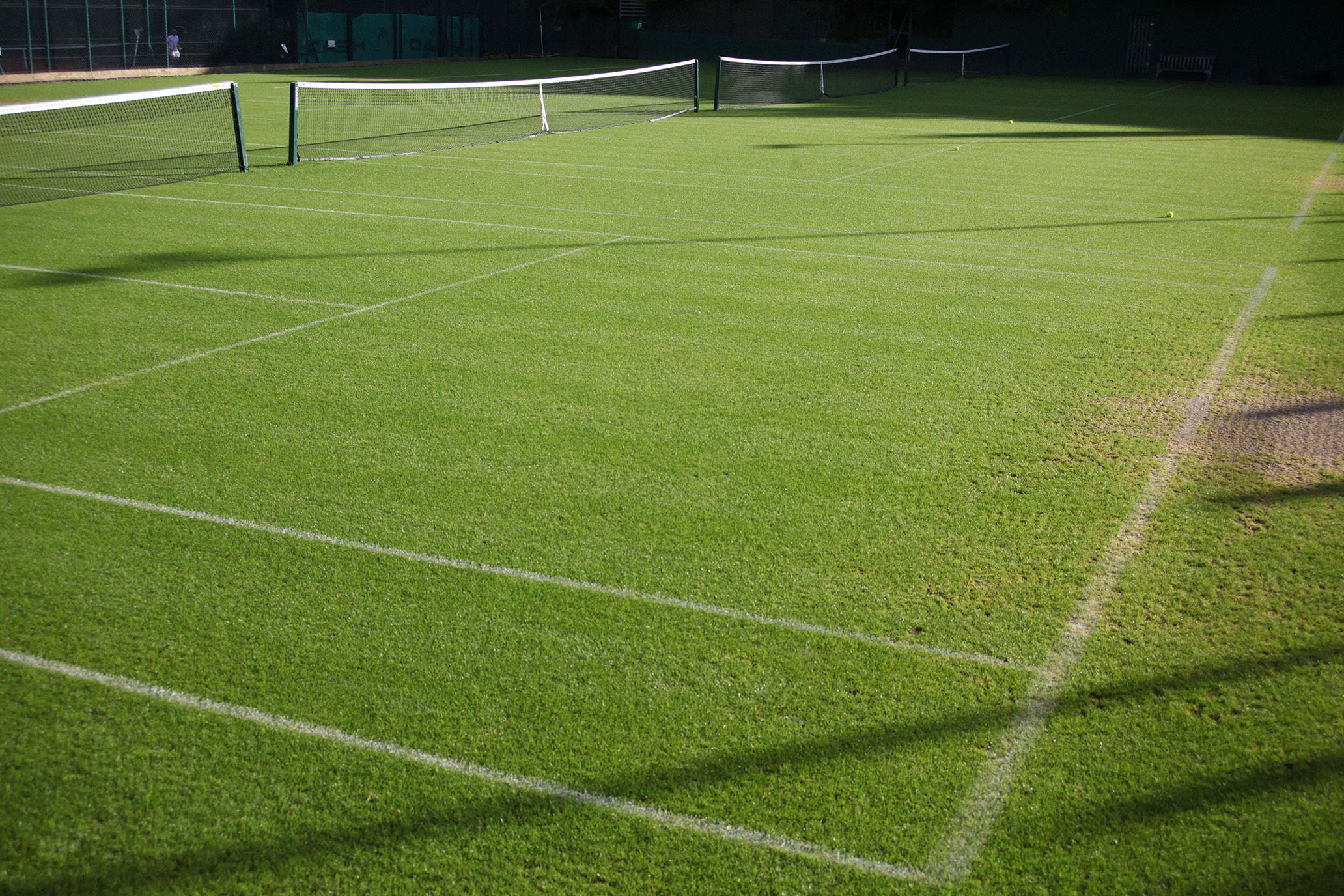

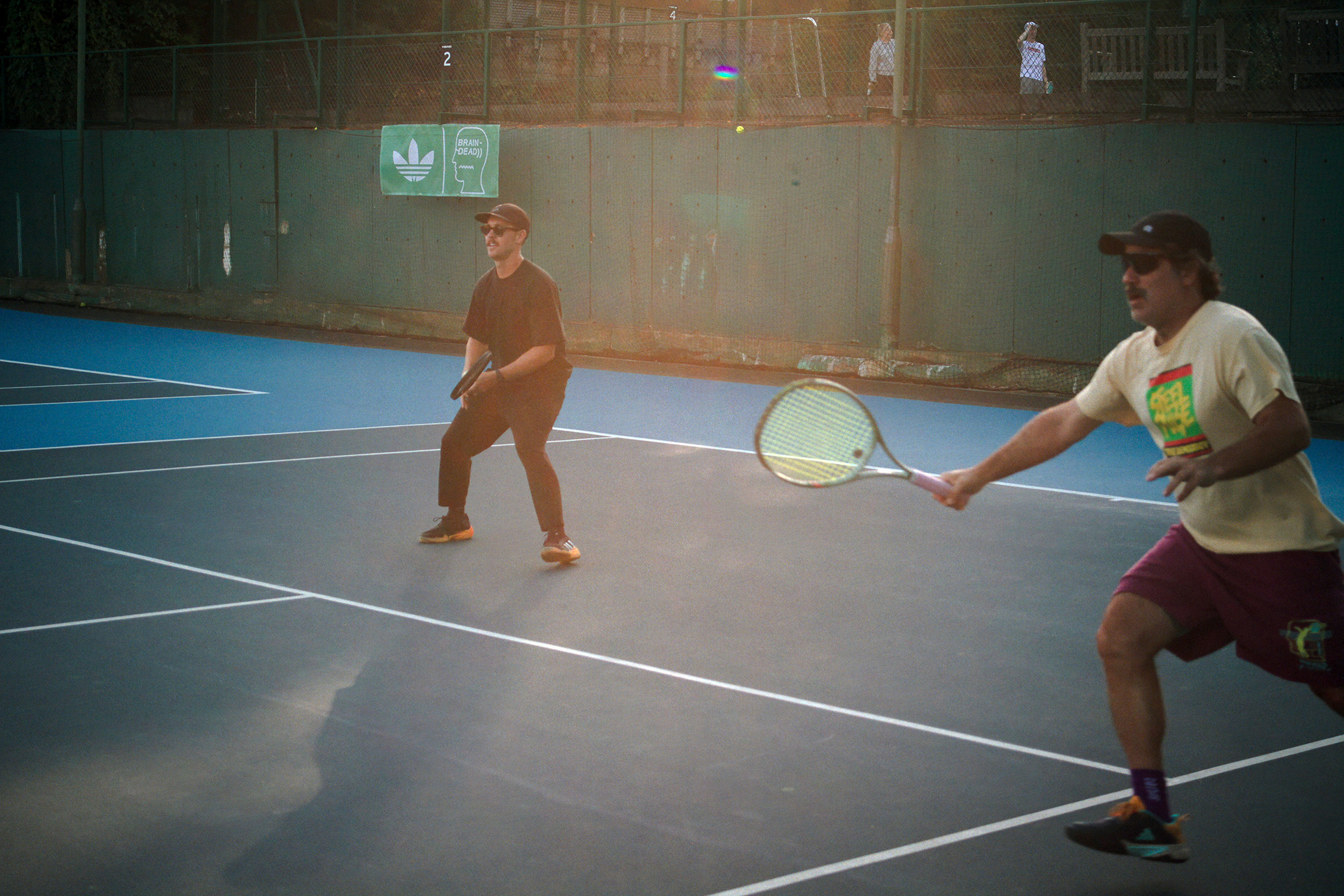

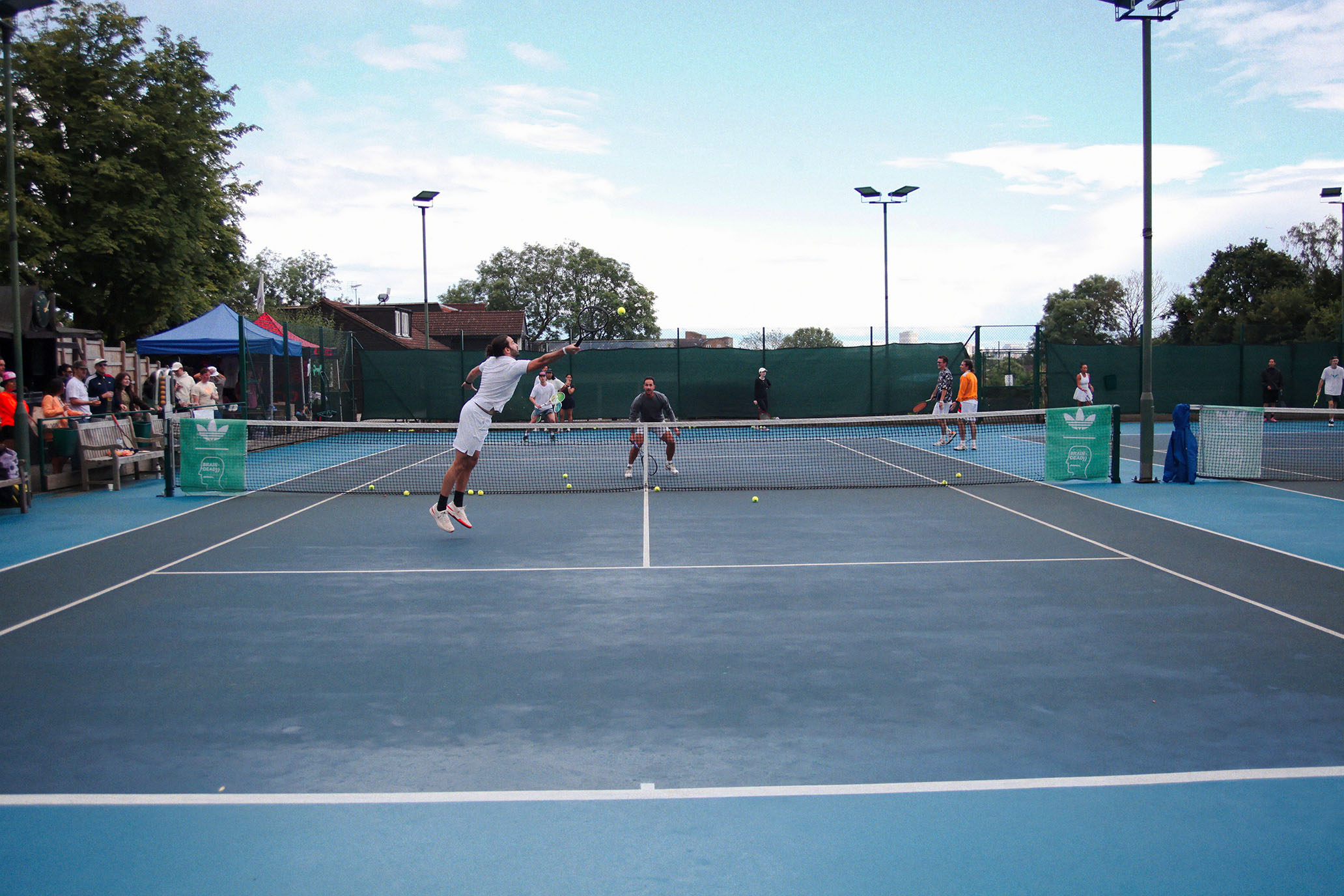

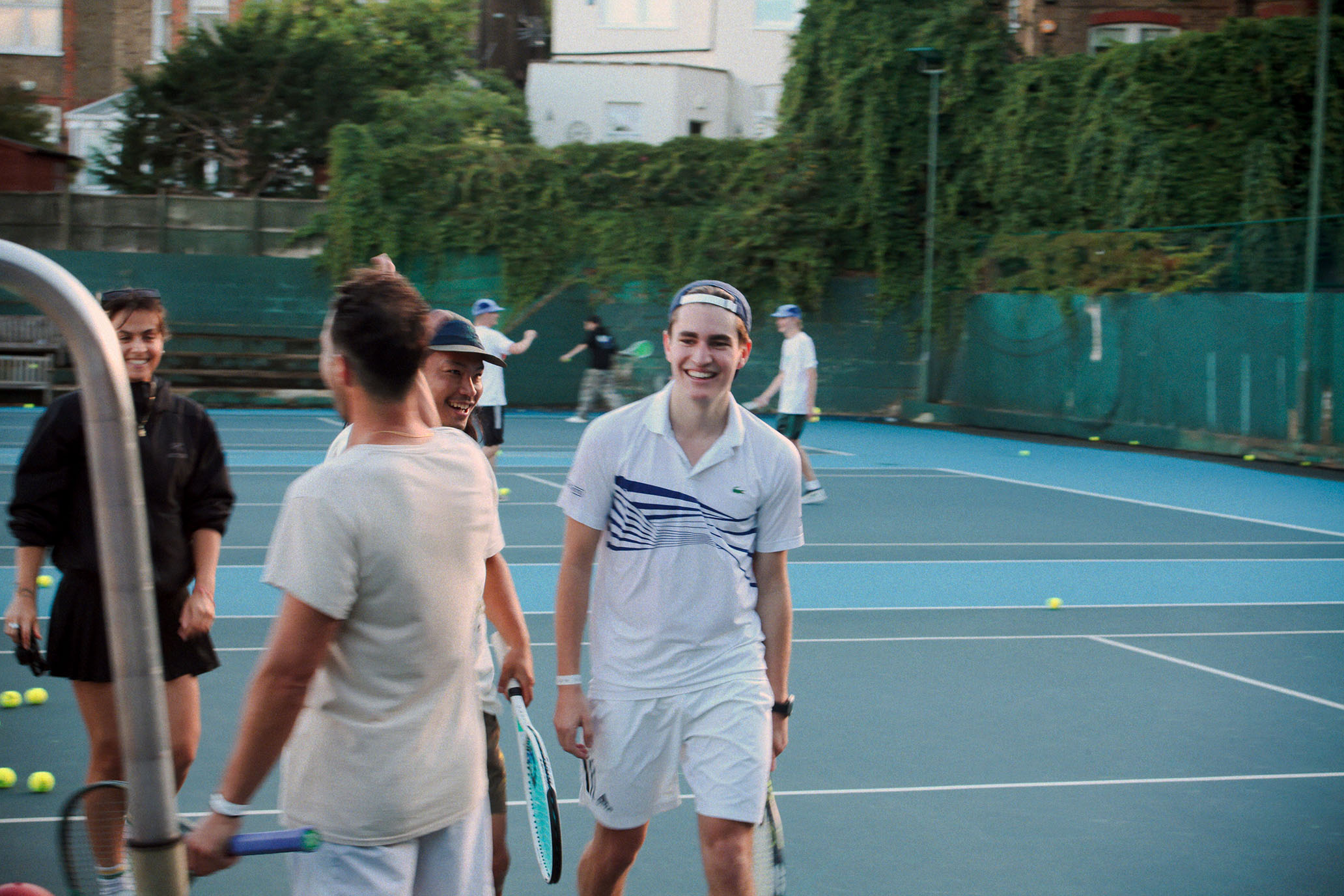

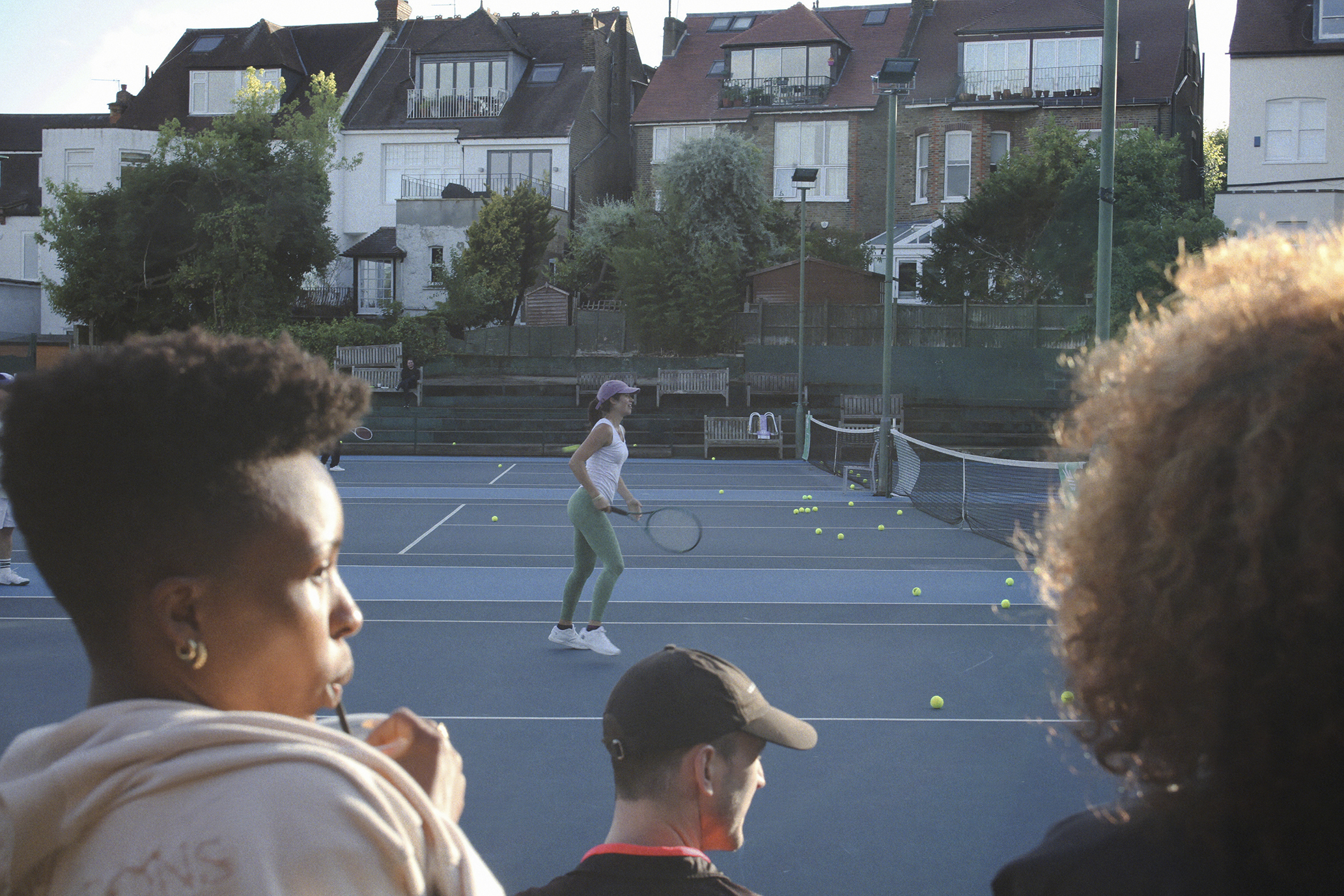

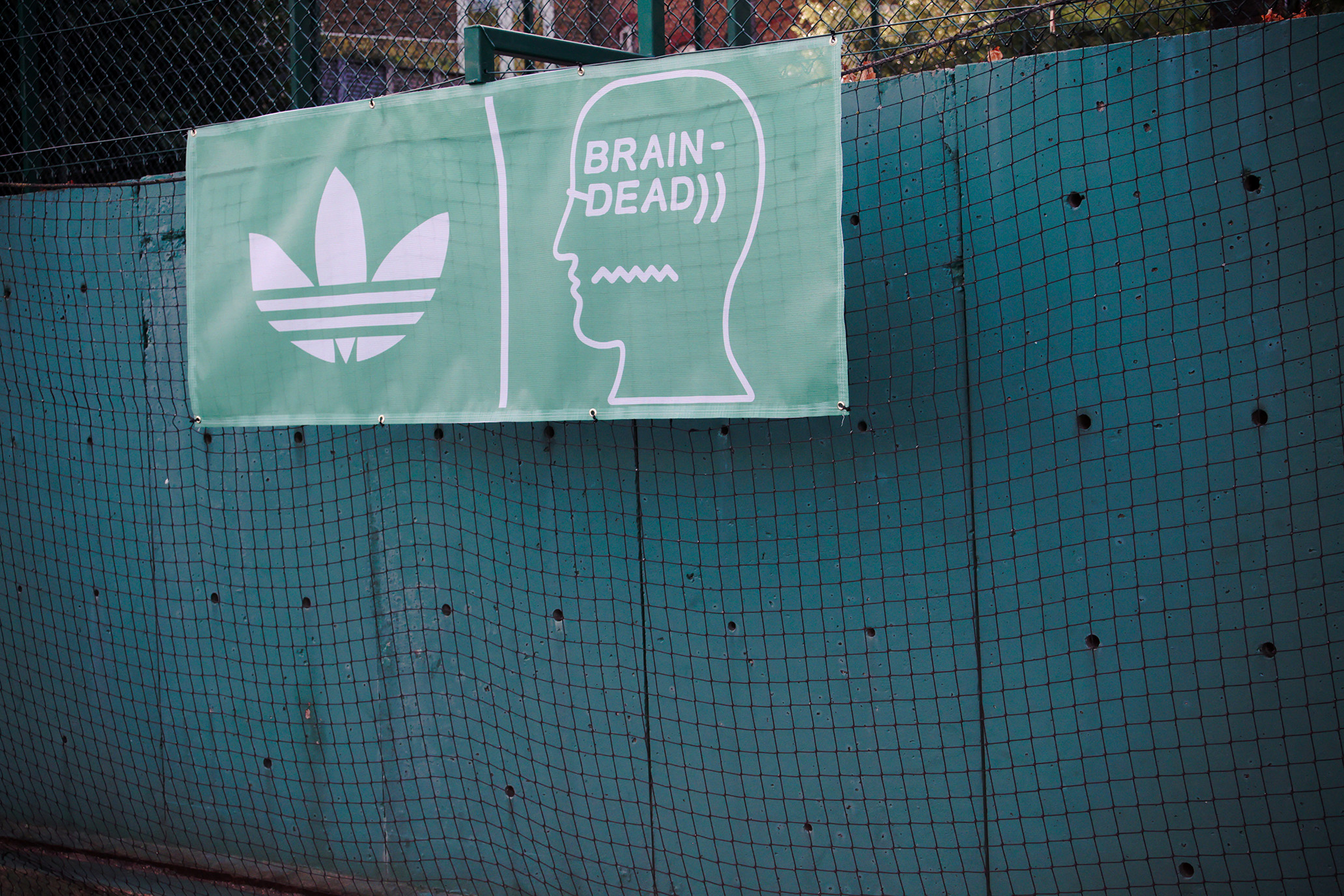


SIGN UP — YOU'RE ONLY AS GOOD AS YOUR SECOND SERVE.
An Avatar of Fluidity and Feel
An Avatar of Fluidity
and Feel
An Avatar of Fluidity
and Feel
There’s an Italian man in the Semis, and it’s not who you’d have expected.
There’s an Italian man in the Semis, and it’s not who you’d have expected.
By Giri Nathan
July 11, 2024
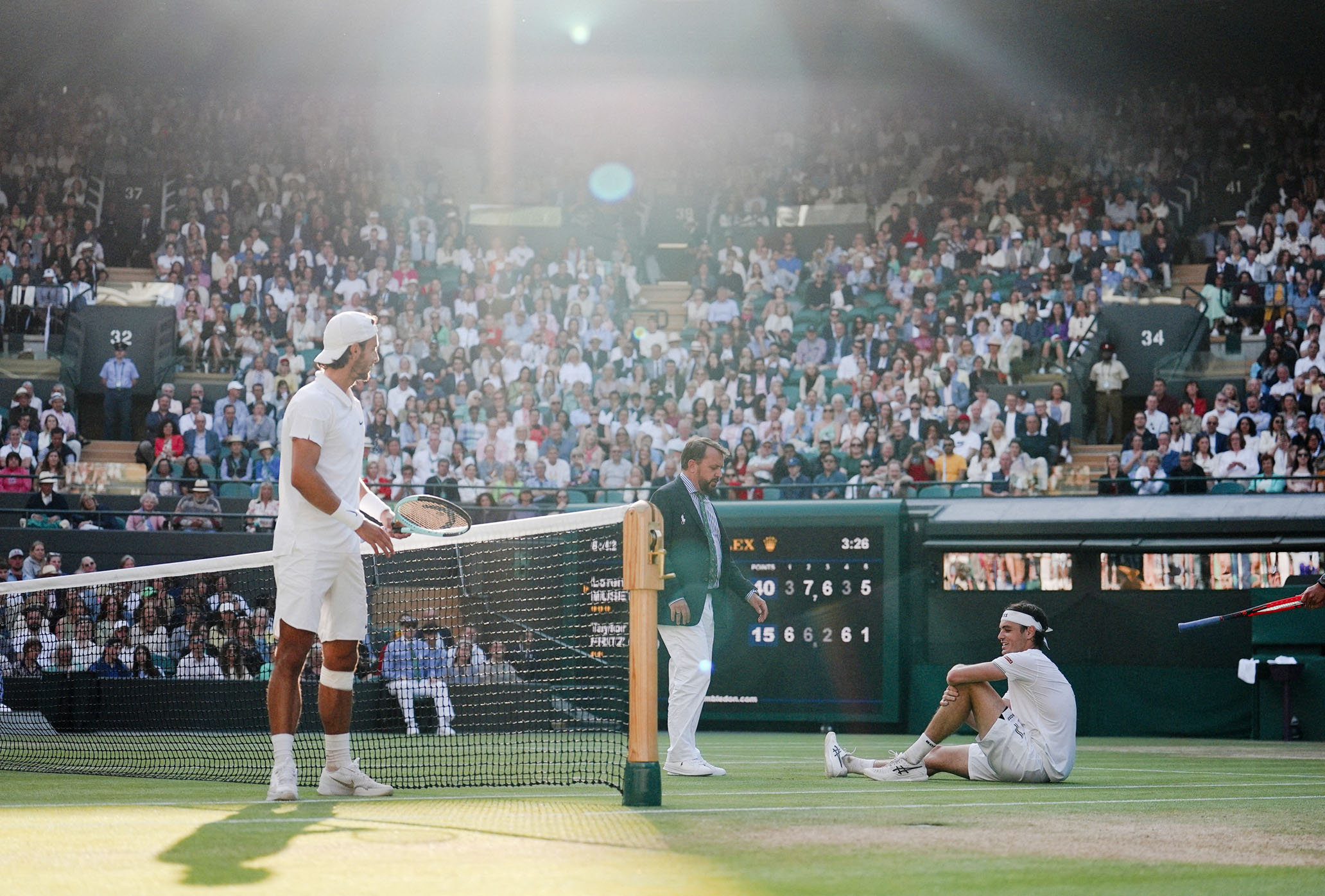
Lorenzo Musetti is left standing after a knock-down-drag-out match against Taylor Fritz. // AP

Lorenzo Musetti is left standing after a knock-down-drag-out match against Taylor Fritz. // AP
Hey, look—not all at once—there’s an Italian man in the Wimbledon semifinals. It is not, however, the Italian man you were expecting to see. It’s probably not your second guess, either. Those two guys slugged it out last week, and Jannik Sinner survived that testy second-round stress test from Matteo Berrettini. Sinner, playing in his first-ever major as the top seed, floated through the next two rounds, never in much of a patch of peril, only for his Wimbledon to be cut short in the quarterfinals by a vengeful octopus. Daniil Medvedev, who, after winning his first six matches against Sinner, had lost the last five in a row, managed to stop the bleeding here on the lawns of SW19. It was an exacting, resourceful performance from the player who lost to Sinner in the Australian Open final despite a two-sets-to-none lead, a reminder that Medvedev is more than talented enough to trouble the two prodigious punks who’ve passed him by in the rankings. Sinner, who looked ashen-faced in the middle of the match and took an 11-minute medical time-out for dizziness, has already pulled out of what would’ve been some pre-Olympics clay warm-up in Bastad next week. But meanwhile, on the other side of the draw, another 22-year-old Italian went where Sinner could not: the No. 25 seed with the whooping ground strokes, Lorenzo Musetti.
Musetti is a born stylist on the court, an avatar of fluidity and feel, and many have hoped he’d close the gap between how fun he was to watch and how good he was at tennis. Early in his career he had a whiff of prodigy about him, entering the top 100 as an 18-year-old in the spring of 2021, but he plateaued over the next year, which he attributed to increased pressure and some post-breakup blues. (He has since become a married father!) He clearly has some skills that bother even the best players, and the statement wins would trickle in every so often, typically on clay: Carlos Alcaraz in Hamburg 2022, Novak Djokovic in Monte-Carlo 2023. (Just don’t ask poor Lorenzo about the two separate instances at Roland-Garros where he won two sets against Djokovic before having the life slowly smushed out of him, boa constrictor-style, in 2021 and 2024.) Amid hard-court struggles, it seemed for a while that Musetti would top out as a clay specialist. He is a true dirtballer, controlling rallies with shape and depth. But he seems to be developing a taste for dirt with grass growing in it, too. He is enjoying perhaps the most consistent grass-court season of anyone on tour, with a semifinal in Stuttgart, a final at Queens Club, and now five more wins in gray London.
There are aspects of Musetti’s game that serve him well on both of the natural surfaces. There’s the movement, which is precise and versatile, nullifying the challenges of each, allowing him to defend well on grass and set up his offense well on clay. He can tweak it as needed. This week he has looked just as comfortable playing in Medvedevian deep court positions as he has playing cat-and-mouse points in the front court. And there’s all the pure talent in his hands. Musetti’s got some unteachable touch, which is most apparent in his drop shots and slices but also shines through in his return of serve. For many a one-handed backhand, the return spells death; see dire entries for “Shapovalov, Denis” and “Tsitsipas, Stefanos.” The ball comes in too hot and heavy to time cleanly, and they lack the added stability of a second hand, so they end up slashing at the serve in desperation, with brutally shanky results. But Musetti is a refreshing counter to this trend, even on grass, where the sliding balls complicate the returner’s task even further. Musetti’s deft hand skills open up a whole world of chip returns, letting him block the ball into play with little risk of error and still keep the ball at an awkward height and depth for the opponent.
Those returns tormented Taylor Fritz throughout their five-set quarterfinal on Wednesday. Fritz, who has had to deal with Novak and Rafa misery in all four of his previous major quarterfinals, probably felt cool relief at the sight of a mere Musetti across the net. But he never found a workable solution for the Italian’s variety, for the slice and depth-related high jinks, backed up by some standard-issue baseline bashing. Musetti often liked to chop the ball shallow in the court, daring the net-averse American to move forward and dance at the net. It was the right tactic against Fritz, who has improved his movement throughout his career but won’t be confused for a natural all-court player; just keep him scrambling, never let him feel balanced, and he won’t be able to dial in those technically flawless ground strokes. Musetti said as much afterward: “With a good baseliner like Taylor, if you play every time flat, I cannot win a point. I mean, I’m playing his game. So probably it was the strategy to try to mix every ball and try to lead the game.” He noted that variety has been fundamental to his tennis since he was a kid, and that he never liked being—bless the curious English of tennis players—“mono-automatic on the court.” Musetti saved his best for the fifth set, which he blew open with a double-break before securing the 3–6, 7–6, 6–2, 3–6, 6–1 win.
I would’ve bet good money that Musetti’s first major semifinal would come in Paris, but he’s done it here instead, having survived an in-form Fritz and the service hellfire of Giovanni Mpetshi Perricard in the last two rounds. The dubious reward for his newfound grass-court brilliance: a well-rested Novak Djokovic, who erased Holger Rune in the fourth round and got an Alex de Minaur walkover instead of a quarterfinal. Musetti will need something new for that familiar opponent. The Fritz game plan would not be so effective against Djokovic, who, despite being a month removed from meniscus surgery, is still scooting and sliding around the court the way he has for years and is far more practiced at finishing points at the net. Musetti will have to rummage around amongst his many options and find something else. And if he somehow manages to win two sets, he’ll have to stay cool and block out any intrusive memories of how that’s gone for him, historically. Woof!

SIGN UP — YOU'RE ONLY AS GOOD AS YOUR SECOND SERVE.
Leave Blood on the Court
Leave Blood on the Court
Leave Blood on the Court
It is always possible to find an Australian-related tennis anniversary.
It is always possible to find an Australian-related tennis anniversary.
Joel Drucker
July 10, 2024
Leave Blood on the Court
Leave Blood
on the Court
It is always possible to find an Australian-related tennis anniversary.
It is always possible to find an Australian-related tennis anniversary.
Joel Drucker
July 10, 2024
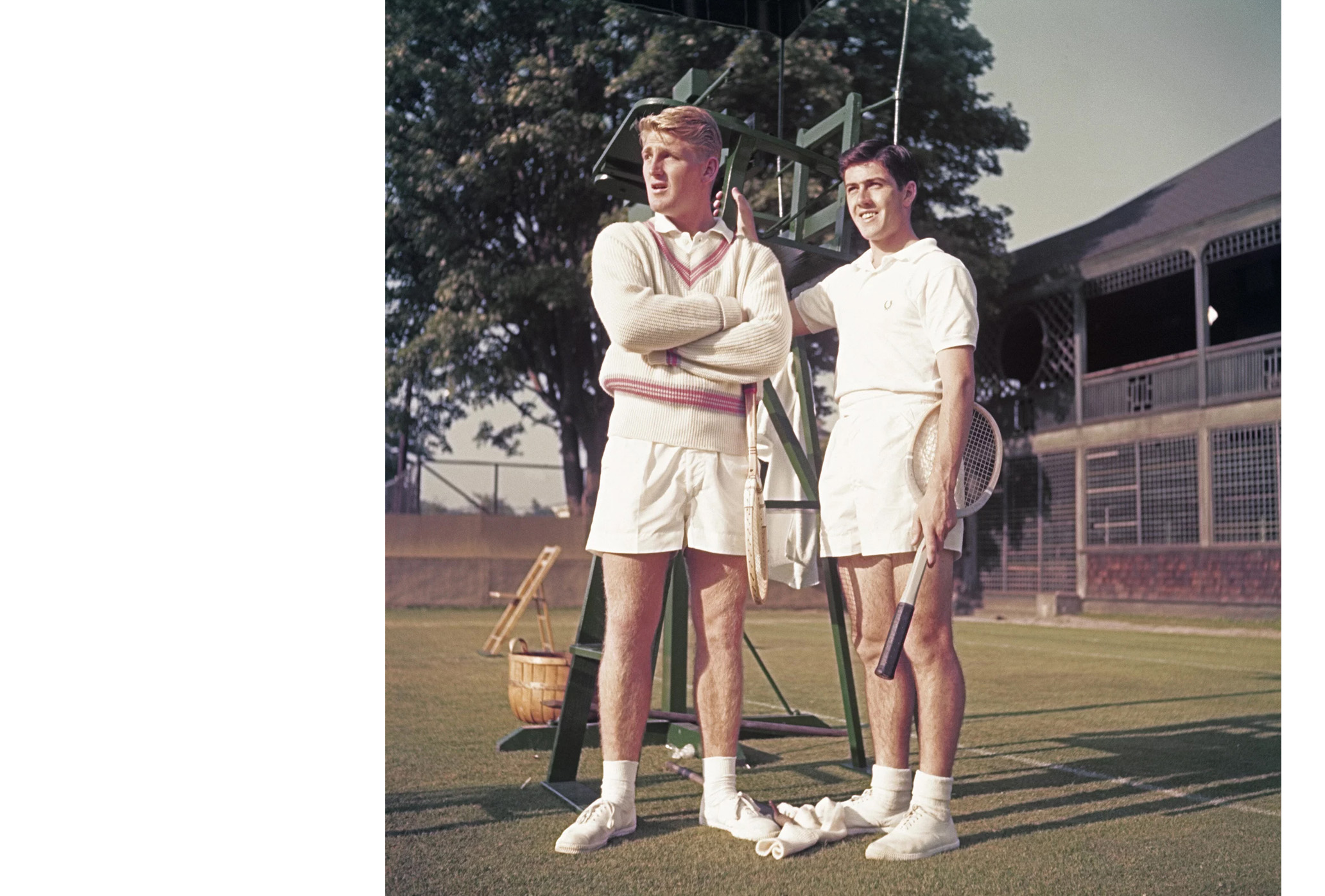
Lew Hoad and Ken Rosewall photographed by Slim Aarons // Getty
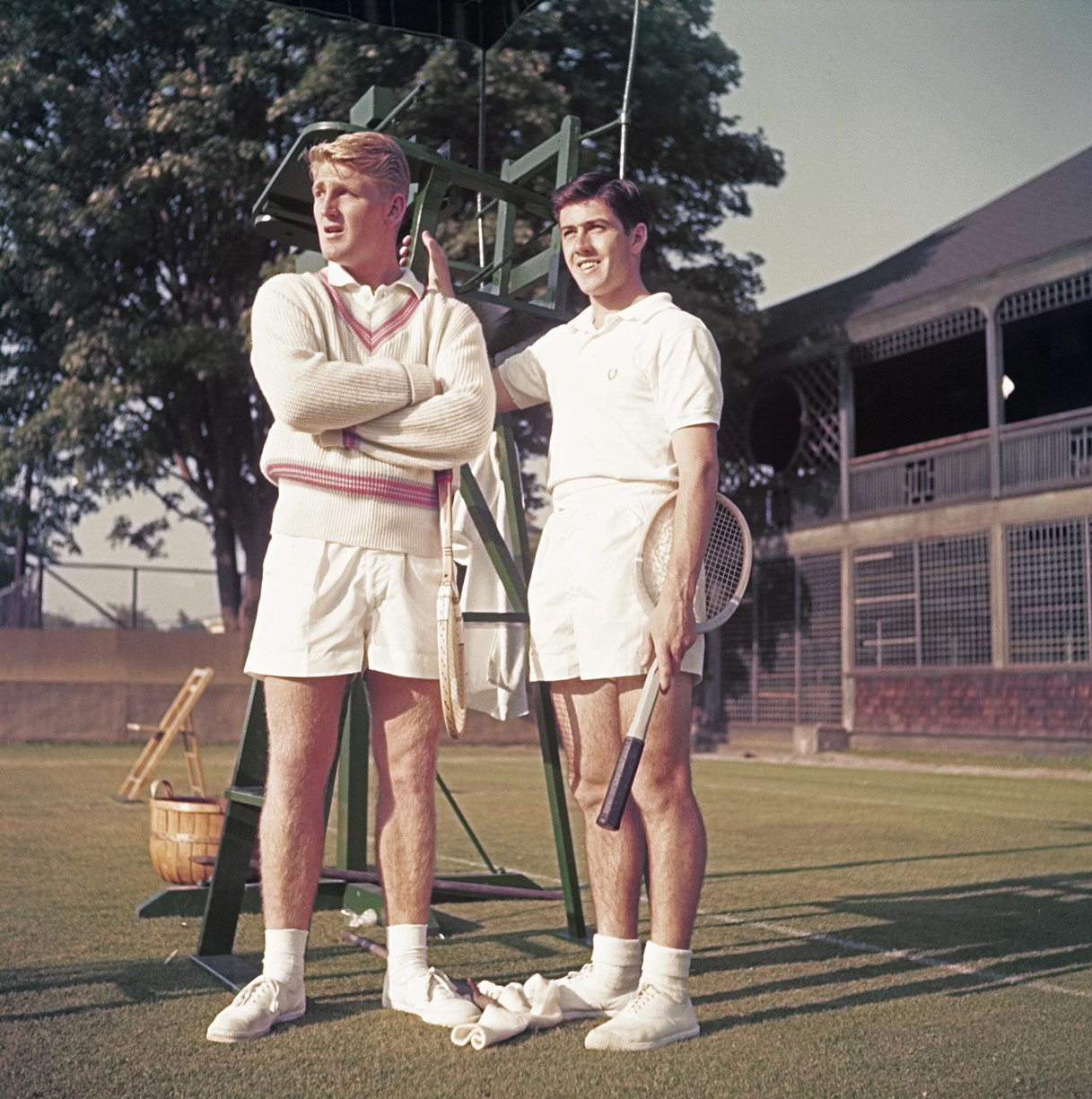
Lew Hoad and Ken Rosewall photographed by Slim Aarons // Getty
On a rainy Friday night in SW19, a five-minute walk from the All England Club, approximately 250 Australians gathered for a mid-tournament party conducted by Tennis Australia to celebrate a number of Wimbledon anniversaries. Festivities and history: a perfect Aussie tennis combo.
It’s been 20 years since Rennae Stubbs won her second women’s doubles title; 30 years since the Woodies earned their second of six at the All England Club; 40 years since Wendy Turnbull took the mixed; 50 years since Ken Rosewall reached his fourth Wimbledon singles final, the John Newcombe–Tony Roche duo won the Wimbledon men’s doubles title for the fifth time, and Evonne Goolagong took the women’s doubles; 60 years since Roy Emerson’s first of two singles victories, Fred Stolle captured the men’s doubles, and Margaret Smith Court and Lesley Turner Bowrey earned the women’s doubles. Turner Bowrey and Stolle in ’64 also won the mixed.
Those accomplishments were the party’s theoretical news hook. Of course, it’s always possible to find an Australian-related tennis anniversary. Many subcultures have their certain exemplars. In winemaking, there’s France. In painting, Italy. In tennis, no nation more than Australia personifies tennis’ supreme values. Emerson, winner of a men’s record 28 Grand Slam titles, articulates those principles as well as anyone: “Leave blood on the court or don’t bother playing,” goes one signature recommendation from the man lovingly nicknamed “Emmo.” Another addresses sportsmanship: “If you’re injured, don’t play. But if you’re not injured, there are no excuses.” And one particularly cutting comment from this friendliest of nations: “I have never played him when he was well.” But in the bigger picture, in the world of Australian tennis, words always take a back seat to action.
Less than 12 hours after attending Friday night’s party, I engaged in one of my favorite Wimbledon rituals. Many a Wimbledon morning, I’ll arrive on the grounds of the All England Club sometime between 8 and 10, take a seat on the vacated Centre Court, put on my headphones, listen to some personally meaningful music, and ponder the heart and soul of tennis. As Newcombe likes to say, “Centre Court is where you’ll be asked all of life’s questions.”
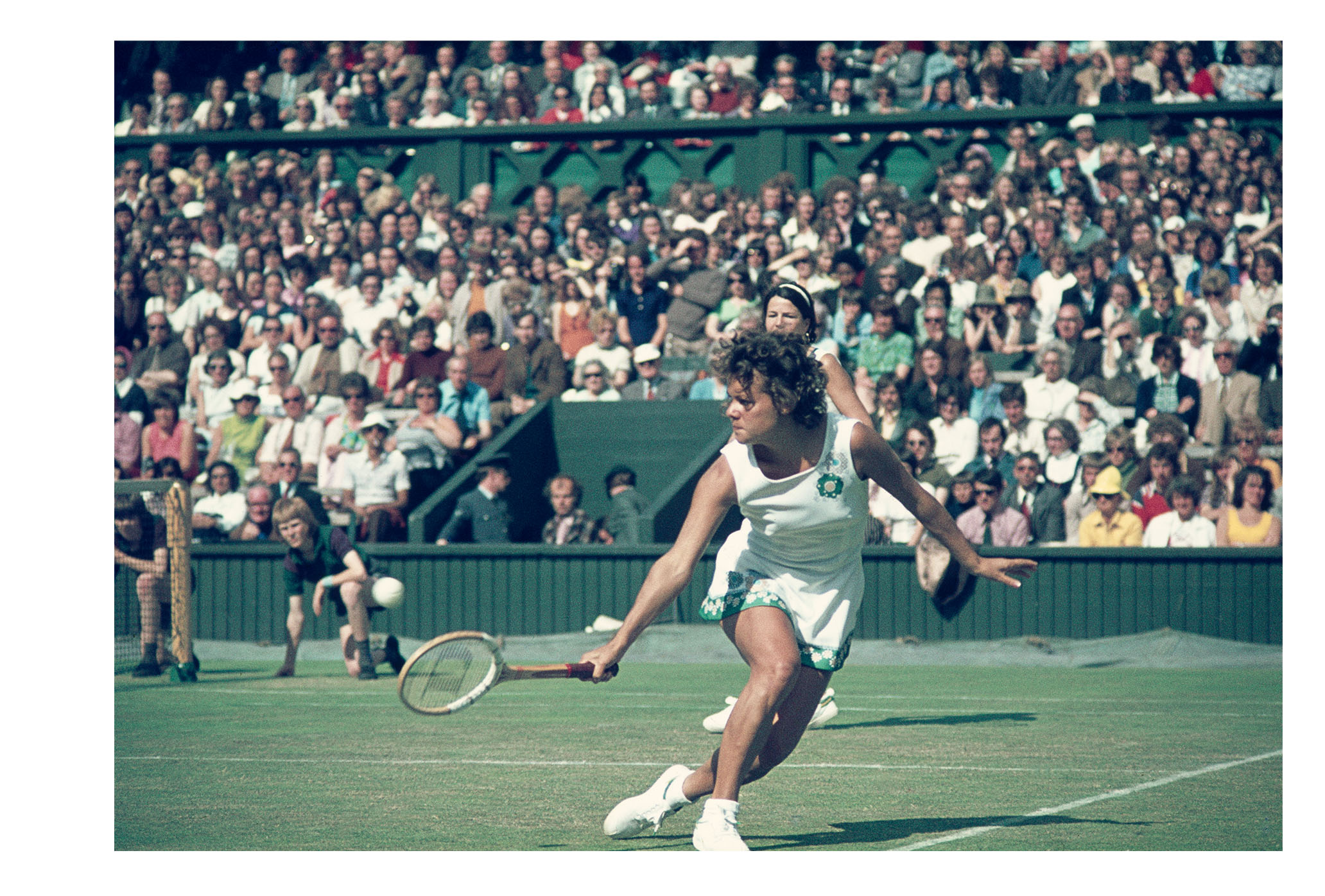
Evonne Goolagong at Wimbledon in 1974, when she won the doubles with Peggy Michel. // Getty
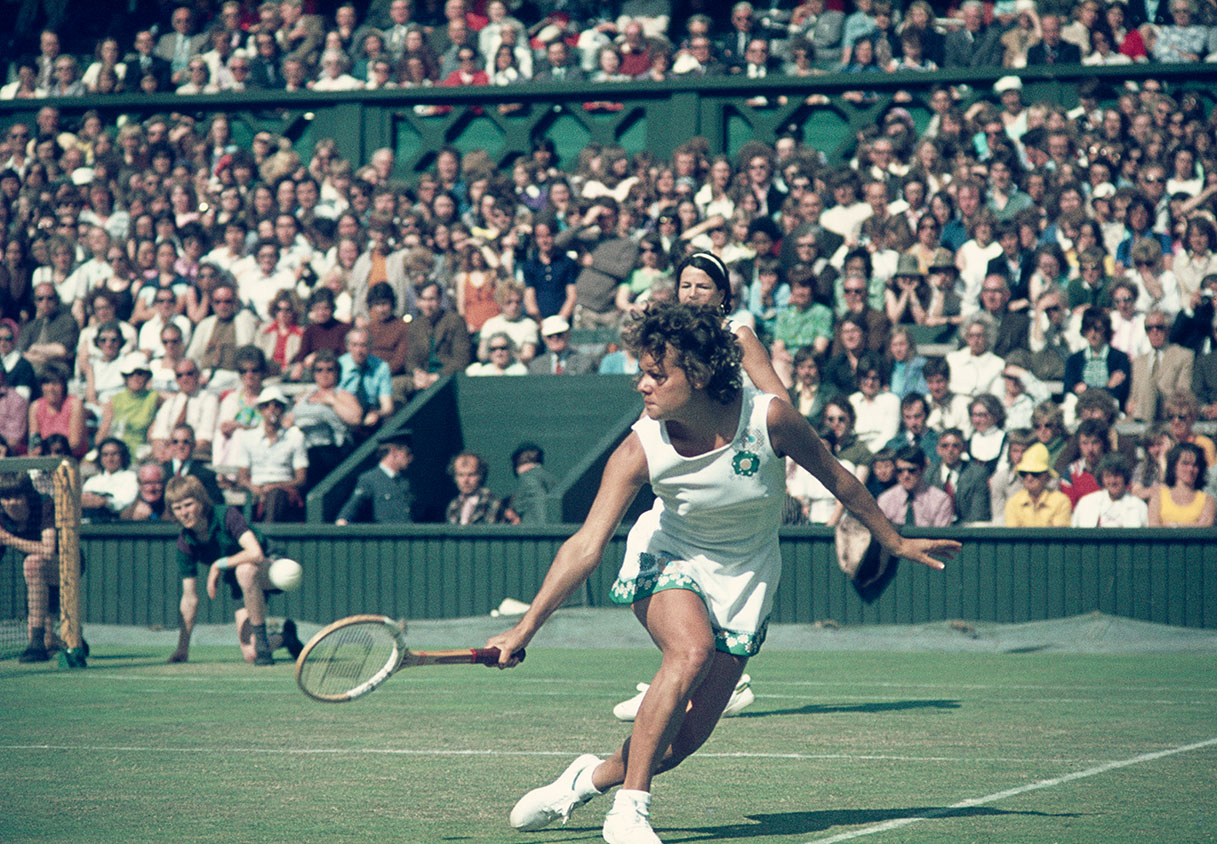
Evonne Goolagong at Wimbledon in 1974, when she won the doubles with Peggy Michel. // Getty
In the wake of Friday’s party, I clicked on the song “Cast Your Fate to the Wind,” then headed 71 years and nearly 10,000 miles southeast from contemporary Wimbledon. The year was 1953, and a 14-year-old boy on a farm in Queensland listened on a transistor radio to the heroics of another Australian teenager, this one from Sydney. The younger lad’s name was Rod Laver, taking in the great deeds of Rosewall, who at the age of 18 won titles that year at both the Australian Championships and Roland-Garros.
These two super-geniuses were present at Friday night’s party; Laver now 85, Rosewall 89. Laver is the four-time Wimbledon champion who also earned two calendar-year Grand Slams. Rosewall is the four-time Wimbledon finalist who ranks with Rafael Nadal and Pete Sampras as the only men to have earned majors in their teens, 20s, and 30s. The Laver-Rosewall rivalry spans hundreds of matches and thousands upon thousands of dazzling sequences and shots.
Though Laver won more often, in their finest battle, Rosewall emerged the victor. It happened in May ’72, at the WCT Finals, a tournament then considered even more prestigious than the current ATP Finals. Held in Dallas, the WCT tournament carried an unprecedented reward of $50,000. It also aired on NBC, at the dawn of tennis receiving significant airtime. Over the course of nearly four hours, with 21 million people watching, the two covered every possible inch of the court and closed out the match in a fifth-set tiebreaker—first man to seven points. With the 33-year-old Laver serving at 5–4, the 37-year-old Rosewall struck two glorious backhands—his signature shot—and extracted a return error from Laver to win the prize.
Friday night, Laver recalled his early teens. “I listened to what Ken was doing and thought, ‘I want to do that,’” he said. As he came of age, Laver modeled his game after Rosewall’s peer Lew Hoad. A few years later, the boy named Rod earned his way onto the traveling Davis Cup squad, where one common task was to squeeze orange juice, and another was to spend 8 to 10 hours a day at work—everything from a long run to five-set practice matches to two-on-one drills, doubles, and, as night fell, a series of sprints.
In his newly published and highly engaging book The Fox, a biography of Harry Hopman, Australian tennis’ head honcho from the ’30s through the ’60s, Aussie journalist Michael Sexton writes, “What they shared was peak physical fitness, an adherence to sportsmanship and a zeal for the contest.”
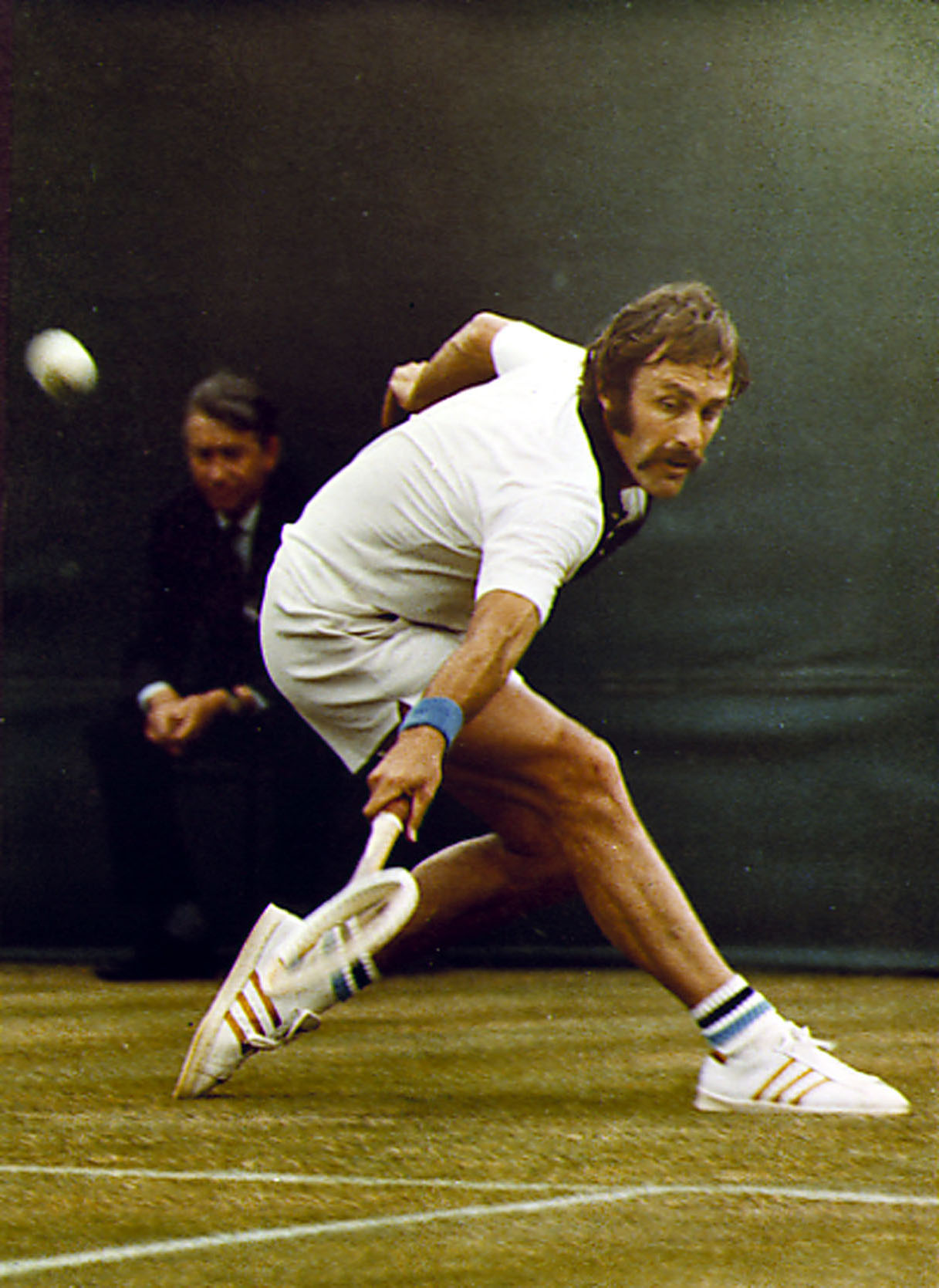
John Newcombe in 1974, the year he won the doubles with Tony Roche for the fifth time. // AP

John Newcombe in 1974, the year he won the doubles with Tony Roche for the fifth time. // AP
Hand in hand with the strong work ethic is the great Australian virtue of camaraderie. Aussies treat tennis as a team sport. Stubbs on Friday evening gave a shout-out to another attendee, Liz Smylie, a four-time Grand Slam champion who’d hit with Rennae when she was a teenager. Those cross-generational connections happen frequently Down Under; all part of Australia’s pursuit of collective glory. “We looked out for each other,” the late Owen Davidson once told me. “We practiced by day and enjoyed ourselves by night. And I’ll tell you this, mate: You’d always have another Aussie there to watch your match.” Based on all this, the case can be made that the Australian devotion to hard work is propelled less by personal ambition and more due to the spirit of friendship and loyalty. Could this nation’s relentless desire to win such events as Davis Cup be fueled most of all by love for one another?
Laver authored a book several years ago titled The Golden Era—that period from 1950 to ’75 when Australia dominated tennis. The legends from that brilliant quarter century are now in their 80s. While their period of on-court excellence has long passed, Australians remain right in the thick of the tennis dialogue. Their national championship, the Australian Open, has over the past 30 years greatly risen in stature, propelled most of all by its superb facility, Melbourne Park, and the arena named for Laver. Thanks to Roger Federer, who for a time was coached by Roche, the Laver Cup has created a unique place for itself in the game’s landscape.
Federer has also spoken about his high regard for Rosewall. For many years Down Under, Rosewall handwrote a note to Federer, wishing him good luck at the Australian Open. Subsequently, Rosewall would leave the missive with the locker room attendant. Asked why he didn’t bring it to Federer personally, Rosewall said, “I wouldn’t want to impose myself on Roger.”
Beyond the understated yet powerful presence of those two titans, Aussies pervade the sport in many other ways. Fitting indeed that a major reason for Jannik Sinner’s ascent has been the addition to his team of an Australian, Darren Cahill. There are also tons of Aussies offering their insights into the world of analysis and storytelling, from announcers like Cahill, Woodforde, Woodbridge, Stubbs, and Louise Plemming to cinematographer Matti Hill, producer Kim Knox, and strategy guru Craig O’Shannessy. Woodforde, Woodbridge, and Stubbs are playing the Wimbledon invitational doubles event, joined by their mates Lleyton Hewitt, Mark Philippoussis, Samantha Stosur, Ashleigh Barty, Casey Dellacqua, and Alicia Molik. An entire crew of print journalists are also at Wimbledon this year, including Australian Tennis magazine editor Vivienne Christie, Tennis Australia writer Leigh Rogers, Melbourne Age writer Marc McGowan, and Fox Sports reporter Courtney Walsh. Even the roguish Nick Kyrgios is giving a go at TV commentary. And let’s also cite long-standing WTA Tour supervisor Pam Whytcross.
The 2024 celebration of those years was of secondary importance to Australia’s deeper tennis footprint and its status as the sport’s torchbearer. Australians can always make news at a tennis tournament. But the story they’ve told for decades runs much deeper than any transitional occurrence. “Literature,” said poet Ezra Pound, “is news that stays news.”
Joel Drucker is happy that he was able to, as the Aussies say, “have a think” about this great nation’s massive tennis legacy.

SIGN UP — YOU'RE ONLY AS GOOD AS YOUR SECOND SERVE.
Stallions Only
Stallions Only
Stallions Only
Matteo Berrettini and Jannik Sinner bring Week 2 energy to the second round.
Matteo Berrettini and Jannik Sinner bring Week 2 energy to the second round.
By Giri Nathan
July 4, 2024
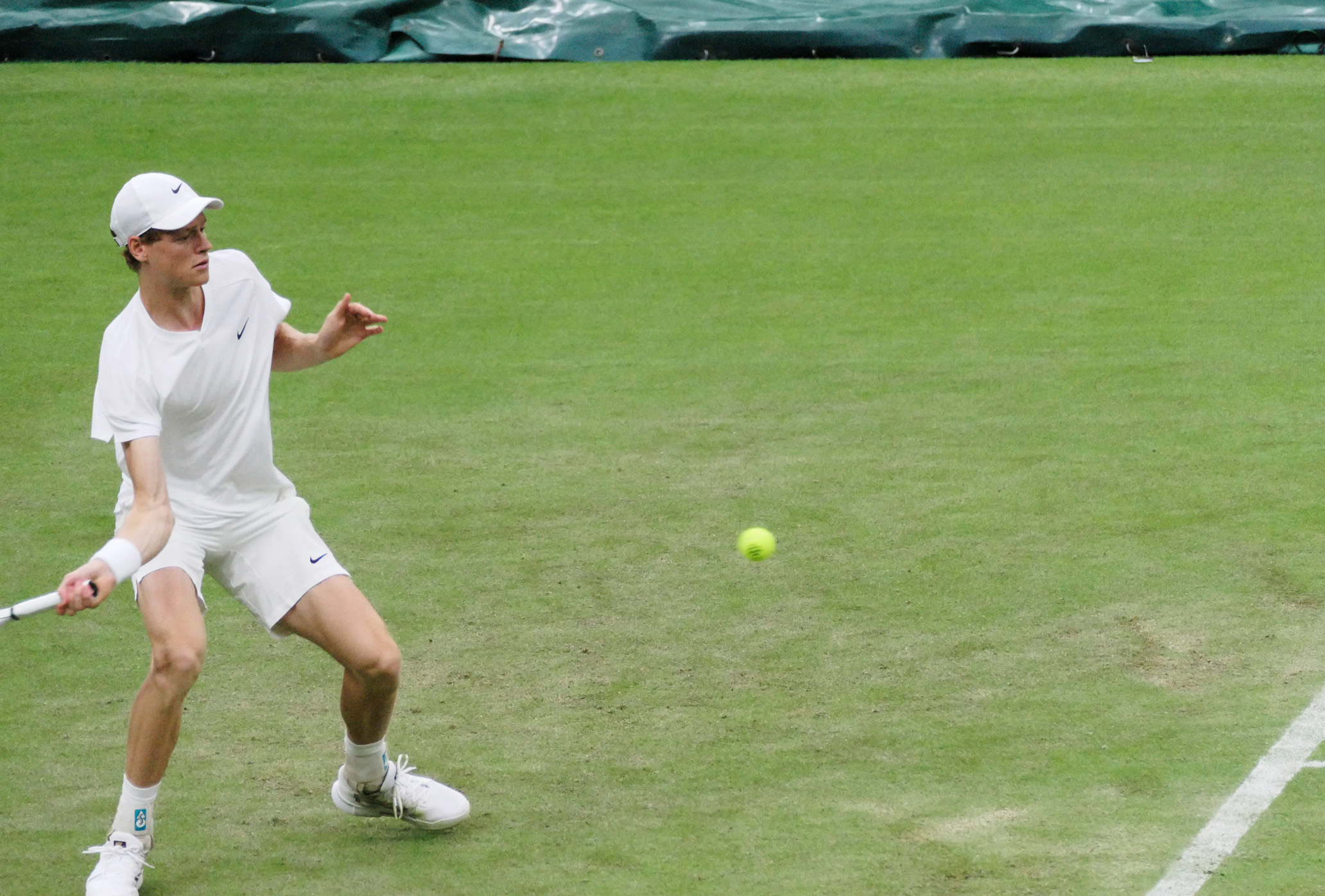
Sinner striking. // Craig E. Shapiro
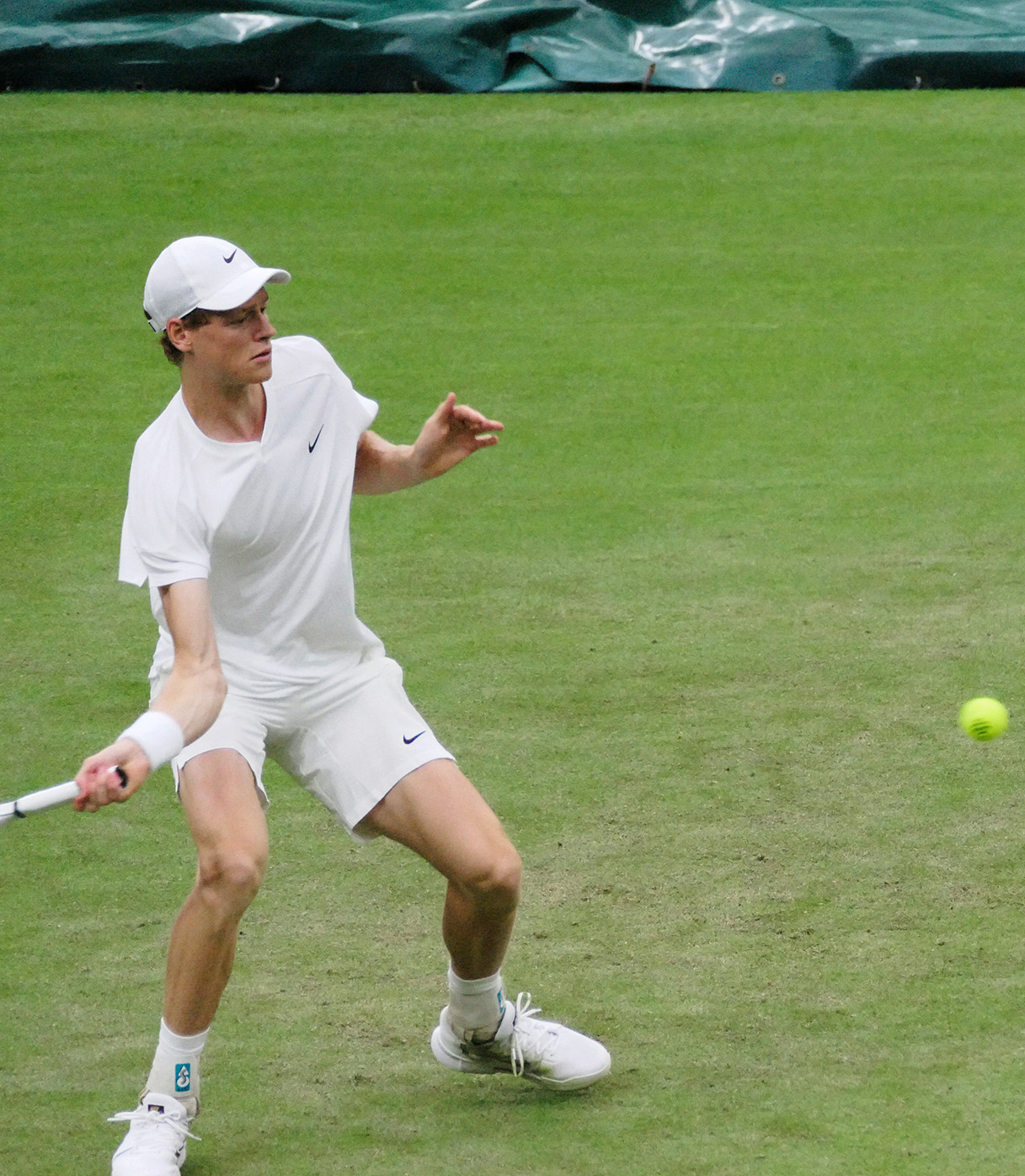
Sinner striking. // Craig E. Shapiro
Wednesday night at Wimbledon the press box on Centre Court was densely, vibrantly Italian. That was only right: Matteo Berrettini and Jannik Sinner stood on the grass before us, a contest so promising that you wish it was taking place deep into week 2. But this was just a second-round match, since Berrettini, the finalist here three years ago, is still working his way up into the top 50 after some loss of form and a six-month injury layoff. That meant that he wasn’t present in the office to witness his countryman’s rather abrupt transformation into the top player in the world. “At the end of last year I was injured and I wasn’t on tour to see him live with my eyes. And then I had the chance to go to the Davis Cup and it was unbelievable,” Berrettini said earlier this week. “It was like we were looking at each other saying, ‘Is this guy real?’ Because he wasn’t missing. Hitting every ball full power.”
At that Davis Cup, Sinner led Italy to the title, dispatching Novak Djokovic for the second time in a two-week span, and then he more or less sustained that rampage until the present day. He’s gone 38–3 since that moment, and now the 28-year-old Berrettini is the one drawing inspiration from the man six years his junior: “Personally, it gives me so much energy to just try to be there and to play against him and to be at his level. For me, it’s really useful.” On Wednesday, he spent the better part of four hours staying right on Sinner’s level, enforcing his own brand of heavyweight tennis and losing only by the tiniest of tiebreak margins, 7–6(3), 7–6(4), 2–6, 7–6(4), a Berrettini-on-grass scoreline if I’ve ever seen one. The tail end of every set always turned up to brilliance; the crowd was often lured onto its feet by the sheer quality; the Italian press corps was chirping, pontificating, and lightly admonishing one another not to openly cheer for the elder underdog Matteo Berrettini. In the end the top seed kept hacking his way through what projects to be a vicious Wimbledon draw.
Over my first watch of Berrettini on grass in person, his history of success on this surface became more legible to me. Even the parts I already understood on paper. It’s one thing to read 129 mph on your TV screen, and it’s another to see it just slide irretrievably off the turf, past a brilliant returner who has even guessed correctly. I was most struck by his court sense and comfort using the attributes of a grass court to his advantage. Sinner’s game plan was obvious from the get-to, and it’s not an uncommon one against this particular opponent: Take the pain to Berrettini’s backhand side, since his stiff two-handed backhand is a ghost of his potent forehand. But the big man compensates that with a backhand slice I knew to be effective but didn’t fully appreciate until I saw, up close, how accurately he places it, how its slow movement through the air buys him some time to recover in rallies, and how it barely bounces off the grass. It’s one of the finest slices on tour, and Sinner tested it with his endless backhand crosses—a match-long cross-examination that rarely elicited a flinch. In the rally of the match, he sent one slice around the net post that had me hooting. Berrettini even liked to cheat his court position over to the ad side, shrinking the possible space where Sinner could find his backhand and daring Sinner to take his backhand down the line, which he shied away from for much of the match, perhaps because of how difficult it was to lift that low slice up and over the net and into the court. Berrettini throws big punches, but it’s that defense and craft that keep him alive in these contests against better players.
Even as Berrettini approached his old grass-court glory, Sinner steadily revealed the extra substance in his game, seen most clearly in the tiebreaks, where he was better equipped to win any given point on either side of the ball. Sinner is so balanced, so consistent a threat in every moment, on both wings. While Berrettini came away with four breaks of serve compared with Sinner’s two, that’s slightly misleading, because it was the world No. 1 who placed more pressure on return throughout the contest, winning 59 points on return to Berrettini’s 38. I loved watching him bob and weave around the Berrettini service bombs. One second he’d be throwing his gangly limbs out of the way of a body serve, the next he’d be blanketing a second serve with perfectly grooved timing. He tinkered a little with his setup, and I asked him afterward how he thinks about return positioning when playing a server as good as his friend Matteo. He said that the way the ball slips off grass makes it hard to get too experimental with positioning, but he tried to mix it up on second serves. “It’s also a little bit a gut feeling, no? Which can help you, and you just have to go for it.” In a match against Berrettini, you might just have to have the correct gut intuition five or six times to turn the whole contest in your favor. When Berrettini appeared in press, he was equal parts disappointment and relief. “I think he missed three balls in the whole match. It didn’t give me that oxygen that sometimes you need,” he said. “But I think he surprised me, and I surprised myself also, how I was handling the level.” After a long time away from the sport’s elite, it must feel good to know you can still hang.
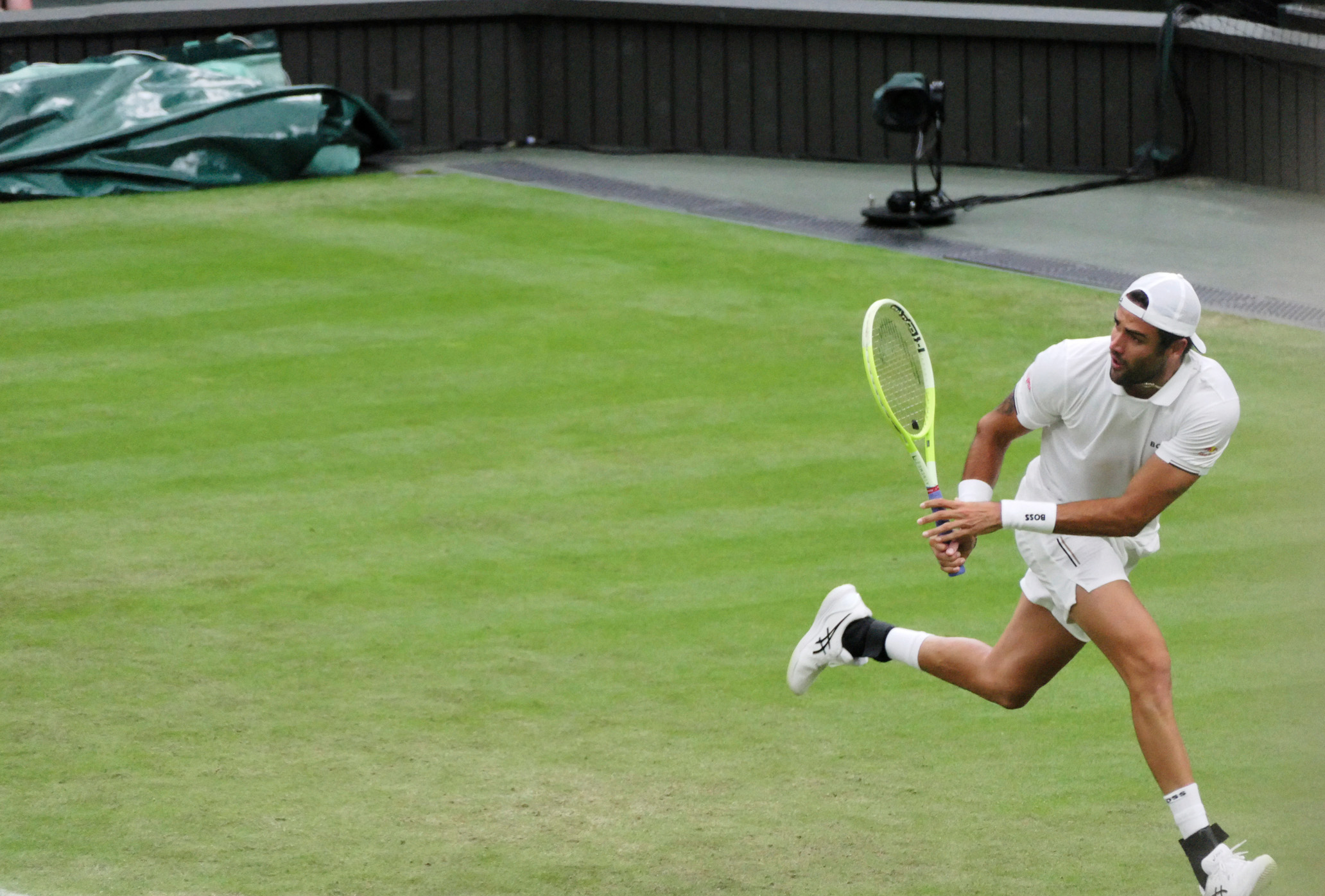
Berrettini battling. // Craig E. Shapiro
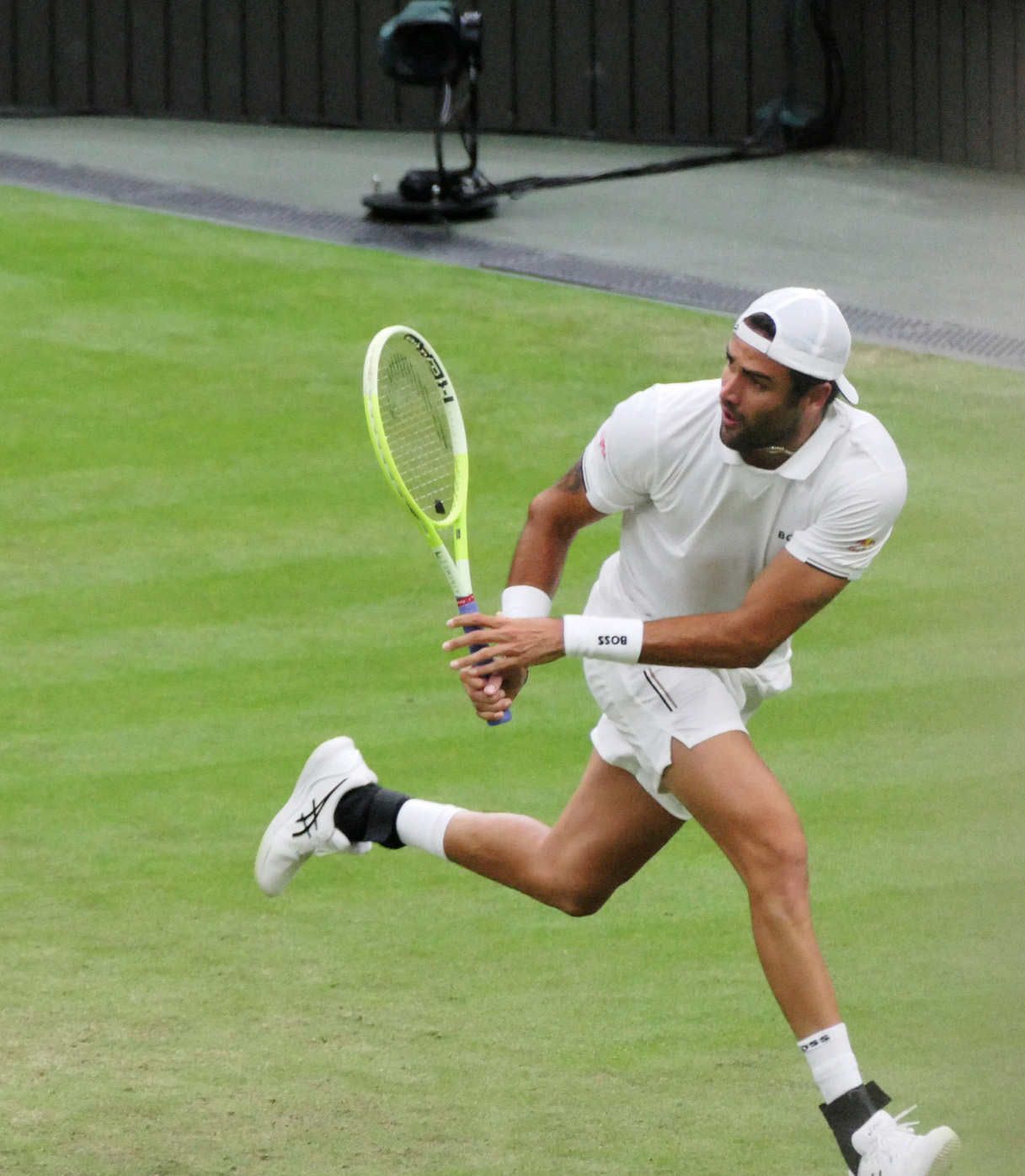
Berrettini battling. // Craig E. Shapiro

SIGN UP — YOU'RE ONLY AS GOOD AS YOUR SECOND SERVE.
The 2024 Wimbledon Shoe Report
The 2024 Wimbledon
Shoe Report
The 2024 Wimbledon
Shoe Report
The Championships bring subtle sneaker tweaks.
The Championships bring subtle sneaker tweaks.
By Tim Newcomb
July 3, 2024
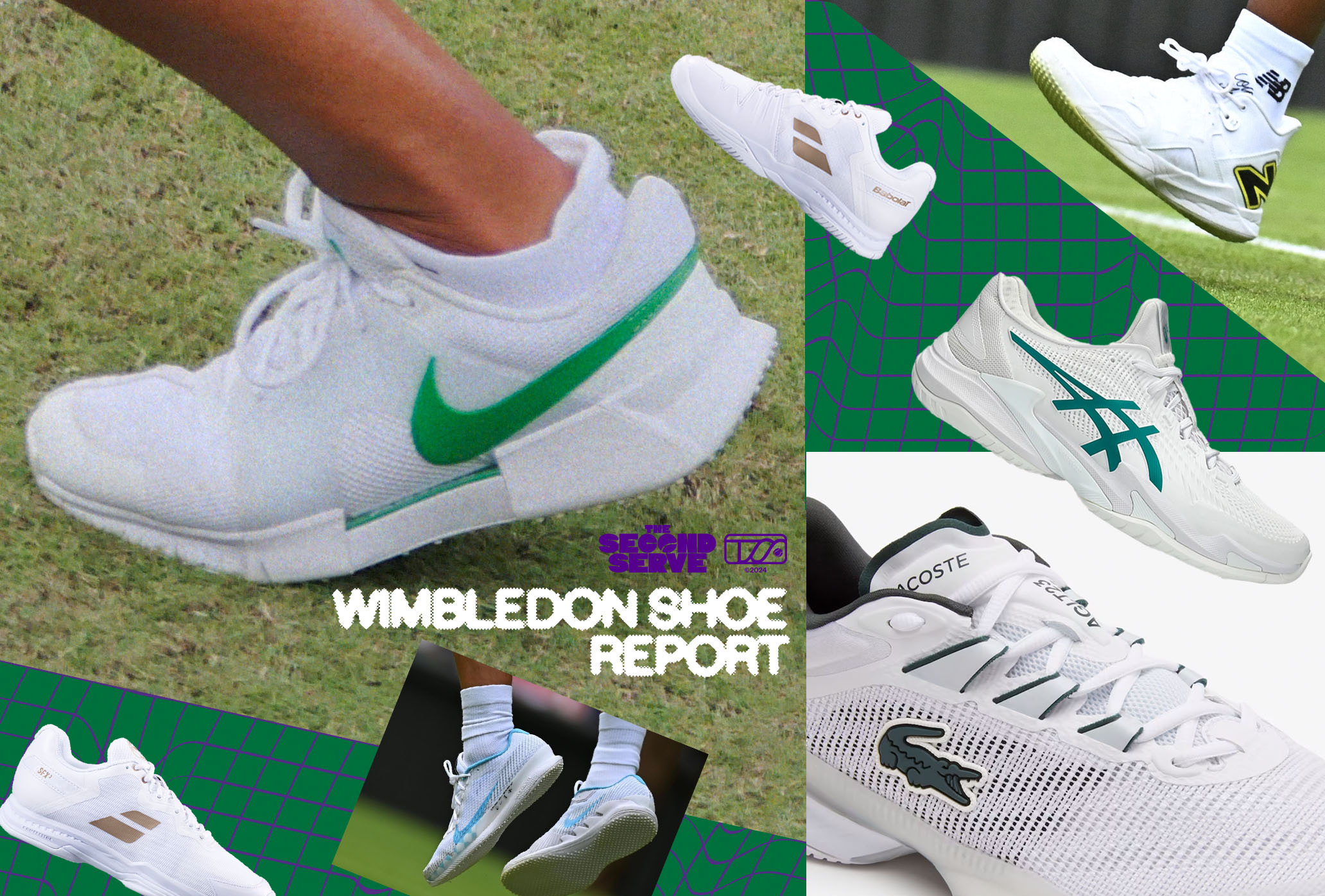
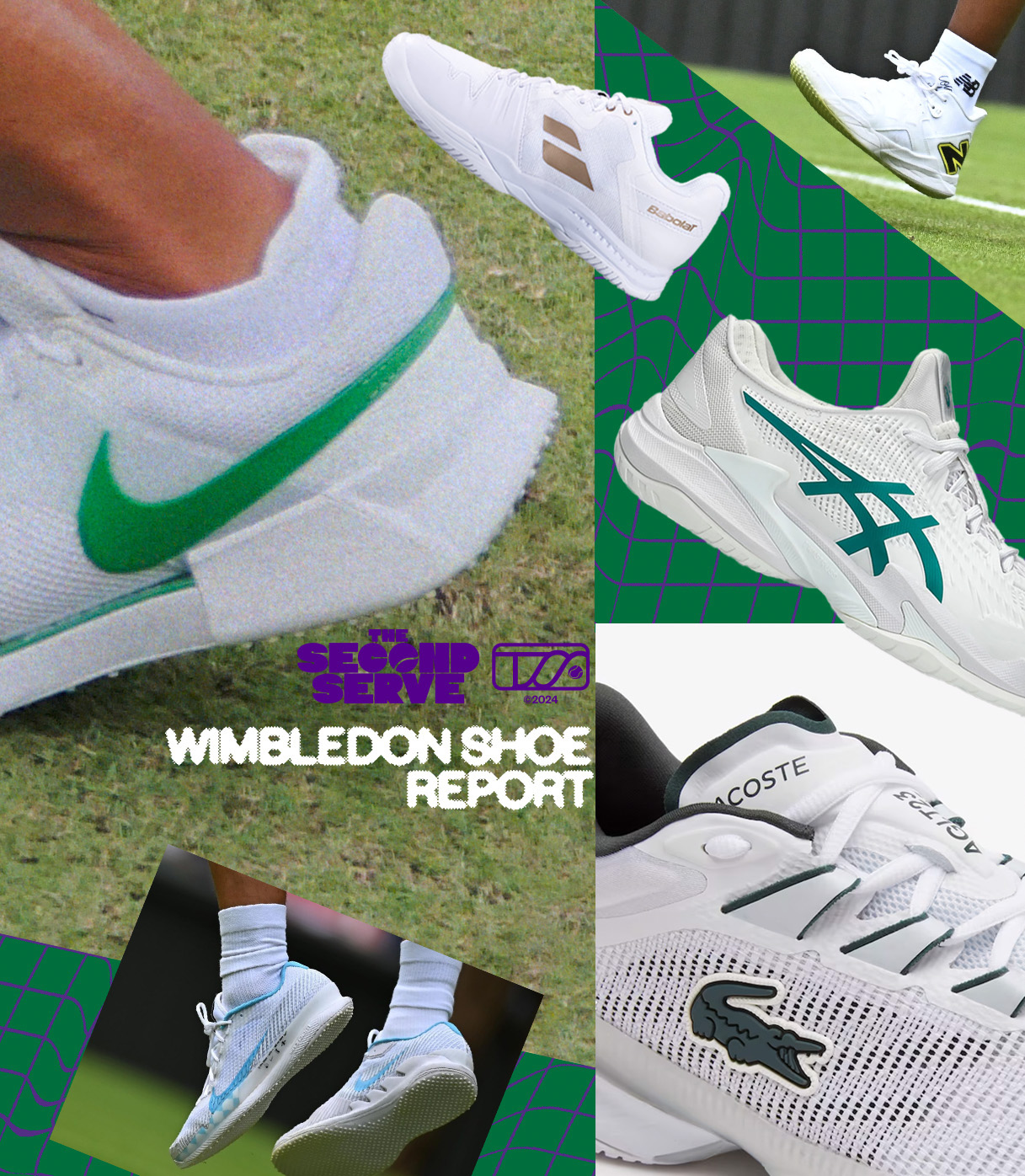
Let’s get the obvious out of the way first: Wimbledon footwear is all about white. And not a lot more. Coming on the heels of the fashion-forward Roland-Garros, brands dipping their toes in the Parisian style came away with a bit of clay on the outsole. When it comes time for Wimbledon in London, just a few weeks later, there’s not a lot of colorful leeway, so expect the grass stains to combine with one main color—or lack of color.
While the Australian Open is known for brands introducing new footwear styles for the calendar year, Roland-Garros an effort to show off Parisian-inspired design, and the late-summer US Open all about making a late-season splash, brands have the double whammy of Wimbledon that keeps them subdued, both the restrictive color rules and the fact that grass-soled shoes aren’t typically a retail offering (it is actually rare for a brand to sell a grass-soled shoe in the United States).
As we look to 2024 Wimbledon in footwear, design is largely defined by accents. This year we see plenty of black (Asics, New Balance, Yonex, On, Adidas, and Lotto) and green (Wilson, Novak Djokovic, Naomi Osaka, and Lacoste), even if we have a few notable snippets to discuss.
CARLOS ALCARAZ
Nike Zoom Vapor 11 Carlos PE
Carlos Alcaraz is donning a player-edition version of the Nike Vapor 11, his with soft blue accents on the collar, Swoosh, and in a diamond pattern on the midfoot. We don’t know a lot about what’s under the hood of the Vapor 11 for Alcaraz, but seeing him get special treatment with the colorway—and seeing that it is now available as a retail option—leaves us hopeful that by the U.S. Open Nike will give us an entire Alcaraz color story. With the Spaniard leading the new crop of male tennis athletes for Nike—Jannik Sinner is also a Nike athlete, but he’s not as willing to try new styles when it comes to his sneakers—if the brand wants to continue to make a splash in men’s tennis, expect it to happen with Alcaraz.
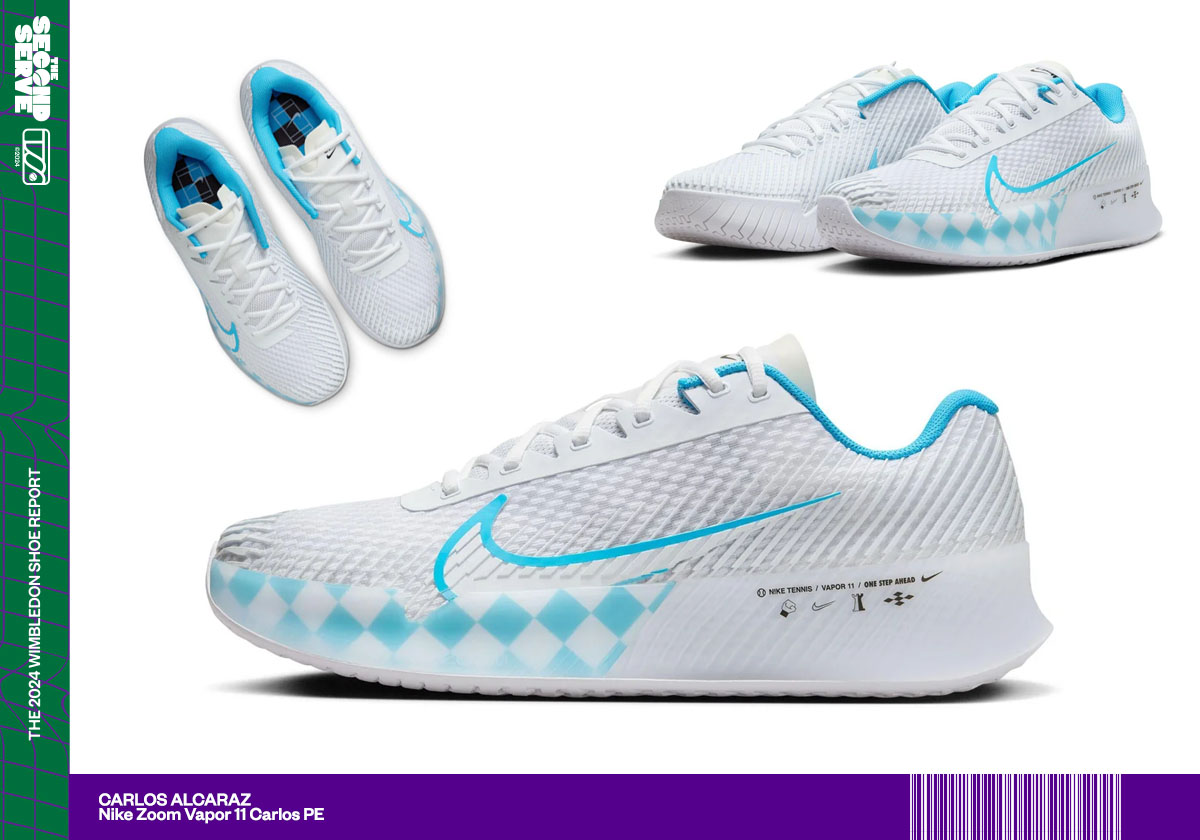
Images courtesy of Nike

Images courtesy of Nike
BALL KIDS
Babolat SFX 3 Wimbledon
The official sponsor of Wimbledon footwear, Babolat outfits the ball kids. That includes the footwear, a choice between the SFX 3 Wimbledon or Propulse Junior Wimbledon. The SFX 3 model is a white base, obviously, but comes accented in gold and with the official Wimbledon logo on the tongue. The Propulse Junior offers up silver accenting and moves the official tournament logo to the heel.
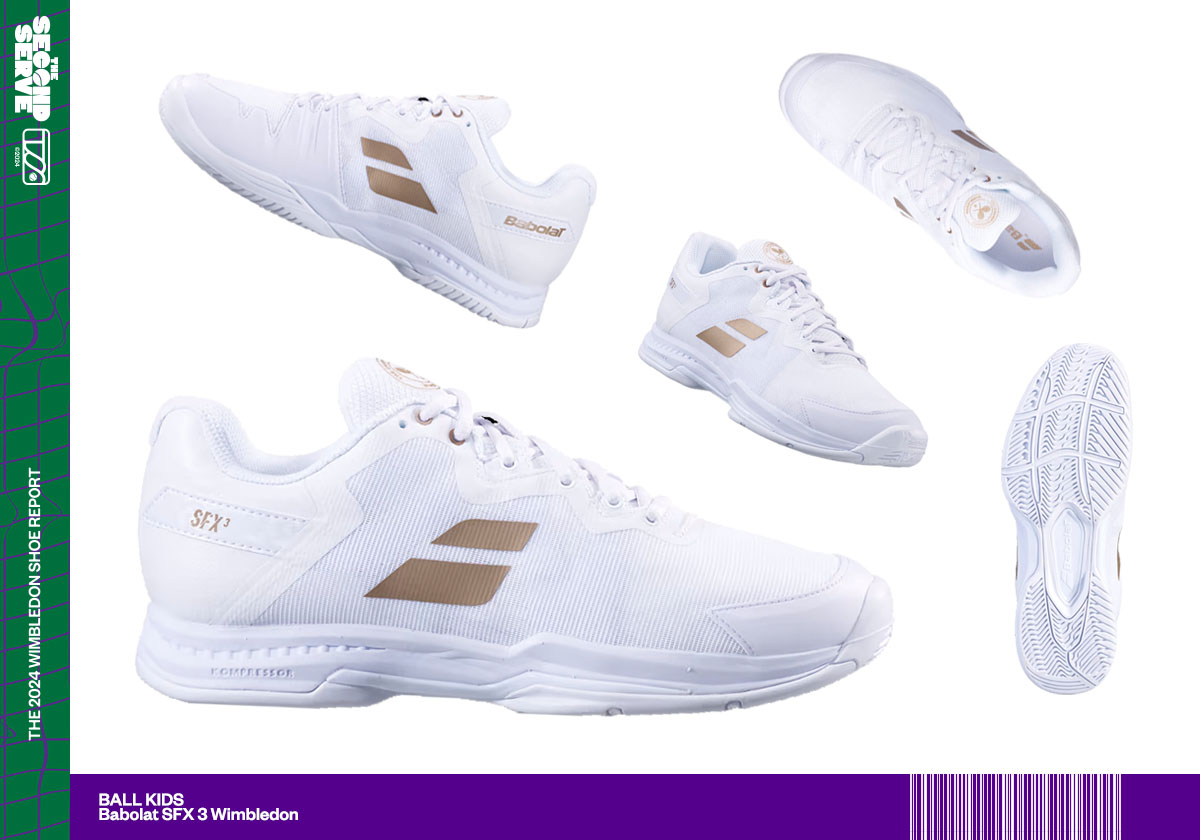
Images courtesy of Babolat

Images courtesy of Babolat
NAOMI OSAKA
Nike GP Challenge 1
Naomi Osaka gets special treatment at Nike. That includes everything from her kit to her footwear. Wearing the GP Challenge 1, Osaka has come to Wimbledon with green accents on her shoe and her personalized “NO” logo on the tongue of the model.
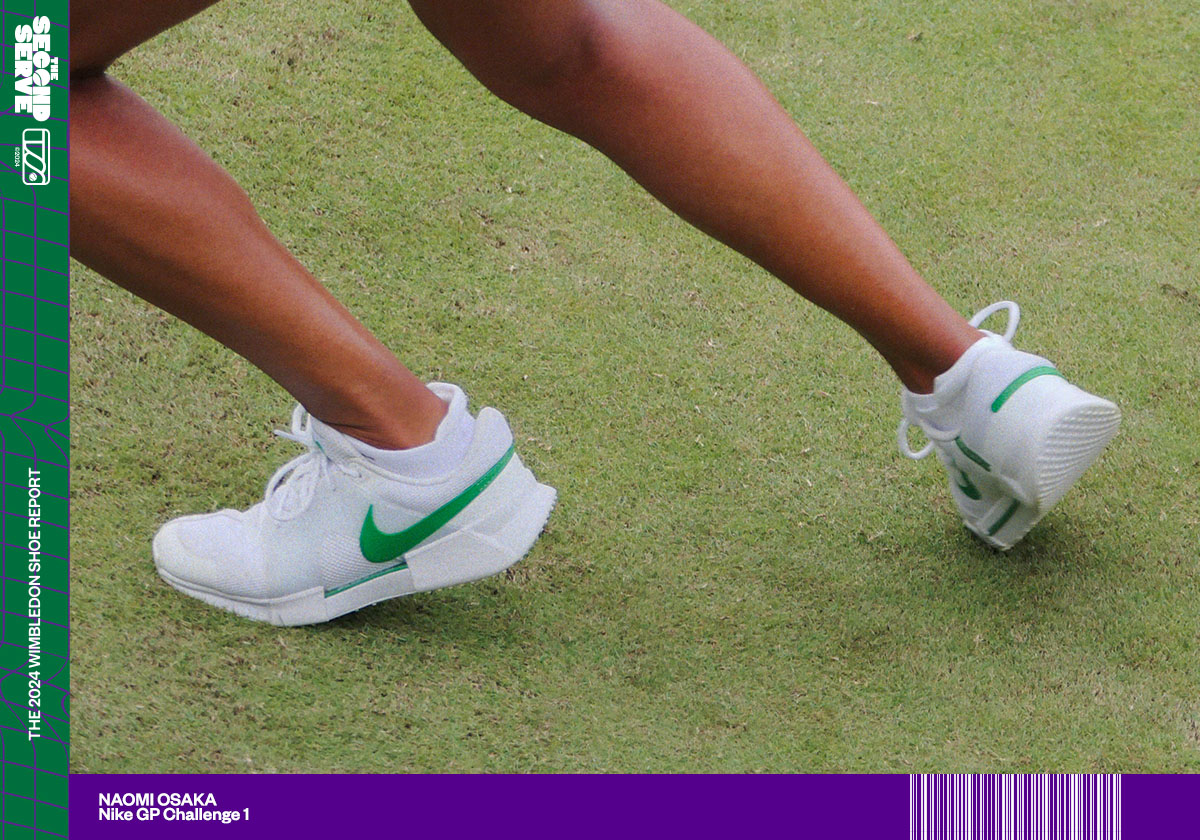
Image courtesy of Craig E. Shapiro

Image courtesy of Craig E. Shapiro
COCO GAUFF
New Balance Coco CG1
Typically, New Balance makes a big deal—rightfully so, in the opinion of tennis sneaker lovers—of each new colorway of the only signature shoe in the game for an active player, but this year’s Wimbledon has little fanfare (just wait until we tell you about the upcoming Olympics model, though!). Gauff is wearing an all-white Coco CG1 with a slight outline of neon around the black “N” logo on the heel, splashing a bit of color that the rest of the New Balance athletes don’t enjoy.

Alamy
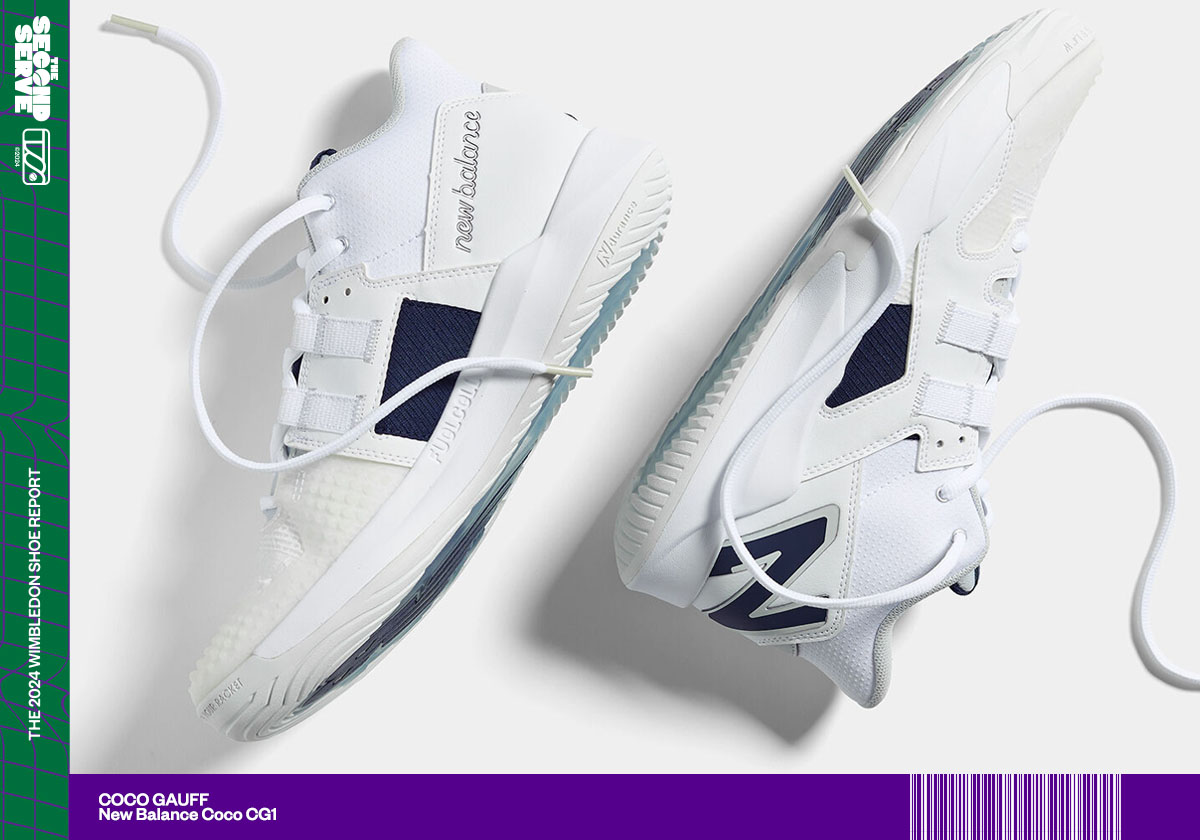
Alamy
DANIIL MEDVEDEV
Lacoste AG-LT Ultra
Lacoste has brought out a players-only grass-court version of the AG-LT23, and Daniil Medvedev is again sporting a version with his personal logo.
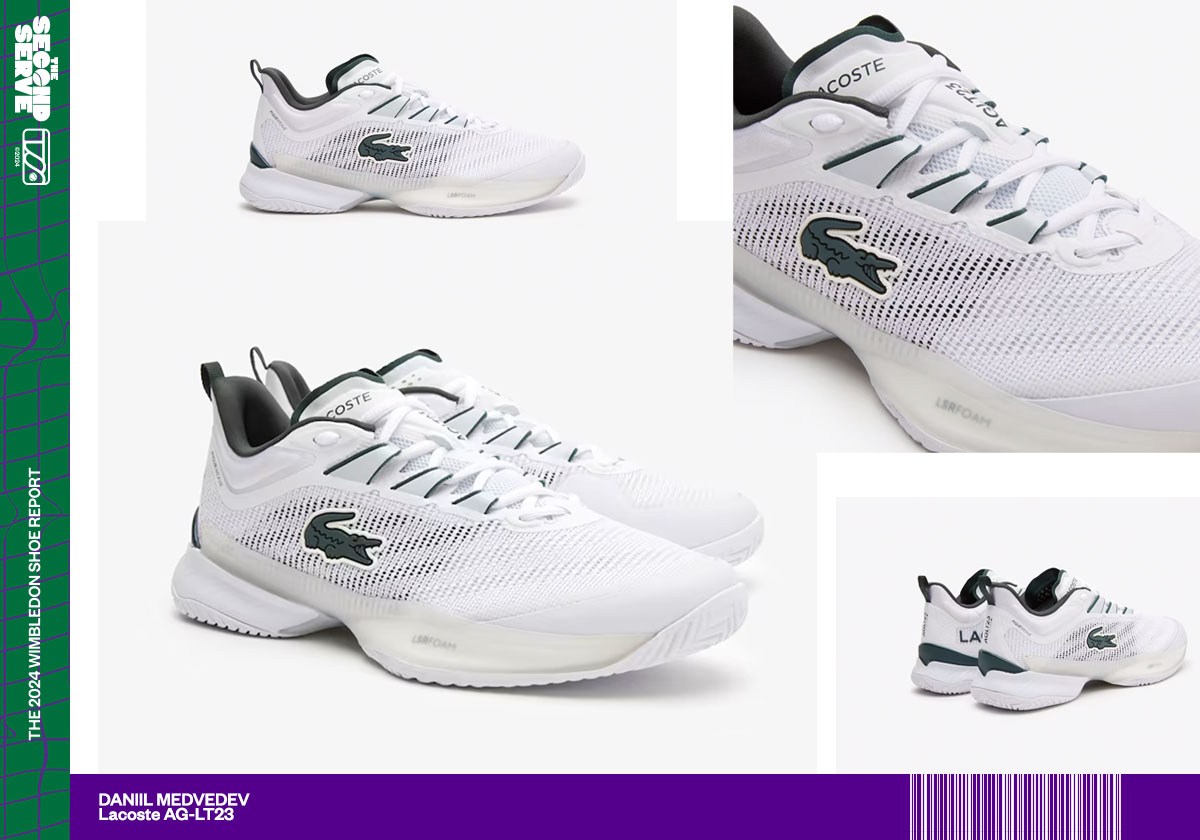
Images courtesy of Lacoste

Images courtesy of Lacoste
NOVAK DJOKOVIC
Asics Court FF3 “Novak”
Novak Djokovic has a green-accented version of his Asics Court FF 3, even as all the other Asics athletes have black. The Djokovic shoe also features a “24” on the lateral side, signifying how many major championships he has won.
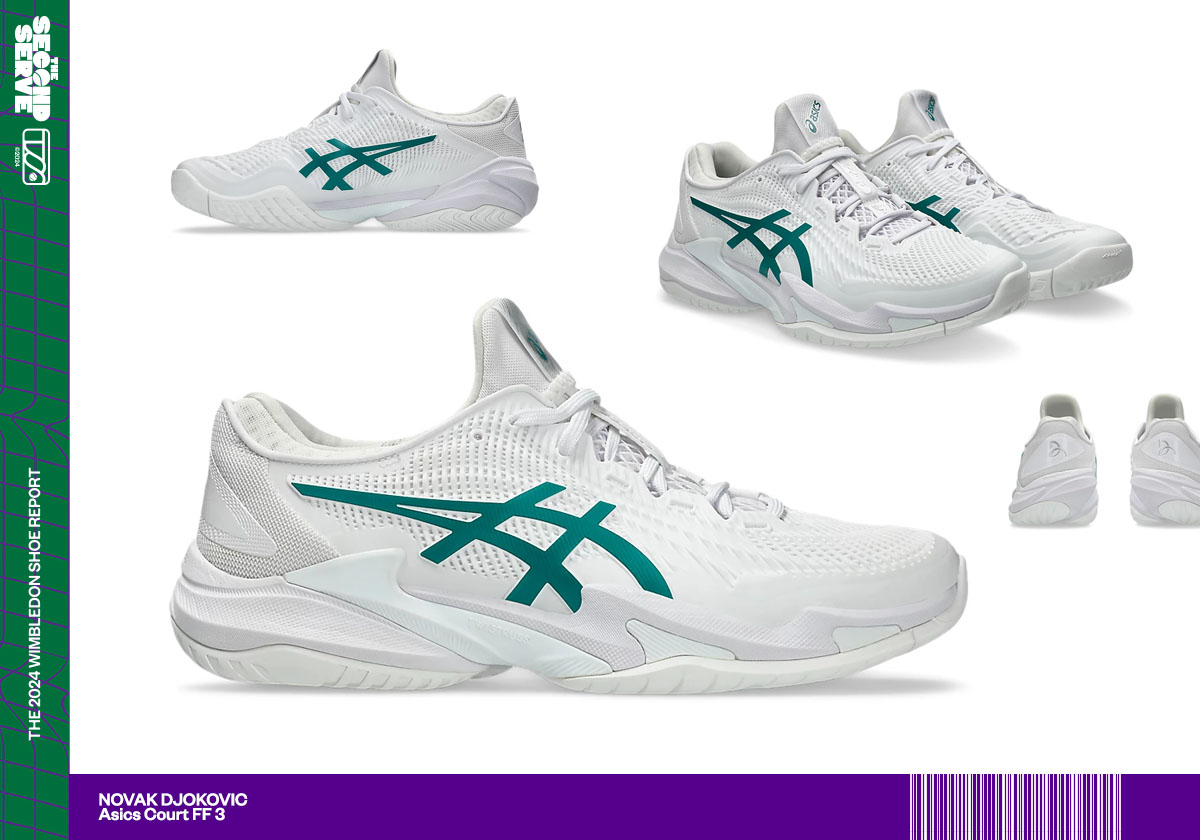
Images courtesy of Asics

Images courtesy of Asics
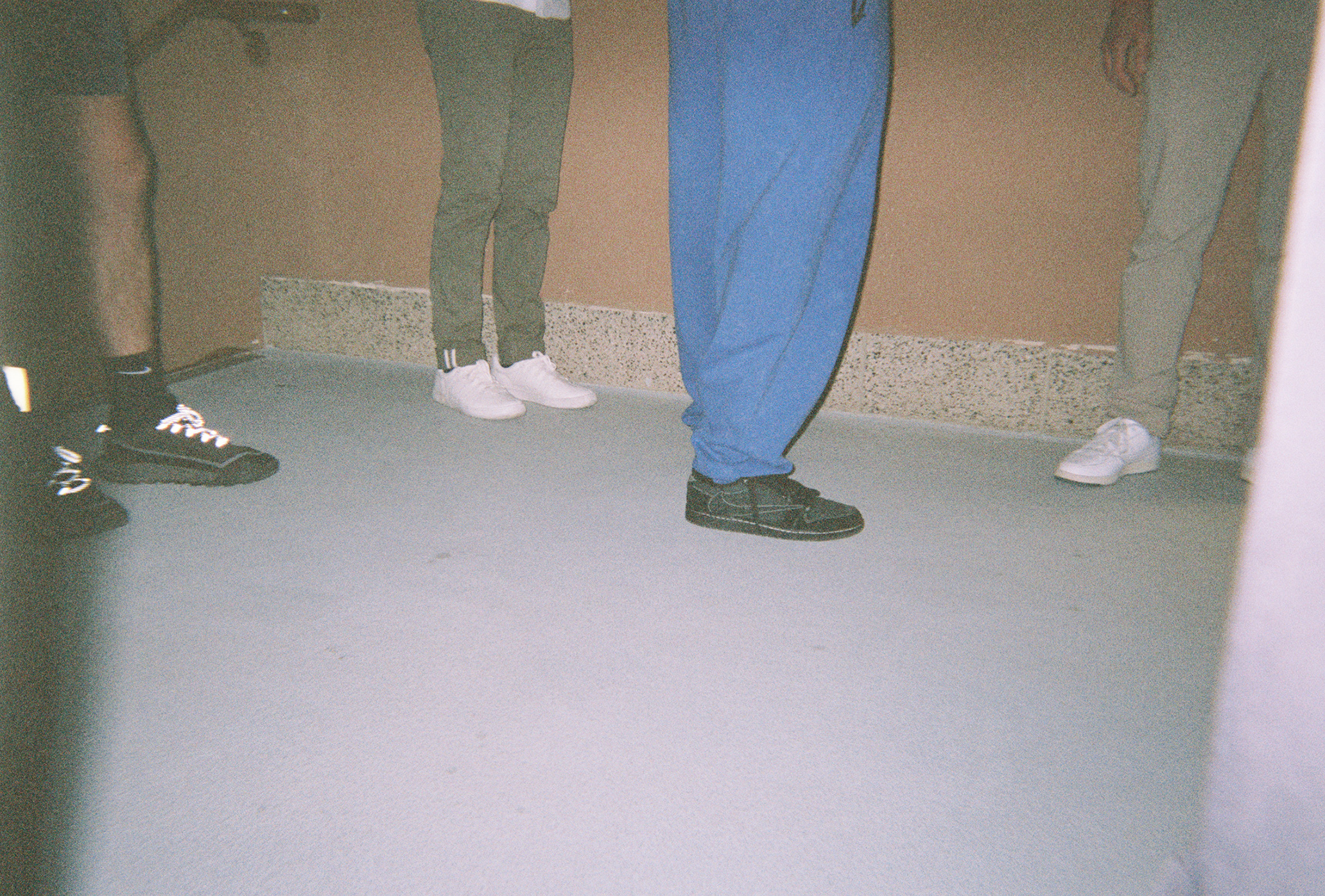

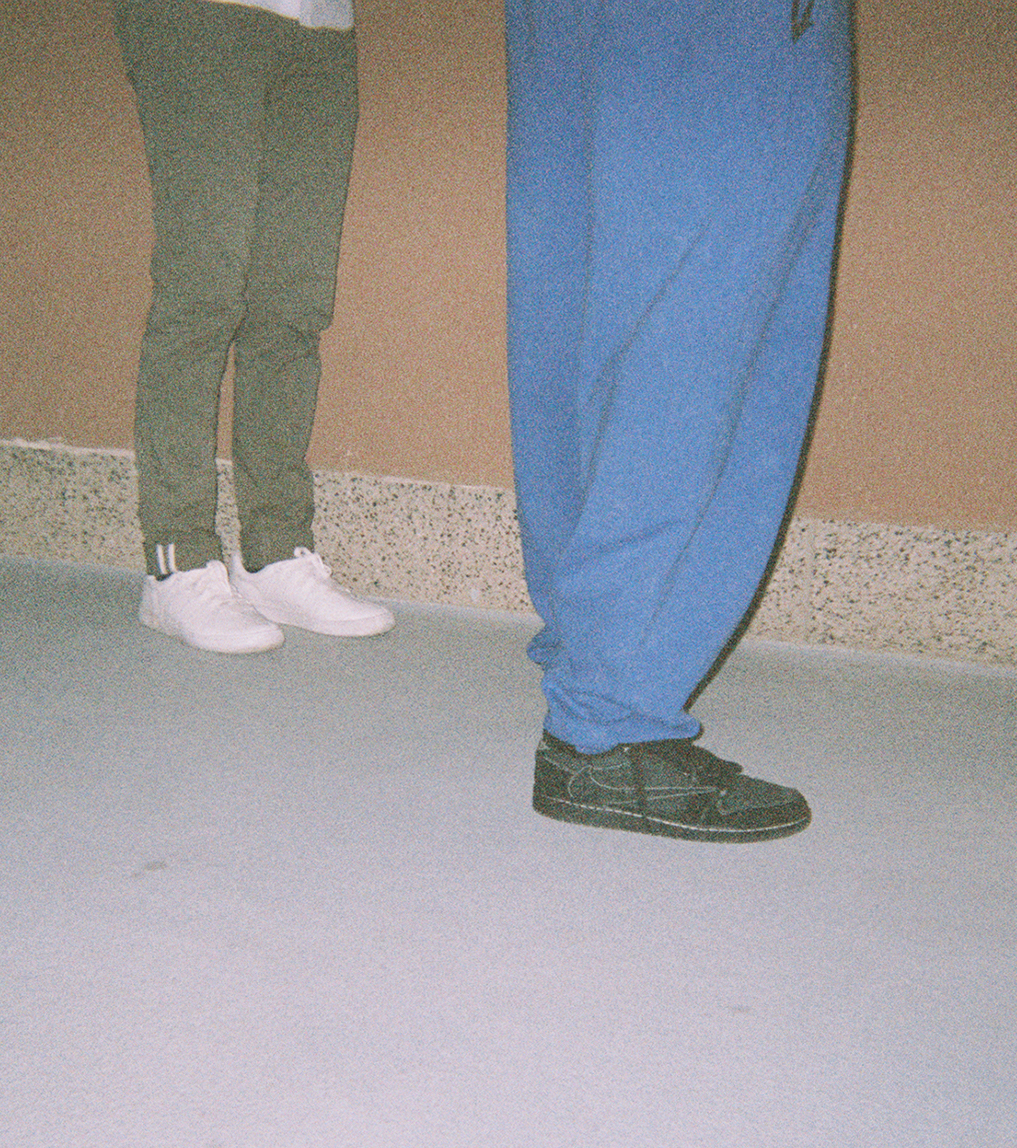


— Wilson wowed with a Wimbledon dress for Marta Kostyuk inspired by the wedding dress Wilson designed for her November 2023 wedding, but her shoes offer the latest in performance models from the brand. The brand-new Wilson Rush Pro 4.5 features a green accent.
— When Andy Murray takes the court in the doubles, this will likely be the last time we see Under Armour tennis shoes on a grass court. For a brand that has never released a tennis shoe at retail, Murray has given them quite a run, still dipping into a stash of shoes he has worn since leaving the brand in 2018.
— Leylah Fernandez is one of the most interesting sneaker stories in the sport without trying to be. The Lululemon athlete does not have a footwear deal and surprised at the 2023 US Open by wearing the Breanna Stewart signature basketball shoe from Puma (she bought them on her own without Puma knowing) during the doubles portion of the tournament. She stuck with the shoe in Australia, but the need for a clay-court sole had her wearing On at Roland-Garros. Earlier in the grass season she sported Asics, but is back in On for Wimbledon.

Follow Tim Newcomb’s tennis gear coverage on Instagram at Felt Alley Tennis.
SIGN UP — YOU'RE ONLY AS GOOD AS YOUR SECOND SERVE.
Back on Track
Back on Track
Back on Track
Three years after her victory at the US Open, Emma Raducanu is still in pursuit of a normal season as she heads into Wimbledon.
Three years after her victory at the US Open, Emma Raducanu is still in pursuit of a normal season as she heads into Wimbledon.
By Giri Nathan
June 28, 2024
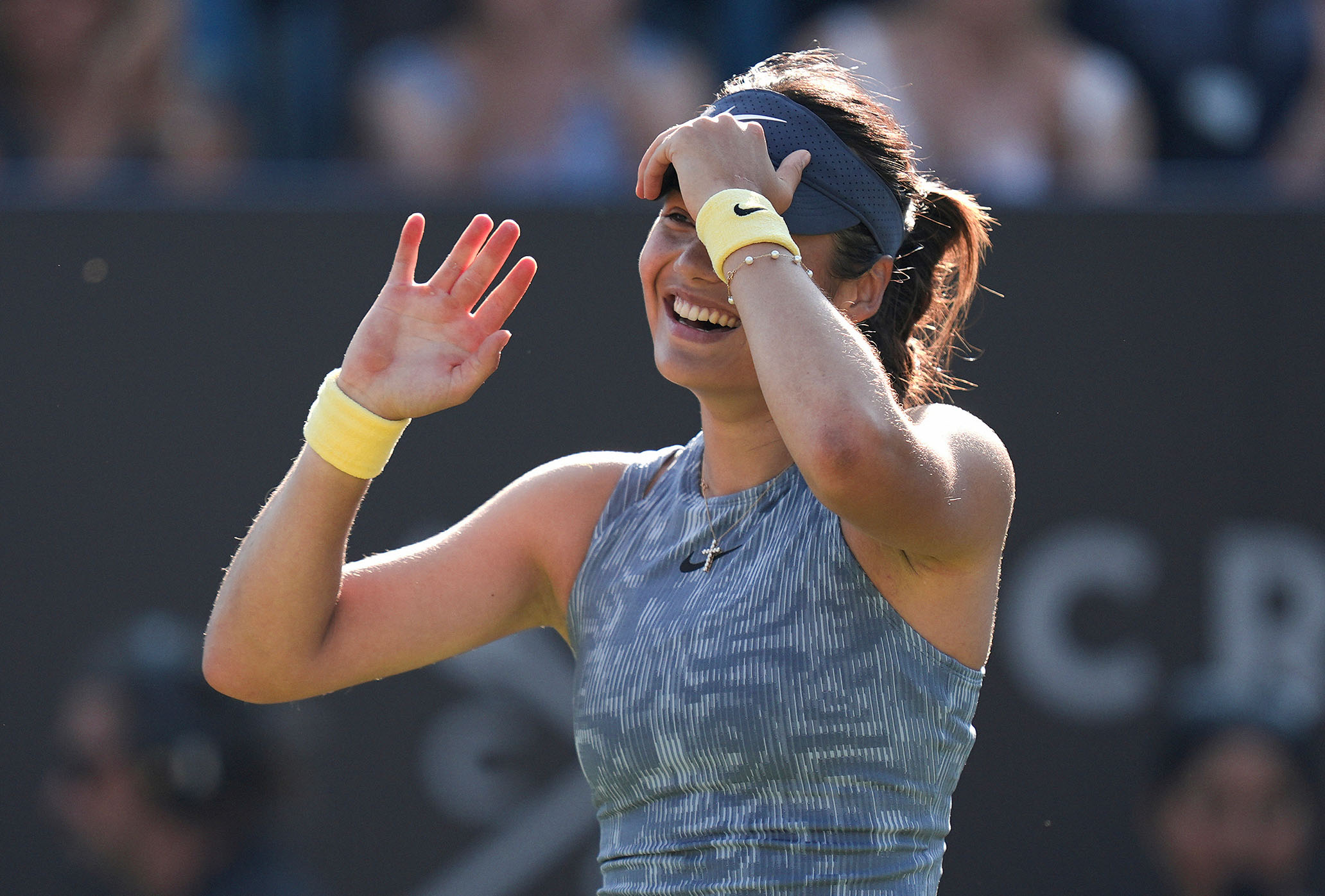
Emma Raducanu is all smiles after defeating Jess Pegula at Eastbourne. // AP
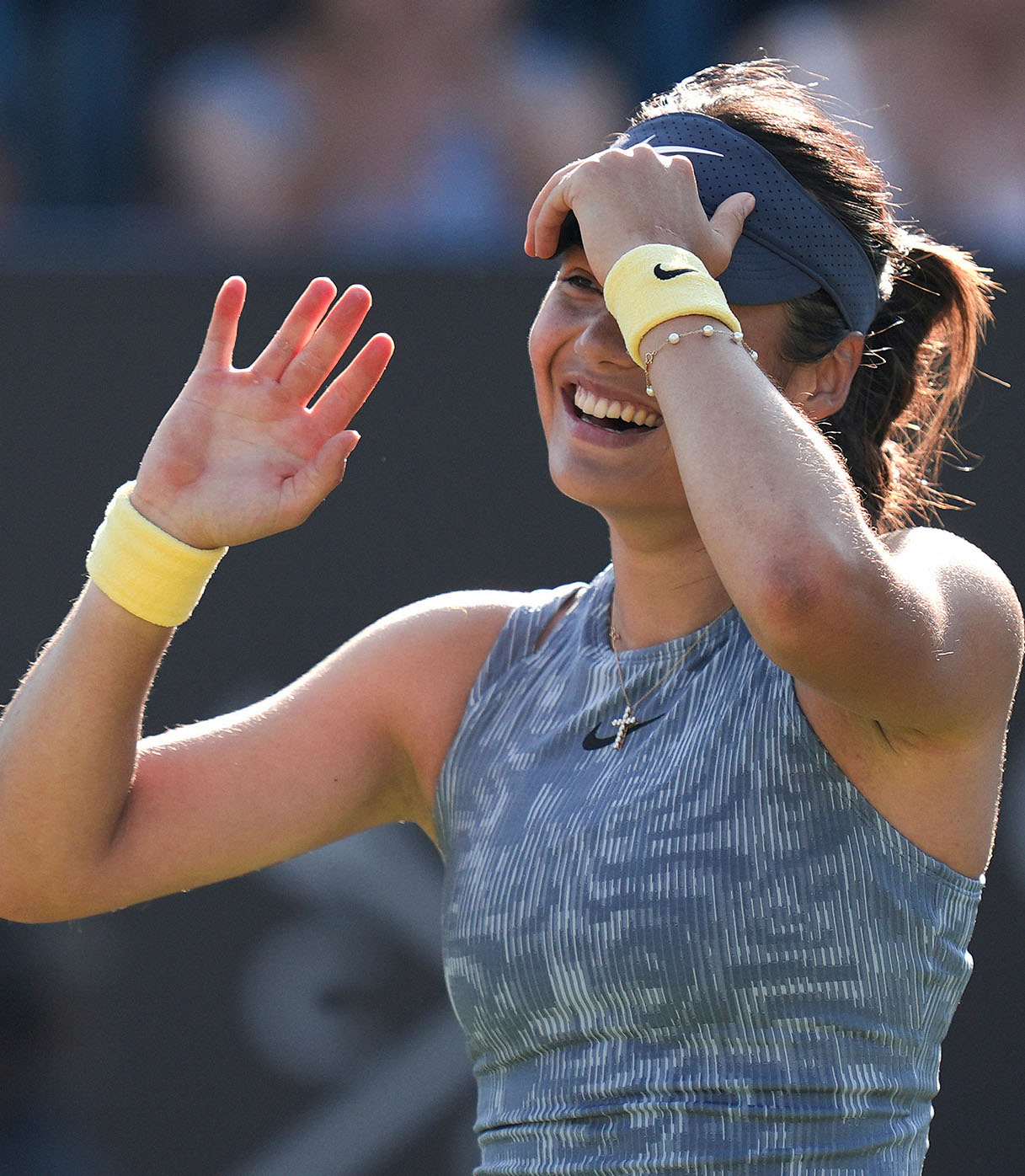
Emma Raducanu is all smiles after defeating Jess Pegula at Eastbourne. // AP
Some people’s lives, or at least tennis careers, seem to arrive all out of order. In a vacuum, how would you chronologically sequence the following events in someone’s career?
A. Win the US Open
B. Enter the top 20 for the first time
C. Hire a sixth coach after firing five in a two-year span
D. In a meaningful sign of progress, beat the world No. 274 and world No. 127 in Nottingham to rise into the top 200
E. Win first-ever set against a top 10 player
I’d probably go with D, E, B, A, C for narrative coherence. But for Emma Raducanu, the answer is exactly the jumbled order you see above. She did claim the 2021 US Open as a teenage qualifier, and she did only enter the top 20 a few weeks after that title. And then over the next two years, she did cycle through a whole roster of coaches while coping with constant injuries and surgeries that pulled her out of the top 300, to such a degree that it was a genuinely positive sign for her to log consecutive wins against modest competition at Nottingham last week. And then her win over Jess Pegula in Eastbourne on Wednesday was—surprisingly—the first time she had taken one set off of a top 10 player, let alone a victory. (If you’ll recall, during that 2021 US Open, it was the other surprise teenage finalist, Leylah Fernandez, who eliminated all those seeded players in spectacular three-setters. Raducanu did defeat Maria Sakkari and Belinda Bencic, who were top 10 in the singles race at that point but were not technically top 10 players due to some COVID-era rankings weirdness.)
Three years after her major victory, Raducanu is arguably still in pursuit of a normal season as a professional, something that could fit in the yawning expanse between “winning 10 matches in a row to claim a US Open title as an 18-year-old qualifier” (2021) and “missing six months of tour due to surgeries on her ankle and both wrists” (2023). Something straight down the middle, like “top 30 player who competes on tour most weeks,” a standard she is surely talented enough to achieve. She might be discovering that normalcy as we speak. She entered the year ranked just outside the top 300 and since then has received a few wild cards, remained decently healthy, picked up some inspired wins, and played one extremely competitive tiebreak set against Iga Swiatek on clay. (That’s a lot more traction than most of Iga’s victims over the past few months can boast.) Raducanu’s clay season ended early, though, as she was too fatigued to play in Rome and didn’t receive a wild card to the main draw at Roland-Garros; she decided to skip out on qualifying, pull out of the Olympics, and prep for the other surfaces instead.
So far that’s looking like a sound decision. She’s won five matches on grass, plus a walkover. Two weeks ago she made the semifinals at the 250 in Nottingham, narrowly losing to the eventual champion Katie Boulter. This week in Eastbourne, Raducanu blew away Sloane Stephens and managed to beat Pegula in a knotty three-set comeback that saw her erase one match point in the second set and attempt to serve for the match three separate times. Later Raducanu described the victory over a newly in-form Pegula, who just won a grass title in Berlin, as one of the most meaningful of her career. These past few weeks have served as a reminder of how fundamentally solid Raducanu’s baseline game is, that exceptional movement and balance and timing on the ball. She wasn’t able to put much of that skill to use in Eastbourne on Thursday, when she was pitted against Daria Kasatkina in ultra-windy conditions. Raducanu often seemed to be lashing away while off-balance; Kasatkina, meanwhile, has hands so good that she’d be the favorite on any blustery day demanding constant last-second adjustments, and she won 6–2, 6–2.
“Yesterday [against Pegula] it was a much better level of tennis because conditions suited it better. It was just more clean ball-striking,” Raducanu said afterward. “Today it was the complete opposite. It was more about the scrappy little shots that are dying. The slower you actually hit the ball today, the more difficult it was to deal with, because it would just hold in the air and move and cut with all the spin.” On the whole, though, she said she was happy with her performance and her physical recovery from three straight days of tennis. She’s in the best stretch of her career since her US Open victory and will hop up some 33 ranking slots to No. 133 next week. Now she heads to Wimbledon, the tournament where she first broke out three years ago with a shock fourth-round appearance, and where perhaps she can continue to assemble a more straightforward and sustainable future.

The Hopper
—The Wimbledon seeds are out. and somehow Novak is one of them.
—Nobody is playing the Olympics, it seems.
—Tara Moore bounces back.
—Defector’s Owen Lewis despairs about the state of tennis highlights.
—Garbiñe Muguruza has been named the Riyadh tournament director.
—From the Guardian: Life at the Bottom
—A look at grass court tournaments of yore.

SIGN UP — YOU'RE ONLY AS GOOD AS YOUR SECOND SERVE.
A Fresh Cut
A Fresh Cut
A Fresh Cut
ESPN wants tennis to stop obsessing over its ex.
ESPN wants tennis to stop obsessing over its ex.
By AJ Eccles
June 27, 2024
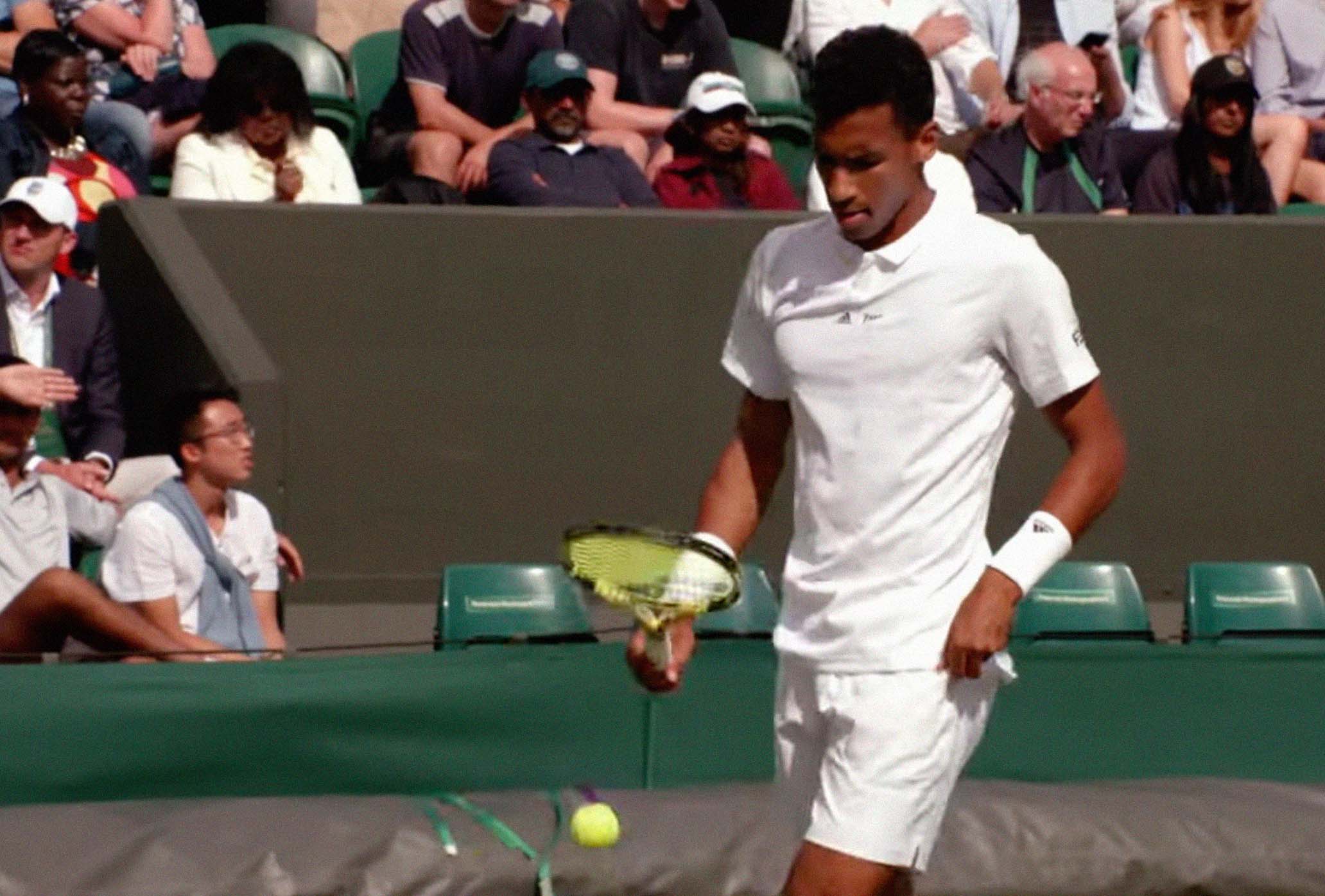
The guard has changed. // ESPN
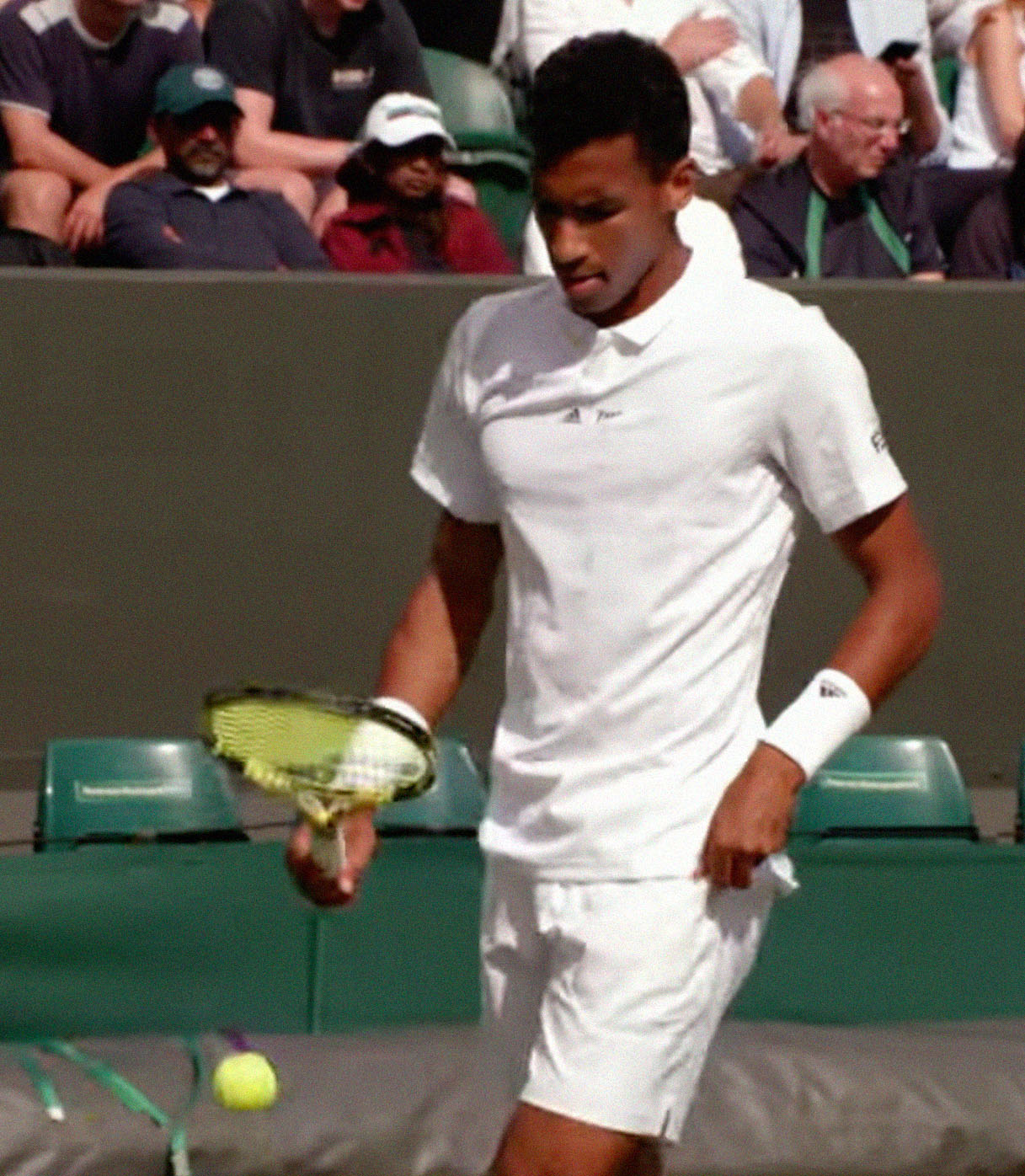
The guard has changed. // AP Images
“If you knew how much I looked at her pictures/You’d think we were best friends,” Olivia Rodrigo croons on “Obsessed,” a single from her recent album Guts that ESPN has chosen as the soundtrack to their 2024 Wimbledon ad. In its opening lines, “Obsessed” appears to be taking on toxic fandom—itself a topic of obsession in millennial and Gen Z pop culture—but the truth of the song quickly becomes clear.
“She’s been asleep on your side of the bed/And I love it,” is the whispered confession as Rodrigo unfurls the source of her toxicity. She’s obsessed with her lover’s ex, the scent of a ghost still present in a burgeoning situationship, driving the singer to distraction. It’s the perfect choice for ESPN’s Players Are Ready campaign, at once an admission of guilt and a call to action, challenging tennis and tennis fans to move on from echoes of the past.
Wimbledon is about remembering. Of every stop on the endless around-the-world-tour of the tennis calendar, it is London’s grassy crown jewel that most wants us to look to the past, to revel in tradition, to sip on nostalgia like an icy cup of Pimm’s. This is reflected in Wimbledon’s marketing materials—at their best the emotionally searing crescendo of In Pursuit of Greatness, and at their current worst the baffling written-by-committee slogan Always Like Never Before.
Either way, Wimbledon brands itself as past-become-present. An effective message for an aging audience, perhaps not for growing a base of Challengers-inspired newcomers.
Players Are Ready defies this tradition, exorcising tennis’ ghosts and forefronting only the faces of the present and the future: Gauff, Alcaraz, Sabalenka, Tiafoe, Osaka, Sinner. Names that are quickly growing in the public consciousness, a new, diverse, exciting group of stars who are moving the sport forward on and off the court in their own right.
To continue doing so, these young stars need the support of broadcasters, media, sponsors, and tournaments alike. Stardom is a bargain struck by multiple parties: You win, we report, they advertise.
It’s striking, after a decade of domination, to see a broadcaster advertising a major without Roger Federer, Serena Williams, Rafa Nadal, or Novak Djokovic. All four are present in Wimbledon’s own ad for 2024, even though the former two are retired, the latter two focused on Olympic preparation in varying states of disrepair. (Djokovic is, it seems for now, playing the tournament.)
Wimbledon isn’t wrong to honor tradition—sport is so much about warrior pretenders yearning to join the pantheon—but it’s time to admit that SW19’s service to the past has wandered into unhealthy obsession. Even with the most wonderful of exes, there comes a time to move on.
When a young champion lifts the trophy this year, one can only hope they don’t look out to the Wimbledon crowd wondering, in Rodrigo’s words, “Do you think about her?/No, I’m fine, it doesn’t matter, tell me…”
AJ Eccles is a writer from Brooklyn, NY.
SIGN UP — YOU'RE ONLY AS GOOD AS YOUR SECOND SERVE.
London’s Courts of Carnage
London's Courts of Carnage
London's Courts of Carnage
Part of the challenge of playing Wimbledon is getting there in one piece.
Part of the challenge of playing Wimbledon is getting there in one piece.
By Ben Rothenberg
June 21, 2024
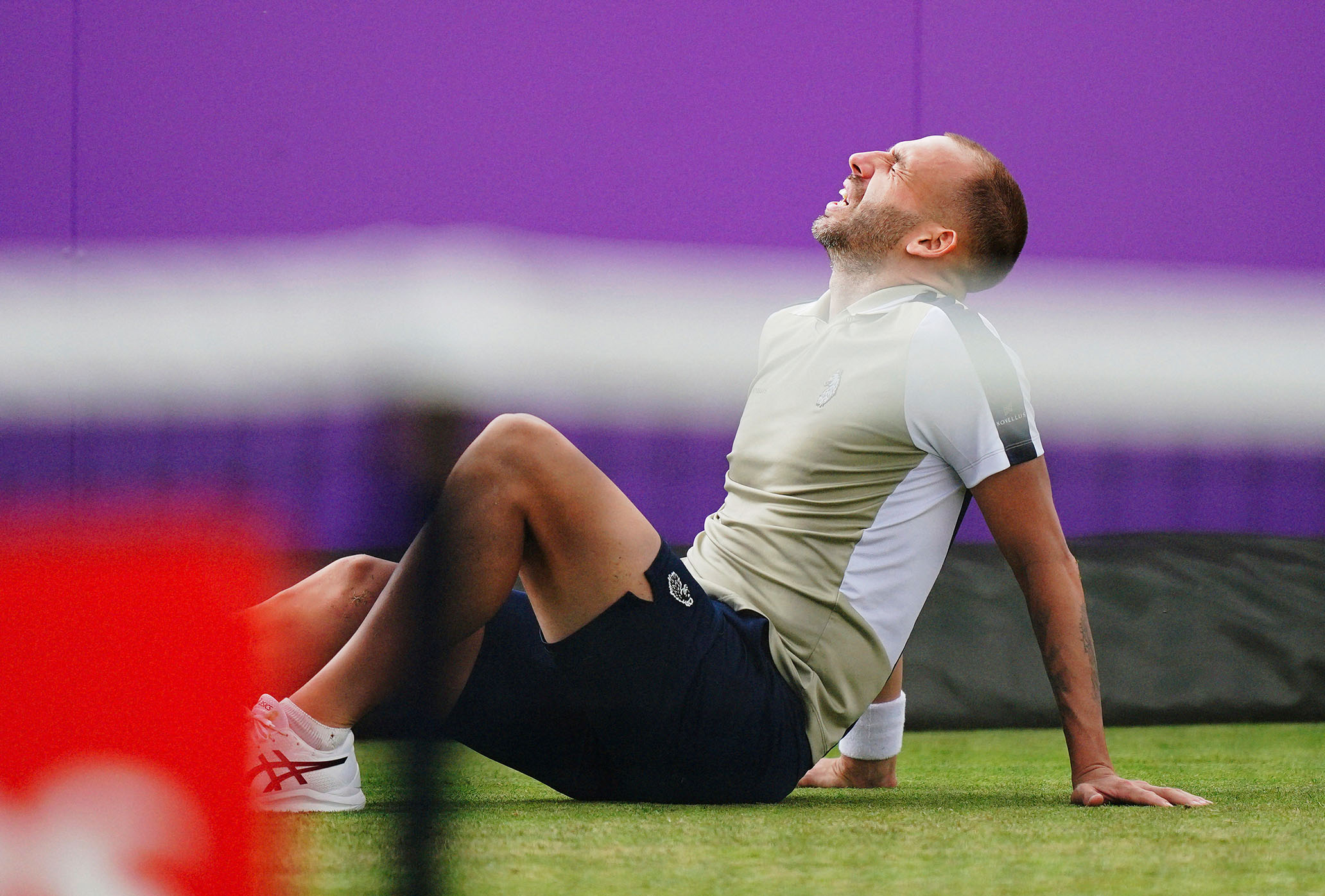
Dan Evans' ass is grass. // AP Images
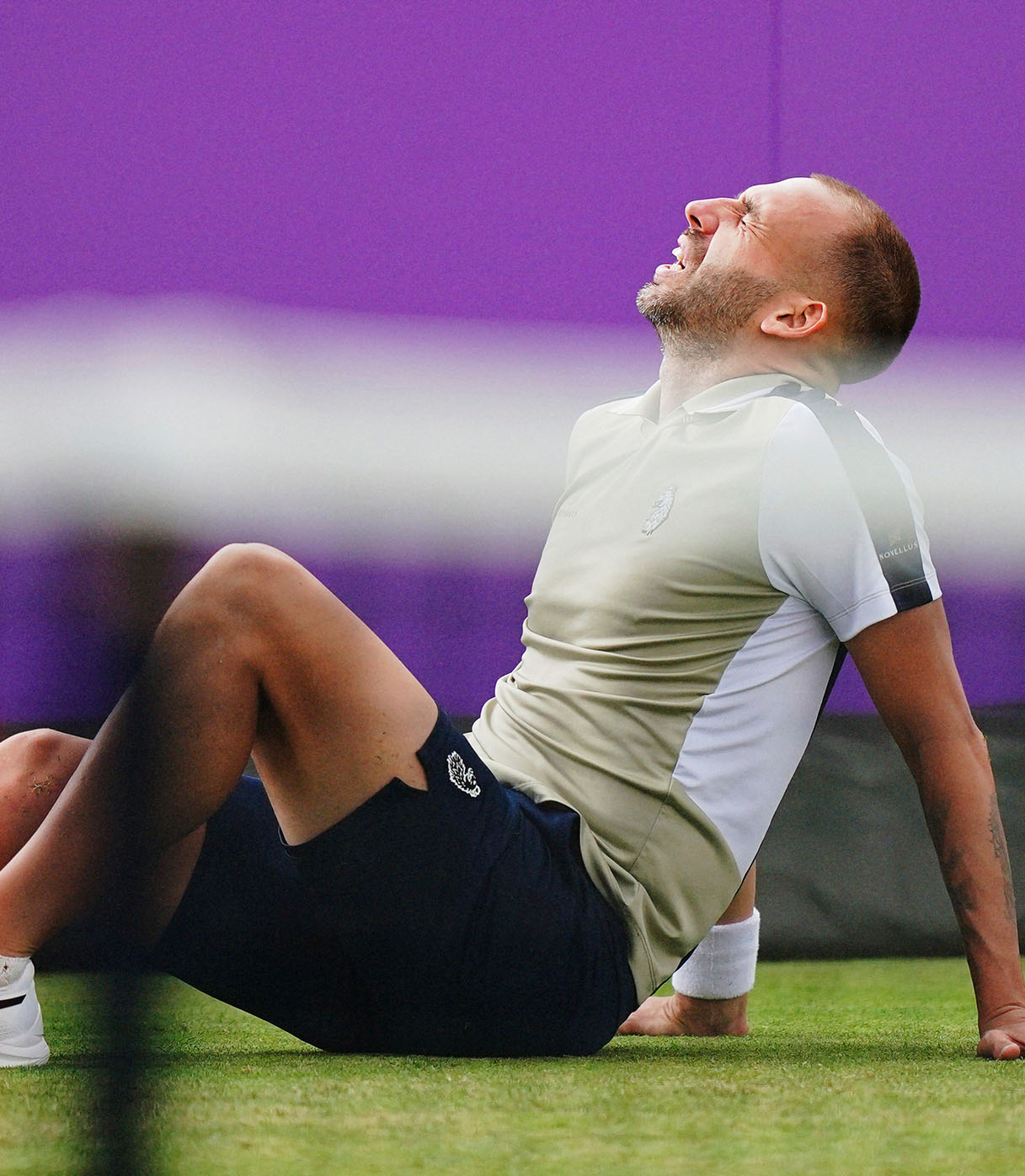
Dan Evans' ass is grass. // AP Images
The grass court season usually begins as it ends, with players on the ground. At the end of the grass campaign in mid-July, those players are collapsing to the lawn in delighted, disbelieving delirium, having just won Wimbledon. And these victories are nearly always the most satisfying to behold, as grass court tennis reliably proves some of the most watchable of the season for me. After the slog of clay, I love how grass rewards proactive, purposeful play. A player is rewarded both for hitting the ball hard and for hitting the ball at an unexpected angle or spin. Passive pushers get punished, which pleases me.
But at the beginning of each grass court tournament, the players are down on the ground unintentionally, having slipped and fallen on grass that is still sumptuously moist and slick. Sometimes the players get right back up quickly, other times it’s slowly. Sometimes slips that look catastrophic prove harmless; sometimes a short skid is career-altering. Grass court tennis is the wrong kind of suspenseful in this way, especially at the front end of each tournament.
As I watched one of the most creative craftswomen of the game, Bianca Andreescu, playing the grass court WTA tournament in ‘s-Hertogenbosch last weekend, my primary emotion was trepidation. Andreescu’s career has been derailed time and again by injury, and she’d slipped and fallen several times on the grass. When it looked like she was limping at one point, I wished she would stop before it got worse; I winced as it looked like she might risk another sidelining injury.
Even after I had started writing this piece, my fears were further justified: Defending Wimbledon champion Marketa Vondrousova slipped and fell awkwardly in Berlin and was forced to retire from the match. Her health outlook for a title defense (which would admittedly be a long shot) is unclear.
Grass can be so treacherous. pic.twitter.com/mPF9xAJF5x
— Tennis Blockade (@tennisblockade) June 20, 2024
But though many grass courts have their slippery streaks—even Wimbledon’s Centre Court took out Adrian Mannarino and Serena Williams in consecutive first-round matches in 2021—nowhere in tennis seems as time-testedly treacherous as the most upper-crust venue on the ATP Tour: Central London’s Queen’s Club. As attendees at arguably the snootiest stop on tour sip champagne, the lush grass has consistently caused top male players to slip and fall awkwardly; this week, both Frances Tiafoe and Dan Evans were felled as their feet went out from under them (Tiafoe said he has a grade 1 MCL sprain but hopes to recover for Wimbledon).
Queen’s Club’s outdated policy of not allowing players to practice on match courts before the tournament begins, making them maximally slick and unscuffed when competition begins, seems to be the major factor in the danger; Wimbledon used to have a similar policy, but reversed it after the spate of slips in 2021.
Another former U.S. men’s No. 1 who was watching Tiafoe’s injury empathized. “Queens is undoubtedly one of the best events of year, but the courts are diabolically slippery, especially on Monday and Tuesday,” John Isner tweeted. “Sucks for Frances, hope he can recover for SW19.” Isner, who famously spent longer on a grass court than anyone ever had before, said he didn’t have time for Queen’s Club late in his career. “Swore it off the last 7 years of my career,” the 6-foot-10 Isner wrote. “Big tree fall hard.”
Thanasi Kokkinakis, who like Andreescu has had his career derailed by injuries, chimed into Isner’s thread and confirmed that he had pulled out after winning in the first round of qualifying out of fear of injury if he stepped onto the courts again. “Yea man, so slippery out there,” Kokkinakis said.
The Lawn Tennis Association, the national governing body for tennis in Britain, has responded to the trend of players dropping in an amusing but profoundly unhelpful way, remixing the falls with footage of dancers shablamming to the ground.
Most players are reluctant to put Queen’s Club on full blast despite this apparent disregard for player safety, even as they agree on the conditions. “I mean, to be honest, it’s my complaint every year, I think: The courts are a little too slippery here,” Taylor Fritz told reporters after his first-round win at Queen’s Club this week. “Pretty much every year, someone takes a fall, I always feel like. I mean, don’t get me wrong, the courts are obviously very good grass courts, but, I mean, I feel like every year once I go to Eastbourne and Wimbledon from here, I feel like I have much more traction on the court. I feel like, here, I always have to watch it a little bit. I feel like I never move my best because I’m a little scared about it.”
As Isner had added in his tweet, the ultimate proof of the carnage at Queen’s Club is one of the game’s most missed: “Just ask Delpo,” Isner said.
Indeed, Juan Martin del Potro skidded slightly as he approached the net late in a first-round win over Denis Shapovalov at Queen’s Club in 2019. He finished the match and didn’t play another for nearly three years, a feeble farewell in Buenos Aires.
Long out of the game at just 35 years old, del Potro recently announced plans to open a namesake academy in Palm Beach County, Fla. The academy will be staged at the Indian Springs Country Club in Boynton Beach, which boasts 26 courts.
There will be 20 clay courts, six hard courts, and zero grass courts.
Ben Rothenberg is the author of Naomi Osaka: Her Journey to Finding Her Power and Her Voice.

The Hopper
—Emma Raducanu will not play on Andy Murray-led Olympics squad.
—And Sir Andge’s retirement is imminent.
—Wimbledon wild cards have been announced.
—And Billy Harris has received one of them.
—Ash Barty is returning to Wimbledon.
—Independent High-End Outdoors magazines are thriving.
—Serena Williams goes Hollywood.
—Sports Illustrated gets a new lease on life.

SIGN UP — YOU'RE ONLY AS GOOD AS YOUR SECOND SERVE.
Grazing in the Grass
Grazing in the Grass
Grazing in the Grass
The season heats up as red turns to green.
The season heats up as red turns to green.
By Giri Nathan
June 14, 2024
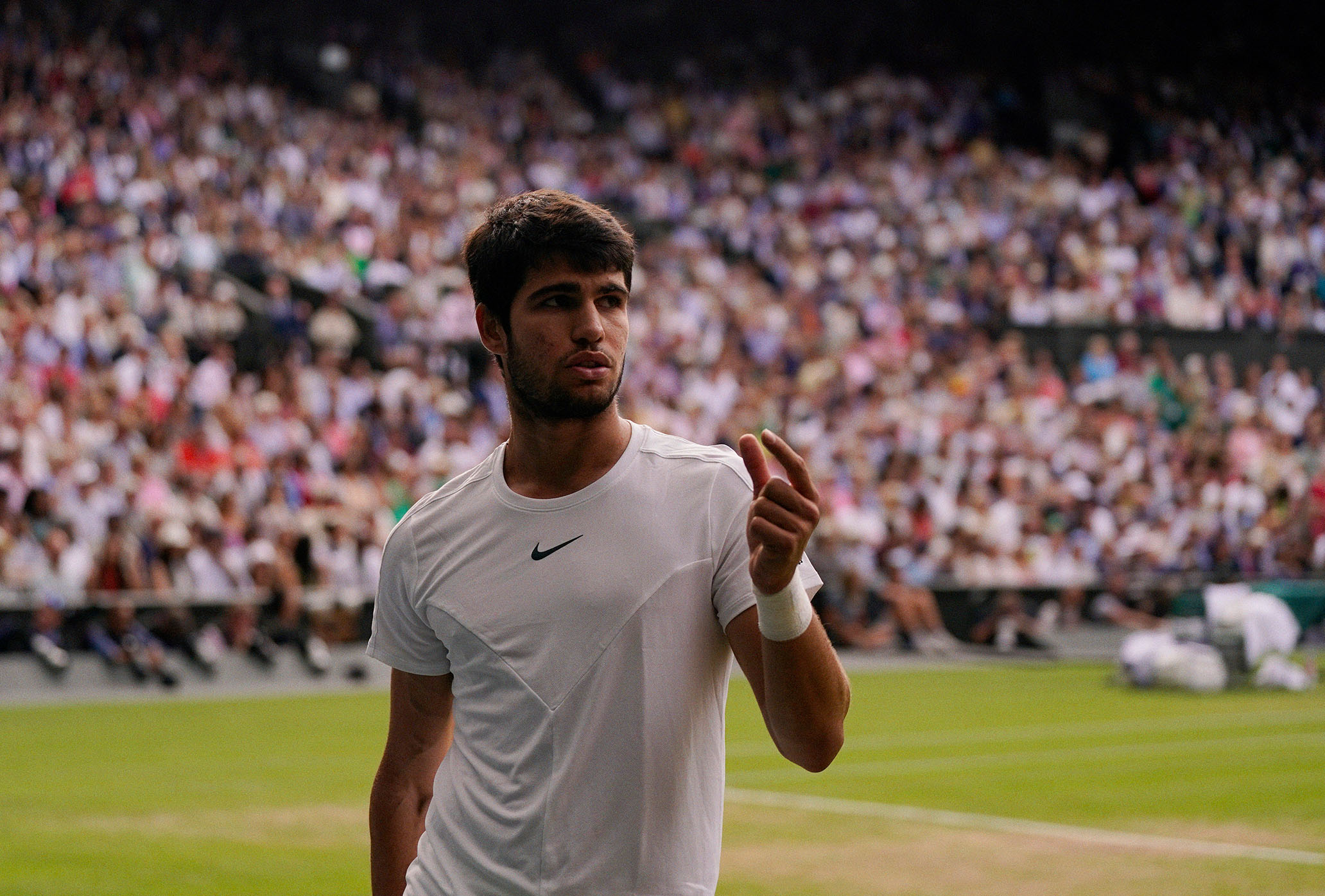
Will Carlitos have another season in the sun on the grass? // AP Images
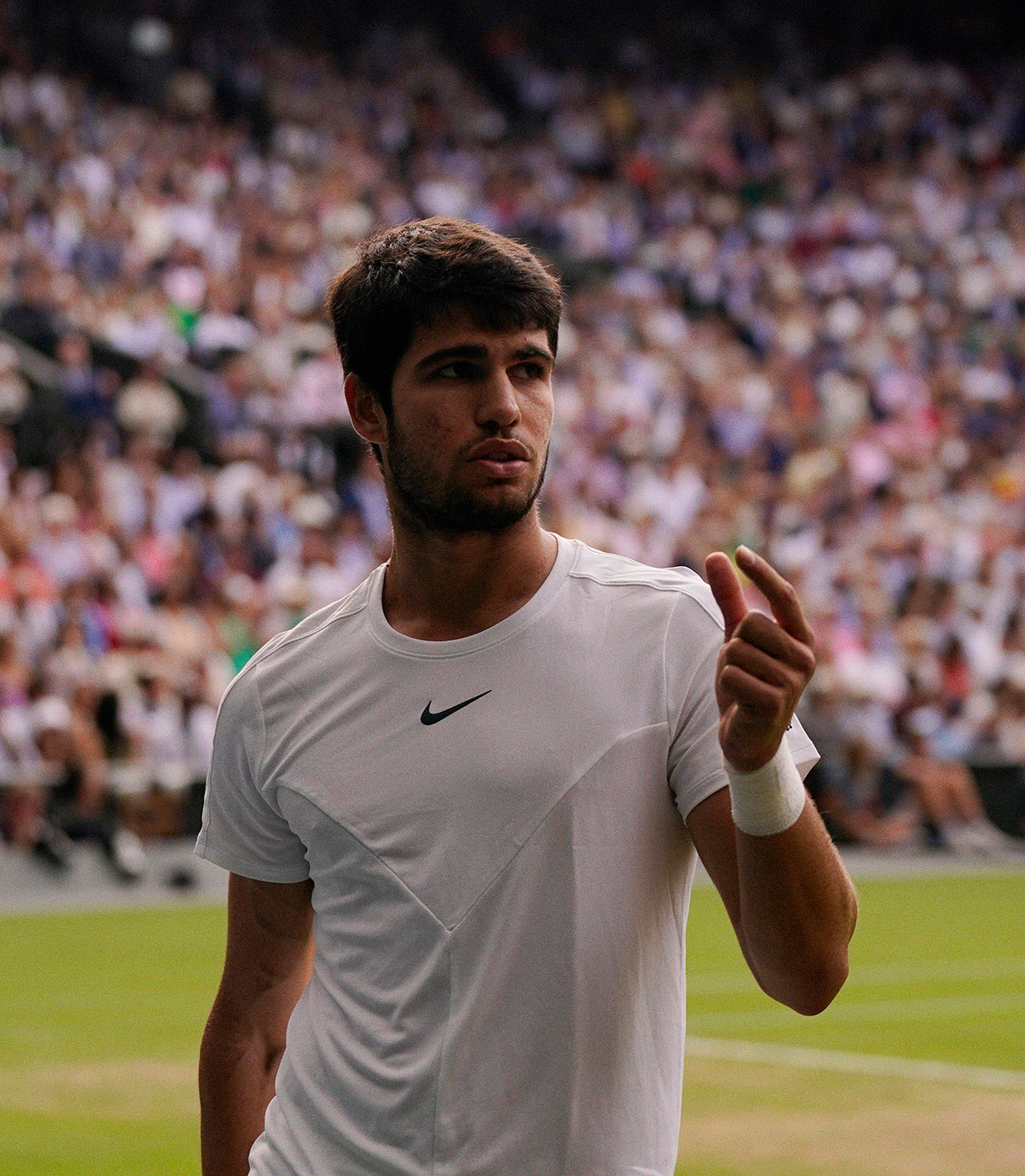
Will Carlitos have another season in the sun on the grass? // AP Images
Tennis is back on grass, with a fresh spring in its step. For the first time ever, both tours are led by No.1 and No. 2 players who were babies of the 2000s. And they are all entering their first-ever grass season as established major champs.
It was a week of mixed signals for Jannik Sinner. Last Friday he lost a cramp-riddled, high-stress, five-set Roland-Garros semifinal to his pal Carlos Alcaraz, as both players inflicted a special kind of suffering that only they can offer each other. And just days later, on Monday, Sinner was crowned world No. 1 for the first time, a testament to his world-beating play ever since he puked in Beijing last fall. Despite exiting clay season with no titles, and having abdicated his duties of national glorification in Rome, and mild ongoing concern around his hip injury, Sinner has clearly been the best player in the world over the past 52 weeks, and he now has the numeral to back that up. I liked the way Andre Agassi put it in his congratulations for the Italian: If the universe had a tennis tournament, Earth would pick Jannik as its representative. For Sinner, this grass season will be a fascinating test of form. He is a radically different player than he was this time last year, and that dusty obsolete version still made the Wimbledon semifinals. The Sinner of present is an elite server, who patched up the biggest deficiency in his game with alarming thoroughness, winning a tour-best 91 percent of his service games over the past 52 weeks. Right now he might have the most reliable serve-plus-one in the world, and a staple diet of quick, low-impact points could be his key to grass success this year. I would expect his watery 14–10 career record on the surface to look very different a month from now.
Meanwhile, Carlos Alcaraz, the new world No. 2, will be trying to achieve the rare Roland-Garros–Wimbledon double, which would establish him as the modern master of the natural surfaces. If he doesn’t nail that combo this year, it is inevitable that he will someday, and perhaps even multiple times over. Carlitos has the relevant tools, all the improvisational gifts, and the adaptable movement style, switching from daring slides to careful pitter-patter with fluency. I get the sense that he could play on a court that was clay on the deuce side and grass on the ad side and do just fine. Compared with Sinner, Alcaraz has made less obvious advances since last season—this Roland-Garros was, more than anything, proof that he can win a major over the current field without ever operating in top gear for a whole match—but the player Alcaraz was last season was already good enough to dispatch a seven-time Wimbledon champion in the final. So we will see what madness he conjures up this time around. Last year he studied some YouTube videos of Roger Federer and Andy Murray footwork on grass and proceeded to go 12–0 on the surface. Maybe this time he’ll boot up some John Isner clips (please don’t watch any John Isner clips, Carlitos) and go unbroken during the tournament. As far as skill acquisition goes, I’m not sure we’ve ever seen this kind of prodigy before.
As these new names come into focus, the old ones go fuzzy. Rafael Nadal has announced that “the best for my body is not to change surface and keep playing on clay” until the Olympics. Although Rafa has been very sparing with the word “last,” he has confirmed that these Olympics will be his last. Instead of grass he will be preparing for the ATP 250 at Bastad, a tournament he has not played since he won it as an 18-year-old in 2005. In the years since, Nadal has been too busy going deep at Wimbledon to go back. As he did not get much match play in Roland-Garros, he has some warming up to do for the Olympics, which will take place on the very same clay courts, and where he will be playing doubles—pause this sentence to issue the loudest possible “VAMOS”—with his successor Carlitos. One much more consequential grass-court absence is Novak Djokovic, who has yet to officially rule it out but is evidently still recovering from injury. In a classic session of Djokovic-ing, he tamped down Francisco Cerundolo in their fourth-round match at Roland-Garros, despite going down a break in the fifth set, and despite taking a few falls on the slippery patches behind the baseline on Court Philippe Chatrier (which Alcaraz also complained about). Afterward it was revealed that he had won the match with a torn right meniscus, which is a testament to the power of painkillers and of Novak Djokovic’s mind. He withdrew from the tournament, got surgery in Paris, and was reportedly seen this week in Belgrade walking without crutches but with a limp. Hard to imagine that he is keen to hop right onto some slippery grass and defend last year’s Wimbledon runner-up, when the Olympics lie ahead and a gold medal is pretty much the only tennis achievement that has ever eluded him.
Beyond the marquee names, grass season is also time to consider its native species, the players who, like me, wish there were another few weeks of turf. (Grass-court joint 1000-level remains very high on my wish list.) It’s prime time for your Humbert, your Hubert. At top of mind is Alexander Bublik, who was returned to the ideal habitat for his huge serves, touch shots, and overpowering disgust for drawn-out tennis matches. Bublik won his first title on grass last year in Halle, playing the tennis of his life to eliminate Andrey Rublev in that final. This week he’s onto the quarterfinals in Stuttgart after eliminating the promising Serbian 20-year-old Hamad Medjedovic. Also through to the quarters in Stuttgart is a name that used to loom large in every grass season: Matteo Berrettini, who has had a stop-and-start year on tour. First there was a six-month layoff with an ankle injury, and then a runner-up at a Challenger in Phoenix, followed by a brief visit to muggy Miami where he almost fainted on court during a loss to Andy Murray, and then a tournament win on clay in Marrakesh, only for him to then pull out of the majority of the clay season. Though he was relatively old at the time of his breakthrough, Berrettini is still just 28 years old and has looked sharp moving through his first two rounds at Stuttgart, a tournament he has won twice before. The Berrettini serve-and-forehand, backed up by a bit of slice, are good enough to unseat most opponents on the surface. Last year at Wimbledon he took out Alex de Minaur and Sascha Zverev before losing to Alcaraz in four. I wouldn’t be surprised if he can still make a little noise over the next month, even though the top of the tour has reconfigured itself in its absence.

The Hopper
—Taylor Swift personally congratulated Iga Swiatek on her Roland Garros victory (as the champ withdraws from Berlin.)
—Carlitos and Rafaelitos will be playing doubles together at the Olympics.
—French Open coverage is moving to TNT
—Andy Murray has thoughts on Wimbledon’s match scheduling.
—Sports Illustrated’s owner is suing its former publisher.
—The Defector Tennis Bureau says goodbye to Roland-Garros and takes aim at a tennis news aggregation account.


